Inseego NVWT1114 Wireless Router with cellular voice and data capabilities User Manual Verizon LTE Internet and Home Phone User Guide
Novatel Wireless Inc Wireless Router with cellular voice and data capabilities Verizon LTE Internet and Home Phone User Guide
Inseego >
Contents
User Manual

User Guide
LTE INTERNET AND HOME PHONE

©2016 Novatel Wireless, Inc. All rights reserved. The information contained in this document is subject to change
without notice and should not be construed as a commitment by Novatel Wireless, Inc.
Patents and Licenses
Visit www.novatelwireless.com/patents for a complete list of all Novatel Wireless patents.
Software License
Proprietary Rights Provisions:
The software drivers provided with this product are copyrighted by Novatel Wireless and/or Novatel Wireless’ suppliers.
Although copyrighted, the software drivers are unpublished and embody valuable trade secrets proprietary to Novatel
Wireless and/or Novatel Wireless’ suppliers. The disassembly, decompilation, and/or Reverse Engineering of the software
drivers for any purpose is strictly prohibited by international law. The copying of the software drivers, except for a reasonable
number of back-up copies is strictly prohibited by international law. It is forbidden by international law to provide access
to the software drivers to any person for any purpose other than processing the internal data for the intended use of the
software drivers.
U.S. Government Restricted Rights Clause:
The software drivers are classied as “Commercial Computing device Software” and the U.S. Government is acquiring only
“Restricted Rights” in the software drivers and their Documentation.
U.S. Government Export Administration Act Compliance Clause:
It is forbidden by US law to export, license or otherwise transfer the software drivers or Derivative Works to any country where
such transfer is prohibited by the United States Export Administration Act, or any successor legislation, or in violation of the
laws of any other country.
Trademarks and Service Marks
Novatel Wireless is a trademark of Novatel Wireless, Inc., and the other trademarks, logos, and service marks (collectively the
“Trademarks”) used in this user manual are the property of Novatel Wireless or their respective owners. Nothing contained in
this user manual should be construed as granting by implication, estoppel, or otherwise, a license or right of use of Novatel
Wireless or any other Trademark displayed in this user manual without the written permission of Novatel Wireless or its
respective owners.
• Novatel Wireless, and the Novatel Wireless logo are all trademarks of Novatel Wireless, Inc.
• MiFi® and the MiFi logo are registered trademarks of Novatel Wireless, Inc.
• Microsoft and Windows are either registered trademarks or trademarks of Microsoft Corporation in the United States and/or
other countries.
• Apple®, Mac®, and Mac OS® are trademarks of Apple, Inc., registered in the U.S. and other countries.
• Linux® is the registered trademark of Linus Torvalds in the U.S. and other countries.
The names of actual companies and products mentioned in this user manual may be the trademarks of their respective
owners.
Novatel Wireless Revision History
Part Number Revision Description Date
90029259-002 R1 Initial release 19 Apr 2016
FCC ID: PKRNVWT1114
PN: 90026844-002_R1_MASTER_UG_T1114_VZW_041916
Please visit www.novatelwireless.com for the latest information about your device.
Contents
Getting Started ........................................................ 1
Overview. . . . . . . . . . . . . . . . . . . . . . . . . . . . . . . . . . . . . . . . . . . . . . . . . . . . . . . . . . . . . . . . . . . . . . . . . . . . . . . . . . . . 2
System Requirements. . . . . . . . . . . . . . . . . . . . . . . . . . . . . . . . . . . . . . . . . . . . . . . . . . . . . . . . . . . . . . . . . . . . 2
Components and Indicators. . . . . . . . . . . . . . . . . . . . . . . . . . . . . . . . . . . . . . . . . . . . . . . . . . . . . . . . . . . . . . . . . . 3
Status Indicators ......................................................................... 7
Power Management ......................................................................... 9
Caring for Your Router ......................................................................10
Using the LTE Internet and Home Phone . . . . . . . . . . . . . . . . . . . . . . . . . . . . . . . . . 11
Accessing the Network .....................................................................12
Getting Started. . . . . . . . . . . . . . . . . . . . . . . . . . . . . . . . . . . . . . . . . . . . . . . . . . . . . . . . . . . . . . . . . . . . . . . . . . . . . 13
Inserting and Charging the Battery. . . . . . . . . . . . . . . . . . . . . . . . . . . . . . . . . . . . . . . . . . . . . . . . . . . . . . 14
Removing the Battery. . . . . . . . . . . . . . . . . . . . . . . . . . . . . . . . . . . . . . . . . . . . . . . . . . . . . . . . . . . . . . . . . . . 14
Backup Battery Tips. . . . . . . . . . . . . . . . . . . . . . . . . . . . . . . . . . . . . . . . . . . . . . . . . . . . . . . . . . . . . . . . . . . . . 15
Installing the Optional Antenna . . . . . . . . . . . . . . . . . . . . . . . . . . . . . . . . . . . . . . . . . . . . . . . . . . . . . . . . . 16
Powering On and O ...................................................................18
Powering On .......................................................................18
Powering O .......................................................................18
Connecting Your Phone. . . . . . . . . . . . . . . . . . . . . . . . . . . . . . . . . . . . . . . . . . . . . . . . . . . . . . . . . . . . . . . . . 18
Initial Activation ....................................................................19
Using Your Phone After Initial Activation. . . . . . . . . . . . . . . . . . . . . . . . . . . . . . . . . . . . . . . . . . . . . . . . . 20
Making Calls ........................................................................ 20
Receiving Calls .....................................................................20
Voice Mail ..........................................................................20
Call Forwarding. . . . . . . . . . . . . . . . . . . . . . . . . . . . . . . . . . . . . . . . . . . . . . . . . . . . . . . . . . . . . . . . . . . . . 21
10-Digit Dialing. . . . . . . . . . . . . . . . . . . . . . . . . . . . . . . . . . . . . . . . . . . . . . . . . . . . . . . . . . . . . . . . . . . . . 21
Other Incompatibilities .............................................................21
Connecting to Your Router . . . . . . . . . . . . . . . . . . . . . . . . . . . . . . . . . . . . . . . . . . . . . . . . . . . . . . . . . . . . . . . . . . 22
Connecting Wi-Fi Devices ...............................................................22
Connecting Wired/Ethernet Devices. . . . . . . . . . . . . . . . . . . . . . . . . . . . . . . . . . . . . . . . . . . . . . . . . . . . . 24
Using Your Router After Setup. . . . . . . . . . . . . . . . . . . . . . . . . . . . . . . . . . . . . . . . . . . . . . . . . . . . . . . . . . . . . . . 25
Using the LTE Internet and Home Phone Display . . . . . . . . . . . . . . . . . . . . . . . . . . . . . . . . . . . . . . . . . 28
LTE Internet and Home Phone Settings .................................. 29
Managing Your Router . . . . . . . . . . . . . . . . . . . . . . . . . . . . . . . . . . . . . . . . . . . . . . . . . . . . . . . . . . . . . . . . . . . . . . 30
On the LTE Internet and Home Phone Display ............................................30
On the LTE Internet and Home Phone Web User Interface ................................31
Sign In .................................................................................32
Sign In .............................................................................32
Menu Panel. . . . . . . . . . . . . . . . . . . . . . . . . . . . . . . . . . . . . . . . . . . . . . . . . . . . . . . . . . . . . . . . . . . . . . . . . 33
Home ......................................................................................34
On the LTE Internet and Home Phone Display ............................................34
iii
On the LTE Internet and Home Phone Web User Interface ................................35
Manage My LTE Internet and Home Phone. . . . . . . . . . . . . . . . . . . . . . . . . . . . . . . . . . . . . . . . . . . 36
My Account & Tools . . . . . . . . . . . . . . . . . . . . . . . . . . . . . . . . . . . . . . . . . . . . . . . . . . . . . . . . . . . . . . . . . 38
Help & Support . . . . . . . . . . . . . . . . . . . . . . . . . . . . . . . . . . . . . . . . . . . . . . . . . . . . . . . . . . . . . . . . . . . . . 39
Data Usage. . . . . . . . . . . . . . . . . . . . . . . . . . . . . . . . . . . . . . . . . . . . . . . . . . . . . . . . . . . . . . . . . . . . . . . . . . . . . . . . . 40
On the LTE Internet and Home Phone Display ............................................40
On the LTE Internet and Home Phone Web User Interface ................................41
Wi-Fi Name/Password. . . . . . . . . . . . . . . . . . . . . . . . . . . . . . . . . . . . . . . . . . . . . . . . . . . . . . . . . . . . . . . . . . . . . . . 42
On the LTE Internet and Home Phone Display ............................................42
Connected Devices . . . . . . . . . . . . . . . . . . . . . . . . . . . . . . . . . . . . . . . . . . . . . . . . . . . . . . . . . . . . . . . . . . . . . . . . . 43
On the LTE Internet and Home Phone Display ............................................43
On the LTE Internet and Home Phone Web User Interface ................................44
Connected Devices .................................................................45
Blocked Devices ....................................................................48
Voice Signal ................................................................................50
On the LTE Internet and Home Phone Display ............................................50
On the LTE Internet and Home Phone Web User Interface ................................50
Data Signal . . . . . . . . . . . . . . . . . . . . . . . . . . . . . . . . . . . . . . . . . . . . . . . . . . . . . . . . . . . . . . . . . . . . . . . . . . . . . . . . . 51
On the LTE Internet and Home Phone Display ............................................51
On the LTE Internet and Home Phone Web User Interface ................................51
Battery . . . . . . . . . . . . . . . . . . . . . . . . . . . . . . . . . . . . . . . . . . . . . . . . . . . . . . . . . . . . . . . . . . . . . . . . . . . . . . . . . . . . . 52
On the LTE Internet and Home Phone Display ............................................52
On the LTE Internet and Home Phone Web User Interface ................................52
Settings ....................................................................................53
On the LTE Internet and Home Phone Display ............................................53
Wi-Fi ...............................................................................56
Voice . . . . . . . . . . . . . . . . . . . . . . . . . . . . . . . . . . . . . . . . . . . . . . . . . . . . . . . . . . . . . . . . . . . . . . . . . . . . . . . 59
Device .............................................................................62
Advanced ..........................................................................66
About . . . . . . . . . . . . . . . . . . . . . . . . . . . . . . . . . . . . . . . . . . . . . . . . . . . . . . . . . . . . . . . . . . . . . . . . . . . . . . . . . . . . . . 76
On the LTE Internet and Home Phone Display ............................................76
On the LTE Internet and Home Phone Web User Interface ................................77
Internet Status. . . . . . . . . . . . . . . . . . . . . . . . . . . . . . . . . . . . . . . . . . . . . . . . . . . . . . . . . . . . . . . . . . . . . . 77
Device Info .........................................................................79
Diagnostics. . . . . . . . . . . . . . . . . . . . . . . . . . . . . . . . . . . . . . . . . . . . . . . . . . . . . . . . . . . . . . . . . . . . . . . . . 80
LTE Network ........................................................................82
Logs ................................................................................84
Customer Support . . . . . . . . . . . . . . . . . . . . . . . . . . . . . . . . . . . . . . . . . . . . . . . . . . . . . . . . . . . . . . . . . . . . . . . . . . 86
Troubleshooting . . . . . . . . . . . . . . . . . . . . . . . . . . . . . . . . . . . . . . . . . . . . . . . . . . . . . . . 88
Overview. . . . . . . . . . . . . . . . . . . . . . . . . . . . . . . . . . . . . . . . . . . . . . . . . . . . . . . . . . . . . . . . . . . . . . . . . . . . . . . . . . . 89
Common Problems and Solutions . . . . . . . . . . . . . . . . . . . . . . . . . . . . . . . . . . . . . . . . . . . . . . . . . . . . . . . . . . . 90
Technical Support ..........................................................................93
Technical Support ......................................................................93
iv
Product Specications and Regulatory Information ...................... 94
Product Specications ......................................................................95
General ................................................................................95
Technology/Bands. . . . . . . . . . . . . . . . . . . . . . . . . . . . . . . . . . . . . . . . . . . . . . . . . . . . . . . . . . . . . . . . . . . . . . 95
Environmental. . . . . . . . . . . . . . . . . . . . . . . . . . . . . . . . . . . . . . . . . . . . . . . . . . . . . . . . . . . . . . . . . . . . . . . . . . 95
Regulatory Information . . . . . . . . . . . . . . . . . . . . . . . . . . . . . . . . . . . . . . . . . . . . . . . . . . . . . . . . . . . . . . . . . . . . . 96
Wireless Communications. . . . . . . . . . . . . . . . . . . . . . . . . . . . . . . . . . . . . . . . . . . . . . . . . . . . . . . . . . . . . . . . . . . 97
Limited Warranty and Liability ..............................................................98
Safety Hazards. . . . . . . . . . . . . . . . . . . . . . . . . . . . . . . . . . . . . . . . . . . . . . . . . . . . . . . . . . . . . . . . . . . . . . . . . . . . . . 99
Proper Battery Use and Disposal ...........................................................101
Glossary. . . . . . . . . . . . . . . . . . . . . . . . . . . . . . . . . . . . . . . . . . . . . . . . . . . . . . . . . . . . . . 102

2
Overview
The LTE Internet and Home Phone is a wireless device that delivers Internet and phone service. You
can make a phone call and simultaneously provide network and Internet connectivity for up to
10 devices via Wi-Fi and up to 3 devices via Ethernet. Connect laptops, tablets, e-readers, gaming
consoles and more. **
System Requirements
•Compatible with all major operating systems.
•Works with the latest versions of browsers, including Android™, Google Chrome®, Firefox®,
Internet Explorer®, Safari® and Mobile Safari™.
To use Wi-Fi mode, your computer needs Wi-Fi capability. If your computer does not have Wi-Fi
capability you can use Ethernet.
Your LTE Internet and Home Phone must have a voice and/or data plan to function properly. You
must subscribe to an eligible Verizon Wireless Voice Only, Data Only or Voice and Data plan.
* When multiple users are connected to the LTE Internet and Home Phone, all of their data usage will be aggregated and applied
to the Verizon Wireless customer’s data allowance. A voice plan is not required to make E911 calls, but an external phone must
be connected to the router.
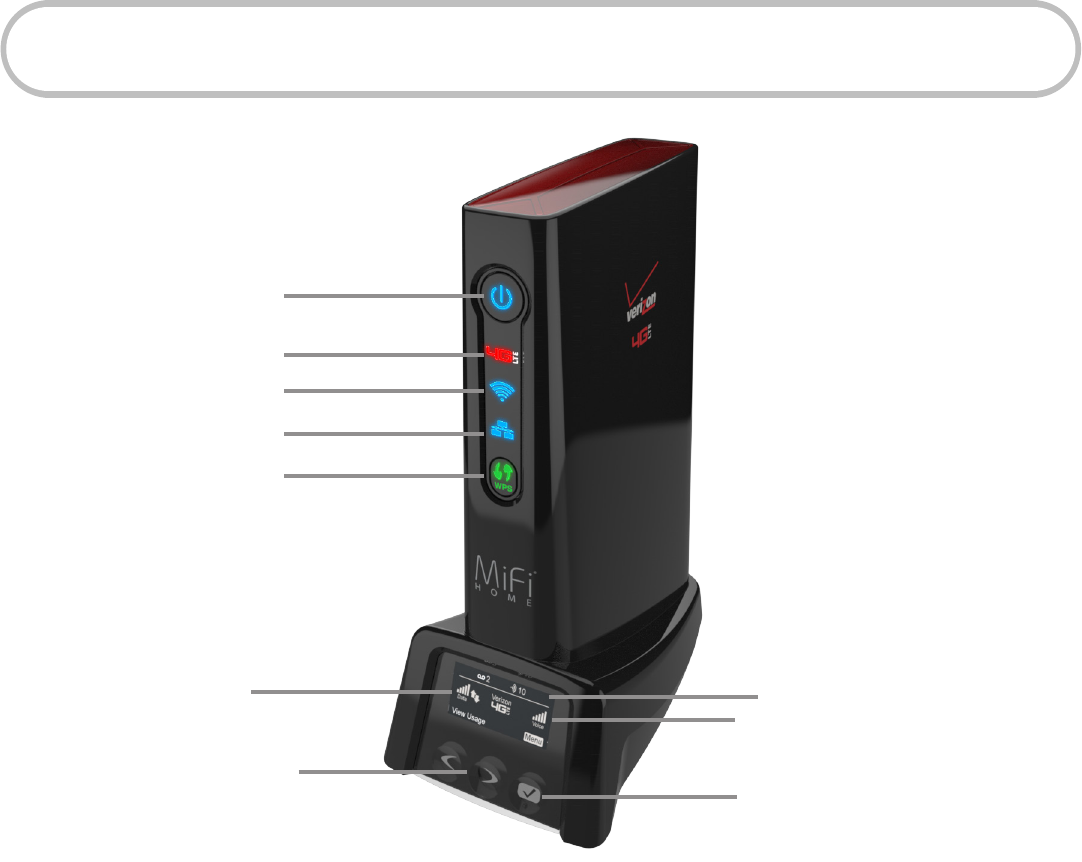
3
Components and Indicators
➊ Power on/off button — powers the router on and o.
➋ Internet indicator — displays internet availability.
➌ Wi-Fi indicator — displays status of Wi-Fi connections to the router.
➍ LAN indicator — displays status of Ethernet connections to the router.
➎ WPS button — allows devices to connect to the router using WPS and displays WPS
connection status.
➏ OLED display — displays connected devices, messages, network connection information,
and menu options.
➐ Scroll left/right — use to scroll and select the desired menu option.
➑ Select button — use to select a menu option.
➒ Network indicators — displays data and voice signal strength, network activity and roaming
status.
➓ Status bar — displays number of devices connected to the router via Wi-Fi and number of
new voice mail messages.
➊
➑
➋
➌
➍
➎
➐
➏
➒
➓
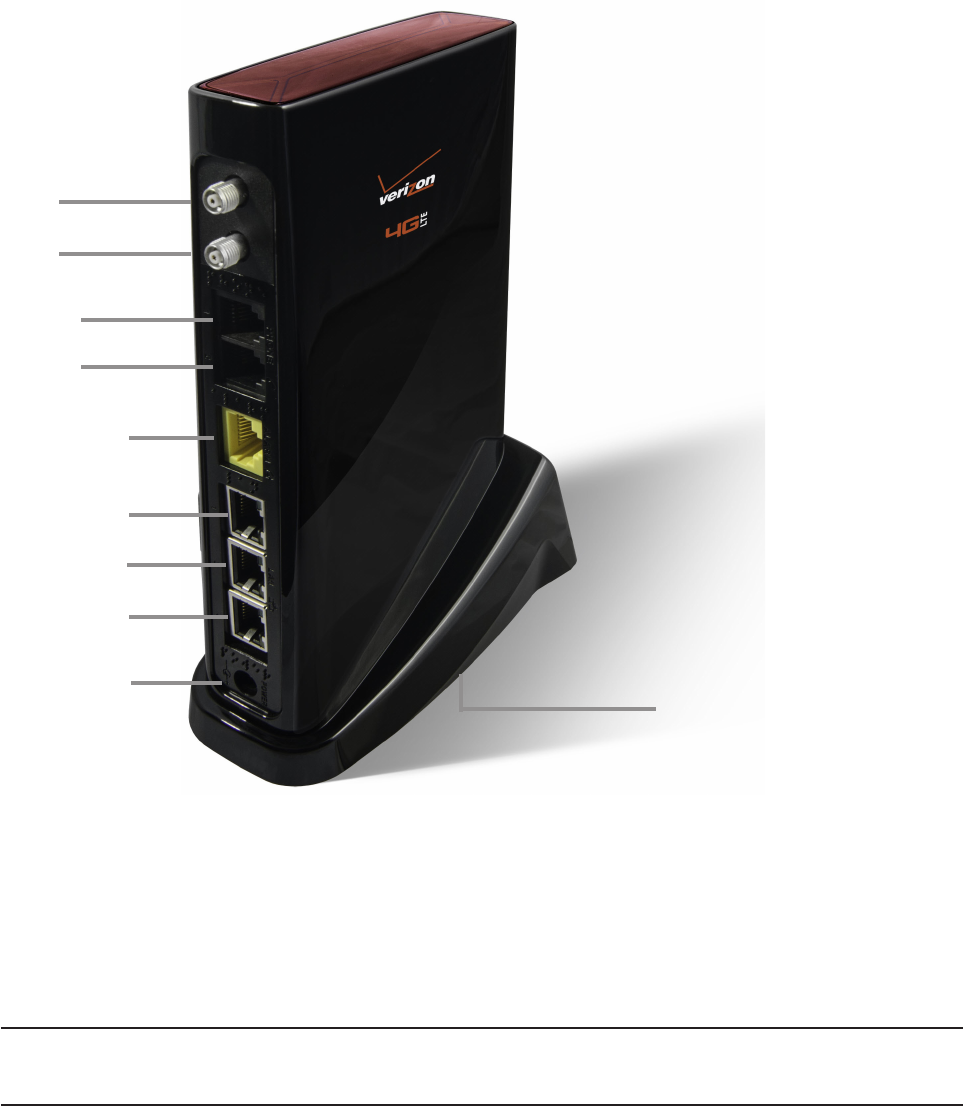
4
➊ Optional antenna* port 1 — optional antenna connection port
➋ Optional LTE antenna* port 2 — optional antenna connection port
➌ Phone port 1 (RJ-11) — phone connector port
➍ Phone port 2 (RJ-11) — phone connector port
➎ Home Security port (RJ-31) ** — Home Security connector port
WARNING ! Do not connect phone, fax or any other devices to the yellow port labeled ALARM. Doing
so may cause the phone to stop working.
➏ Ethernet port 1 — Local Area Network (LAN) connector port
➐ Ethernet port 2 — Local Area Network (LAN) connector port
➑ Ethernet port 3 — Local Area Network (LAN) connector port
➒ Power port — AC power connector port
➓ Battery cover — remove to access battery (not shown - on bottom of router)
* Sold separately
* * Future option
➊
➋
➌
➍
➎
➐
➑
➒
➏
➓
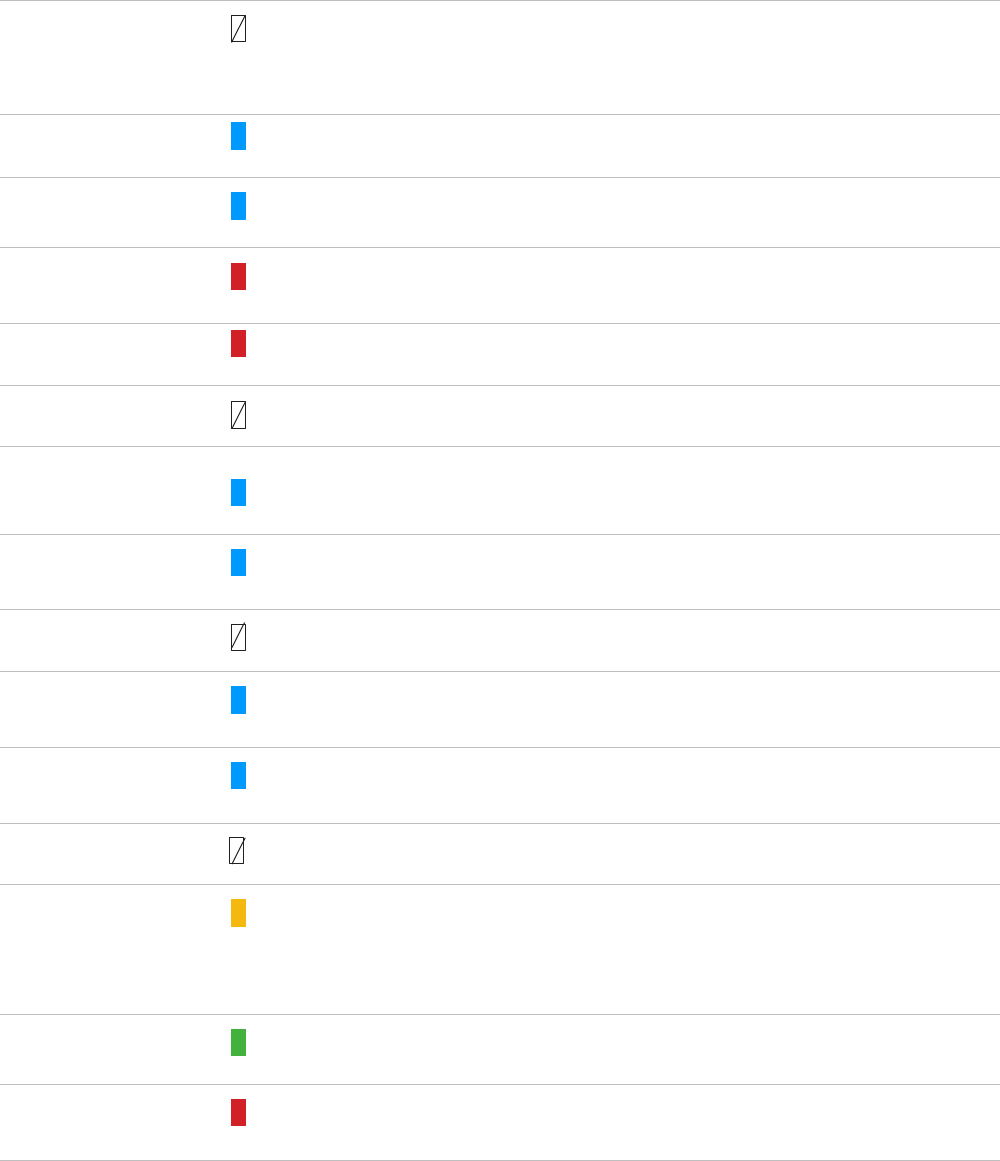
5
Indicator States
INDICATOR LED DESCRIPTION
All Unlit The LTE Internet and Home Phone is powered
o or not receiving power, or the screen is in
power-saving mode
Power button
Blue solid Normal operation
Blue blinking Battery is in Low Power Mode (LPM)
Red solid No AC power. Router operating on battery - only
voice service is available
4G Red solid Normal operation. Indicates Internet
connectivity
Unlit No connection (no data call). Indicates no
Internet connectivity
Wi-Fi indicator Blue solid Wi-Fi user(s) connected but not sending or
receiving data
Blue blinking Wi-Fi user(s) connected and sending or
receiving data
Unlit No user(s) connected via Wi-Fi
LAN indicator Blue solid User(s) connected via Ethernet but not sending
or receiving data
Blue blinking User(s) connected via Ethernet and sending or
receiving data
Unlit No user(s) connected via Ethernet
WPS button Amber blinking Searching for wireless devices to connect via
WPS. You have two minutes to start WPS on
the wireless device you want to connect to the
router
Green solid WPS connection successful
Red blinking Router could not nd a wireless device. Try
again to establish a WPS connection

6
Button Behavior
STARTUP
AC
Power
Battery Power Button Soft Key Buttons Behavior
OFF Not present N/A N/A Device not operational
ON Not present Long press* turns device ON
Short press** does nothing
Non-functional Display no battery message, then
shut down.
OFF Critically Low Long press turns device ON
Short press does nothing
Non-functional Display low battery message,
then shut down.
ON Critically Low Long press turns device ON
Short press does nothing
Non-functional Boot to online mode
OFF Long press turns device ON
Short press does nothing
Non-functional Boot to Voice-only mode
ON Red solid Non-functional Boot to online mode
LPM
Mode
Low Power
Mode
AC power connected but
user has not pressed power
button to start the device
N/A Power LED blinks blue - other
LEDs are OFF
Short press turns screen ON
Long press boots to online mode
OPERATION
Mode Screen Power Button Soft Key Buttons Behavior
Online OFF Short press turns screen ON
Long press turns device OFF
Short press turns screen
ON
Long press N/A
Any hardware button can wake
the screen
Online ON Short press turns screen OFF
Long press turns device OFF
Variable UI operates normally
Voice
only
OFF Short press turns screen ON
Long press turns device OFF
Short press turns screen
ON
User can toggle the screen ON or
OFF (only)
Voice
only
ON Short press turns screen OFF
Long press turns device OFF
Not functional User can toggle screen ON and
OFF
Softkeys can turn the screen ON,
but not turn it OFF
* Long press is 10 seconds
** Short press is 3 seconds
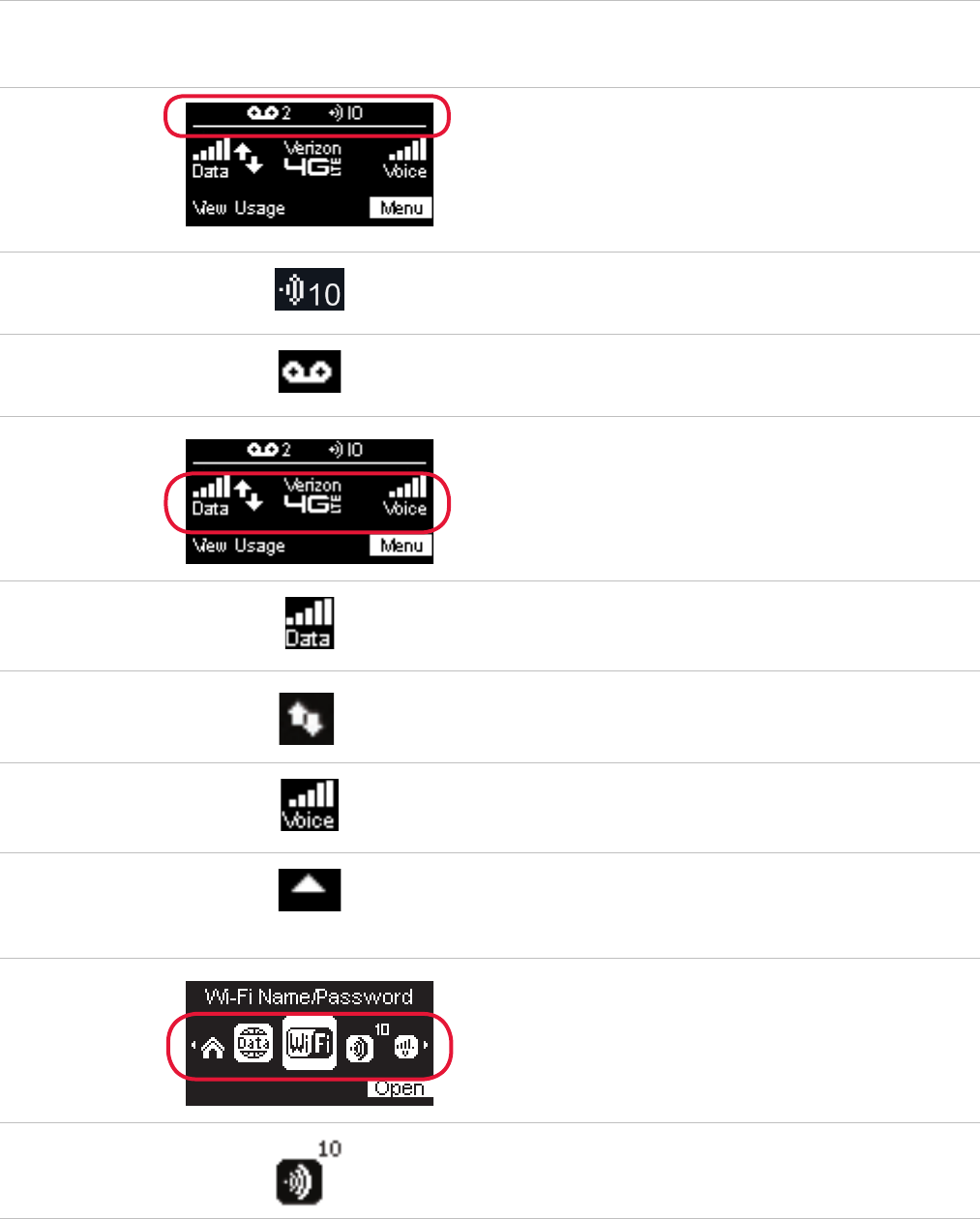
7
Status Indicators
DISPLAY ICON DESCRIPTION
No icons The LTE Internet and Home Phone is powered o, or the
screen is in power-saving mode
Status Bar
Connected devices Indicates the number of devices connected to the router via
Wi-Fi
Messages Indicates that a new voice mail message has been received
Network
Data signal strength*
indicator Displays signal strength for the data network - one to ve bars
Network activity
indicator
Displays when data is being transferred between your LTE
Internet and Home Phone and the network
Voice signal strength*
indicator
Displays the signal strength for the voice network - from one
to ve bars
Network roaming
indicator
Displays when the router is roaming and is connected to a
network other than the Verizon network
Menu
Connected devices Scroll and select this icon to display the number and IP
address of connected devices
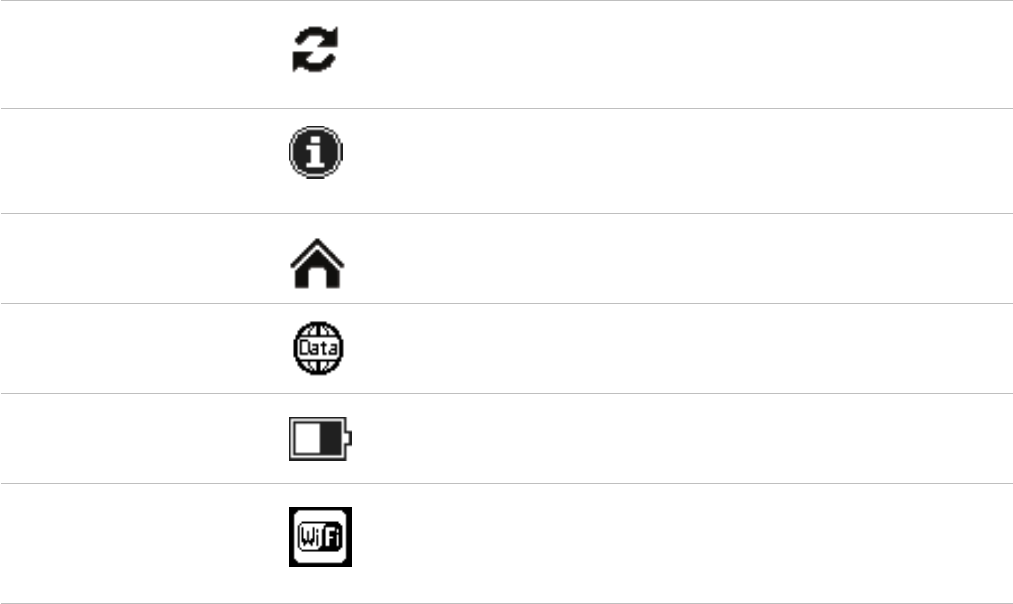
8
Software update Scroll and select this icon to display the current software
version, date and time of last check for updates and to check
for current software updates
About Scroll and select this icon to display the mobile number,
model number, IMEI, URL and Admin Password for your
LTE Internet and Home Phone
Home Scroll and select this icon to return to the LTE Internet and
Home Phone main display screen
Data Usage* Scroll and select this icon to view the amount of data used in
the current billing period
Battery More white on the battery indicates more battery life
Wi-Fi Name/Password Scroll and select this icon to display the Wi-Fi name (SSID),
password and web interface URL
* Available to customers who subscribe to an eligible data plan.

9
Power Management
Your LTE Internet and Home Phone will provide both voice and data service when the backup
battery is installed and the device is plugged into an AC power source.
•Backup Battery — Charge the backup battery by plugging the router into AC power. When
the battery is fully charged, the battery icon on the display carousel is solid. If only battery
power is being used, data service is not available.
•AC Wall Charger — You can use the router when the battery is installed and the charger is
plugged into a wall outlet. Please ensure the wall outlet is located near the router and is
easily accessible. The backup LTE Internet and Home Phone battery charges while the router
power cord is plugged into an AC outlet.
Factory Operation
When disconnected from AC power and operating on backup battery power, only voice service will
be available.*
Before using the LTE Internet and Home Phone, read the battery safety information in the "Safety
Hazards" section of this guide. (See Proper Battery Use and Disposal on page 101.)
* Voice and data availability dependent upon the selected Verizon service plan. A phone that does not require separate electric
power to operate is required to place or receive calls (including 911) during a power outage.

10
Caring for Your Router
Like any electronic product, the LTE Internet and Home Phone must be handled with care to ensure
reliable operation. The following guidelines are recommended:
•Protect the router from liquids, dust, and excessive temperatures.
•Do not apply adhesive labels to the router as they may cause the router to potentially
overheat or alter the performance of the antenna.
•Store the router in dry and secure location when not in use.

12
Accessing the Network
4G LTE
With 4G LTE bandwidth (700 MHz) you can get the broadband speed you require for Internet
connectivity for your home, small oce or even a vacation destination. You can connect to the
Internet, access your corporate intranet, check your email and download attachments at speeds
that are up to 10 times faster than 3G*.
4G Mobile Broadband with LTE*
•Download: typical download speeds of 5-12 Mbps.
•Upload: typical upload speeds of 2-5 Mbps.
Wi-Fi 802.11a/b/g/n
•802.11a uses the 5.0 GHz peak data rate with a bandwidth of 54 Mbps.
•802.11b uses the 2.4 GHz peak data rate with a bandwidth of 11 Mbps.
•802.11g uses the 2.4 GHz peak data rate with a bandwidth of 54 Mbps.
•802.11n uses the 2.4 GHz or 5.0 GHz peak data rate with a bandwidth of 150 Mbps.
* Speeds shown are those published by Verizon Wireless, Inc. Actual throughput speed and coverage may vary.

13
Getting Started
To set up and use your LTE Internet and Home Phone for the rst time:
➊ Conrm your computer meets the minimum system requirements. (See System
Requirements on page 2.)
➋ Insert and charge the battery. (See Inserting and Charging the Battery on page 14.)
➌ Install the optional antenna, if desired. (See Installing the Optional Antenna on page 16.)
➍ Plug in the power adapter. (See Powering On and O on page 18.)
➎ Connect your phone(s). (See Connecting Your Phone on page 18.)
➏ Make a test voice call. (See Making Calls on page 20.)*
➐ Set up your voice mail account. (See Voice Mail on page 20.)*
➑ Connect your computer or other Wi-Fi enabled devices to the router using Wi-Fi. (See
Connecting to Your Router on page 22.)**
➒ Connect up to three devices via Ethernet. (See Connecting Wired/Ethernet Devices on
page24.)**
* Not applicable to Data plan only subscribers.
** Not applicable to Voice only subscribers.

14
Inserting and Charging the Battery
➊ Press your nger against the battery cover removal tab on the underside of the router, then
lift and remove the cover.
➋ Plug in and insert the battery, keeping the red cable to the center of the router and the
metal contacts facing up.
➌ Replace the battery cover by setting it on the router where the notches align, then press on
the cover until it clicks into place and is at across the entire bottom surface.
➍ Plug the AC power cord into the router power port on the back of the router.
➎ Plug the other end of the power cord into an appropriate electrical outlet.
CAUTION! Use only batteries and chargers with your LTE Internet and Home Phone that have
been approved by Verizon Wireless. Failure to use approved batteries and chargers may increase
the risk that your router will overheat, catch fire, or explode, resulting in serious bodily injury,
death, or property damage.
NOTE Device operation without the battery is not supported. If the battery is removed, the device will
shut down. If AC power is available, the “No battery” message is displayed, then the device will shut
down. If AC power is not available, the device wil immediately shutdown.
Removing the Battery
➊ Power o and unplug the router if applicable.
➋ Press your nger against the battery cover removal tab on the underside of the router, then
lift and remove the cover.
➌ Lift the battery to remove from the battery compartment.
➍ Carefully disconnect the battery cable from the battery plug.
IMPORTANT Whenever you remove or insert the battery, ensure your LTE Internet and Home
Phone is not connected to any device or power source. Never use tools, knives, keys, pens or any
type of object to force the battery cover open or to remove the battery. Using any of these types
of objects could result in puncturing the battery.

15
Backup Battery Tips
WARNING ! Always use approved batteries and chargers with your LTE Internet and Home
Phone. The warranty does not cover damage caused by non-approved batteries and/or chargers.
•It normally takes 2.5 to 3 hours to fully charge the backup battery with the power cord.
•Do not use sharp objects or excessive force or remove the battery, as this may damage the
router and the battery.
•Battery life depends on the network, signal strength, temperature, features, and accessories
you use.
•New batteries or batteries stored for a long time may take more time to charge.
•When charging your battery, keep it near room temperature.
•When storing your battery, keep it uncharged in a cool, dark, dry place.
•Never expose batteries to temperatures below -20°C (4°F) or above 60°C (140°F).
•Never leave the router in an unattended vehicle due to uncontrollable temperatures that
may be outside the desired temperature range for this router.
•Some batteries perform best after several full charge/discharge cycles.
•It is normal for batteries to gradually wear down and require longer charging times. If you
notice a change in your battery life, it is probably time to purchase a new battery.
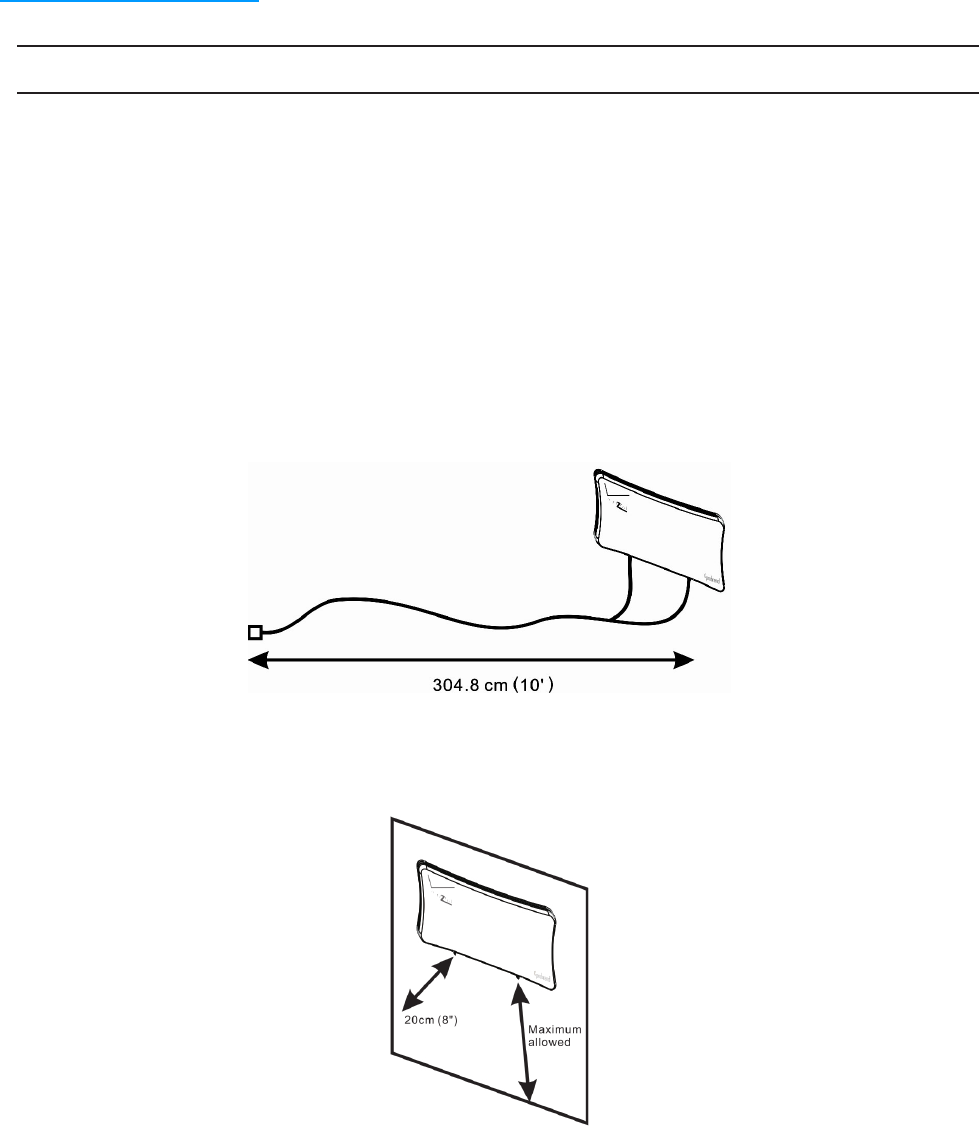
16
Installing the Optional Antenna
To purchase the optional ProBrand 4G LTE Signal Booster Antenna (PROB4GANT) for the LTE Internet
and Home Phone, please visit
www.verizonwireless.com or go to a Verizon Wireless store.
IMPORTANT INSTRUCTIONS Read before installation.
If using the optional antenna, align the antenna with the antenna port on the LTE Internet and
Home Phone and attach securely into place.
Use the following installation instructions to comply with FCC rules on RF exposure. Failure to follow
these guidelines can result in operations that exceed RF exposure limits.
•Maintain a minimum distance of at least 20 cm (8 in) from all persons regardless of how the
antenna is mounted (stand assembly or wall mount).
•Connect the antenna to the router using the supplied cable only – do not use a dierent
cable. Use the full length of the cable to position the antenna as far from the router and
generally populated areas as possible.
•For wall mount installations, position the antenna as far o the ground as possible ensuring
at least 20 cm (8 in) from people.
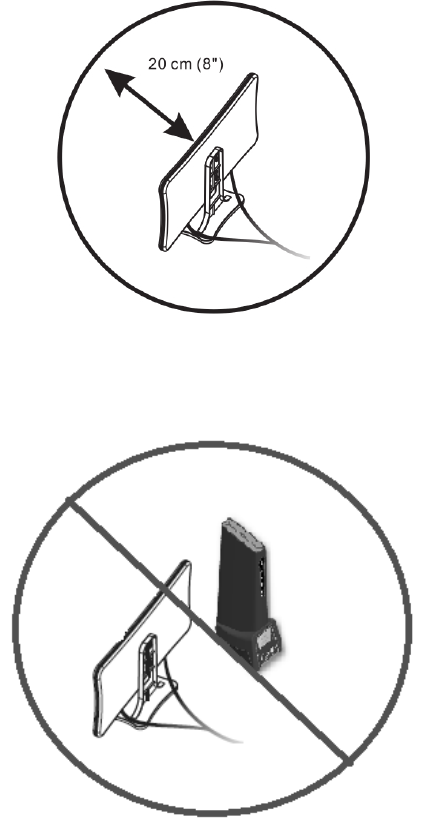
17
•For stand assembly installations, maintain a minimum distance of 20 cm (8 in) between the
antenna and people at all times.
•Do not operate the LTE Internet and Home Phone and the antenna within 5 cm (2 in) of each
other.
•Use only the approved ProBrand 4G LTE Signal Booster Antenna (PROB4GANT) available
through Verizon Wireless. Never use an antenna from another vendor or another source.
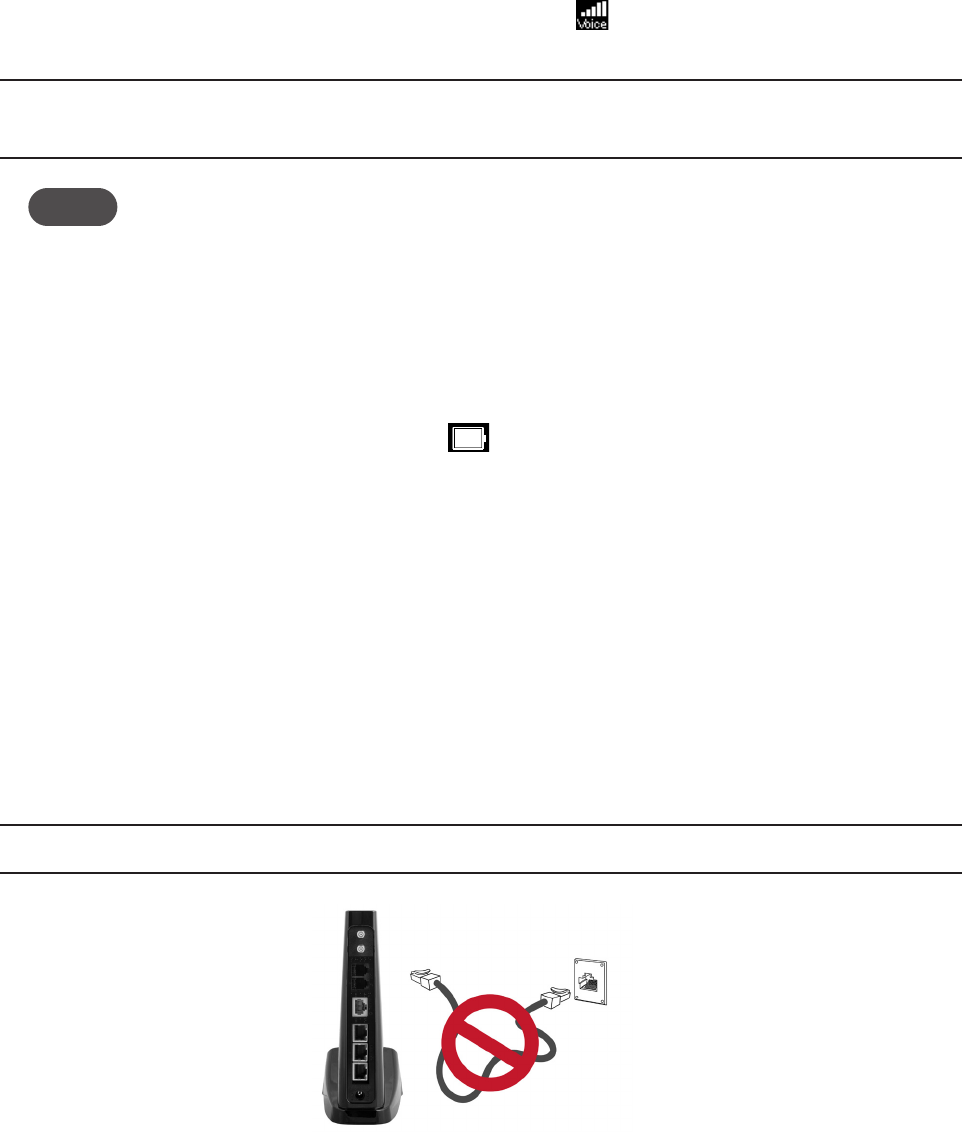
18
Powering On and O
Powering On
➊ Plug the power cord into the router power port.
➋ Plug the power adapter into an AC wall outlet. The router will power on automatically, and
guide you through a welcome process for connecting via Wi-Fi. When complete, ensure at
least two bars of the voice signal strength indicator ( ) is lit. If not, move the router to an
alternative location that provides a stronger signal.
WARNING! Be sure to use the power cord that came with your router to avoid damage that
may void the warranty.
NOTE If the router is disconnected from AC power and running on the battery alone, only voice calls are
supported. A phone that does not require separate electric power to operate is required to place or
receive calls (including 911) during a power outage.
Powering Off
➊ Press and hold the Power button until the display shows Verizon Powering Off. If the battery
is not fully charged, the router will begin operating in Charging Mode, and the screen will
display the battery charging indicator ( ). When the battery is fully charged, the router
will power o completely.
➋ To restart normal operation, press and hold the Power button until the display shows
MiFi® Powered.
Connecting Your Phone
The LTE Internet and Home Phone provides ports for up to two phones. Both ports use the same
phone number.
➊ Unplug your phone’s cord from your wall’s phone jack.
WARNING! Do NOT plug the LTE Internet and Home Phone into your phone wall jack.
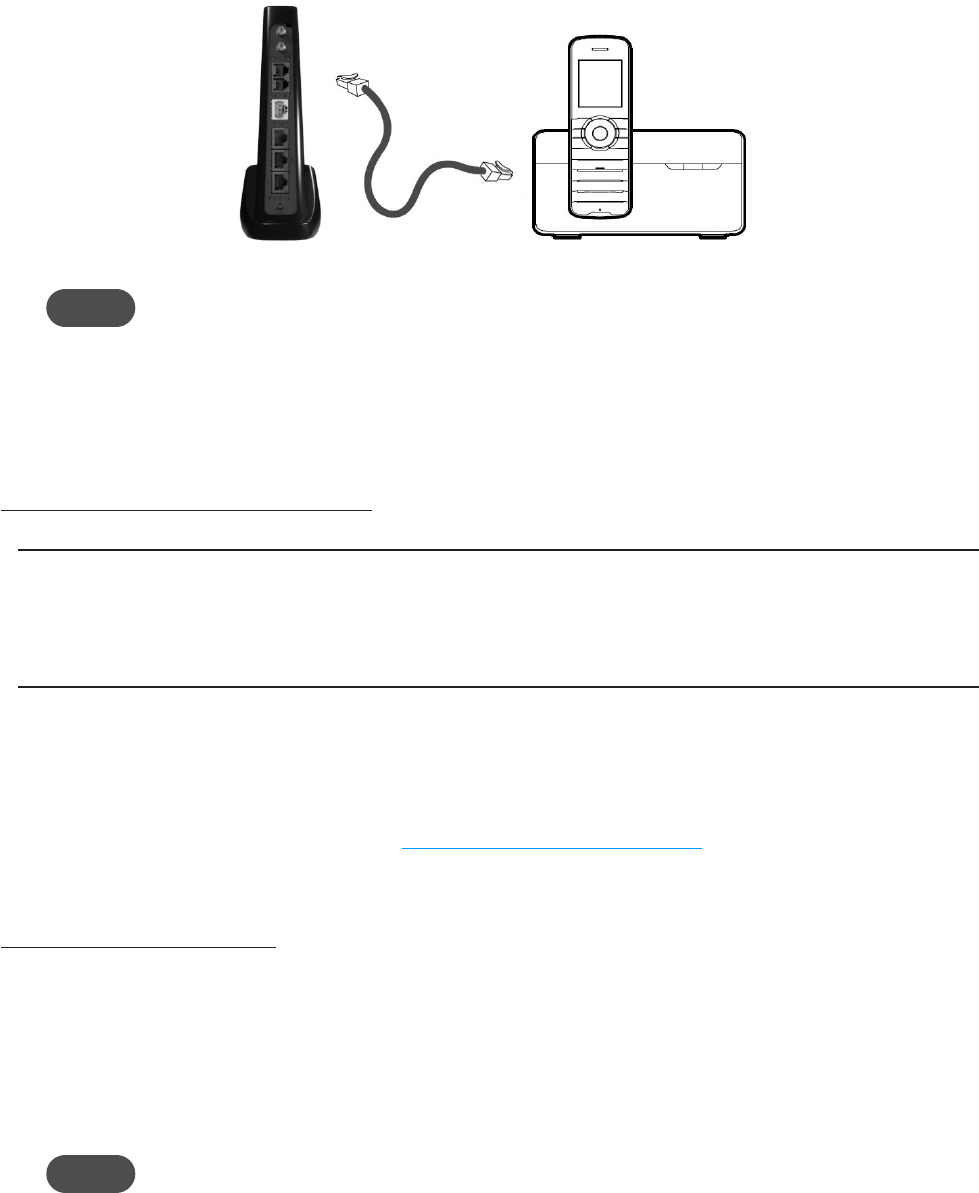
19
➋ Plug the end of the phone cord that was just removed from the wall jack into one of the two
phone ports on the back of the router. The other end of the cord must remain plugged into
the back of your phone’s base unit.
NOTE If the router is disconnected from AC power and running on the battery alone, only voice calls are
supported. A phone that does not require separate electric power to operate is required to place or
receive calls (including 911) during a power outage.
Initial Activation
Transferring Your Existing Number
IMPORTANT Customers transferring a phone number will not be able to receive calls on the
LTE Broadband Wireless Router with Voice until the transfer process is complete. This process can
take 2–10 business days and you will receive an email to the email address you provided when
your transfer is complete.
Once the transfer is complete, disconnect the phones attached to your home wall jacks. Connect
your phone(s) to the LTE Internet and Home Phone and power on. You will now be able to make and
receive calls through the phones connected to the router.
To check the status of your transfer, visit www.verizonwireless.com/lnp or call the Port Center at
(877) 567-4899.
Activating a New Number
Your router automatically activates the new number after the router is powered on, as long as
network coverage is available. Make a call to test service.
To display your new phone number:
•Select Menu and open the About option. The initial About screen displays your new mobile
phone number, the LTE Internet and Home Phone model, and the IMEI number.
NOTE A voice plan is required to make and receive calls. Your LTE Internet and Home Phone will require
10-digit dialing in most areas. Customers will typically need to use the three-digit Area Code when
dialing local and long distance numbers. If you are not subscribed to a plan with voice service and
would like to add this feature, dial *611 to sign up for service.

20
Using Your Phone After Initial Activation
Making Calls
Before making a call, make sure at least two of the voice signal strength indicators are lit.
➊ Place a call by entering the desired phone number, including area code.
➋ When your call is complete, hang up or return the phone to the receiver to ensure that you
can receive calls.
Receiving Calls
•For customers with a new phone number, simply share your new number with friends and
family. When they call, answer the phone connected to your LTE Internet and Home Phone.
•For customers that are transferring their current home number to the LTE Internet and Home
Phone, do not disconnect your existing home phone from the wall jack during the transfer
process.
•Incoming calls will continue to ring on your existing home phone until the transfer is
complete.
Voice Mail
Setting up Voice Mail
To set up and manage your voice mail, dial *86 and follow the system prompts. For more details
about your voice mail service, visit www.verizonwireless.com/voicemail.
Using Voice Mail
➊ The voice mail indicator ( ) and number of voice messages not yet listened to will
appear on the status bar of the LTE Internet and Home Phone display.
➋ Dial *86 to access your voice mail.
➌ Follow the system prompts to listen to and manage your voice mails.
NOTE Refer to the Troubleshooting section for additional instruction on accessing voice mail or using a
home phone answering machine as your preferred method to manage your voice messages.

21
Call Forwarding
Verizon LTE Internet and Home Phone allows customers to forward calls to another phone number,
including your mobile phone or oce number. Your home phone will not ring until you turn o the
service. Airtime applies to forwarded calls even if you send the call to landline phones.
To Turn on Call Forwarding
➊ Dial *72.
➋ Immediately enter the phone number where you want calls forwarded
(for example, *72-212-123-4567).
➌ You will hear a conrmation tone.
➍ Hang up your home phone or return the phone receiver to its base.
To Turn off Call Forwarding
➊ Dial *73.
➋ You will hear a conrmation tone.
➌ Hang up your home phone or return the phone receiver to its base.
10-Digit Dialing
Your Verizon LTE Internet and Home Phone will require 10-digit dialing in most areas, requiring
Customers to use the three-digit Area Code when dialing local and long distance numbers.
Other Incompatibilities
•Making or receiving collect, 500, 700, 900, 976, operator-assisted or dial-around
(e.g., 1010-XXXX) calls
•DSL or dial up Internet service
•DVR, Dish Network, and DirecTV
•Mobile merchant machines (credit card machines)
•Any type of PBX or Centrex system
•Medical or Life Alert dependencies
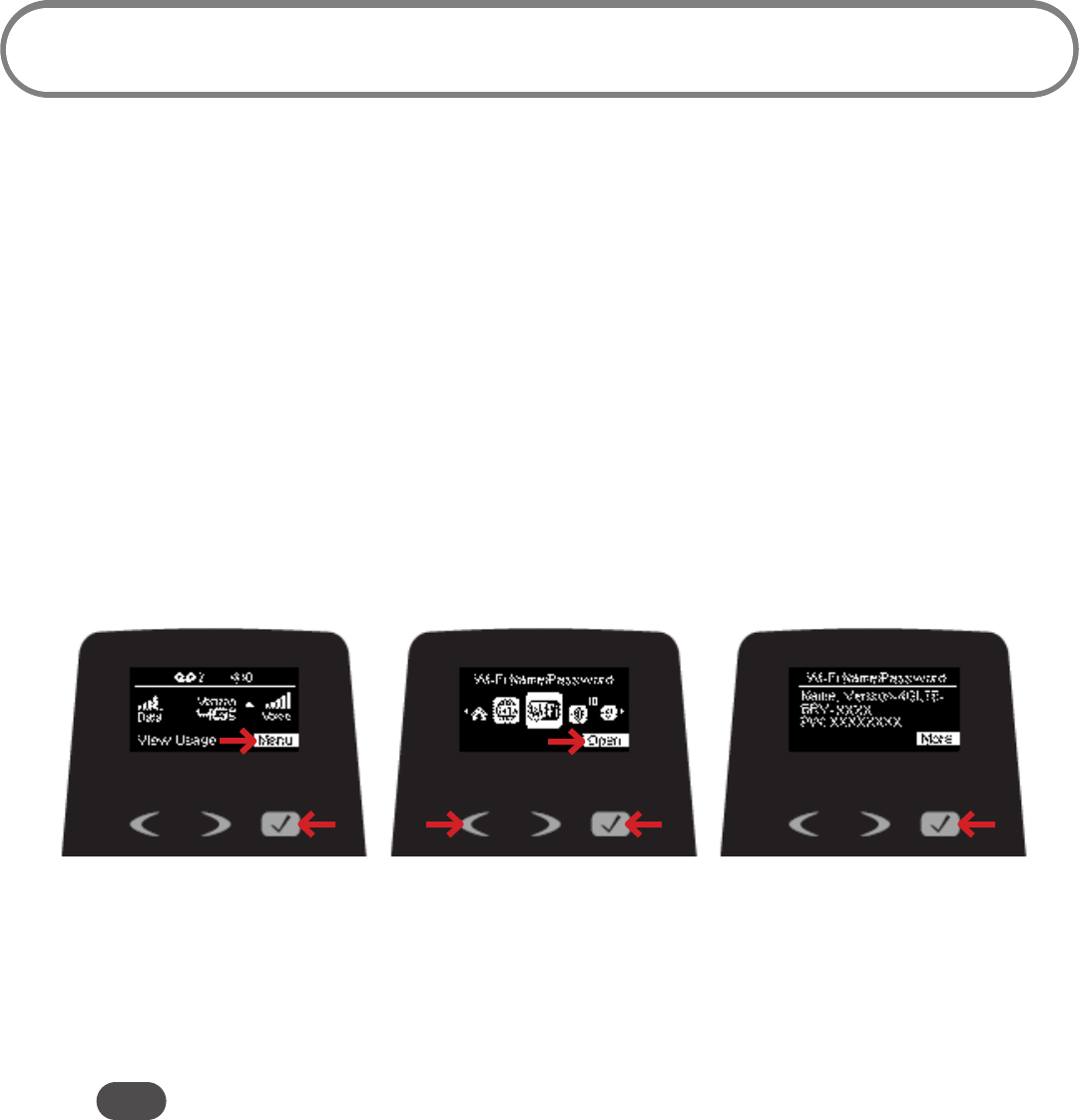
22
Connecting to Your Router
Connecting Wi-Fi Devices
You can connect to your LTE Internet and Home Phone with your computer, tablet or other
Wireless devices that have Wi-Fi and Internet browser software. Your LTE Internet and Home Phone
is compatible with all major operating systems, and works with the latest version of browsers,
including Android, Google, Chrome, Firefox, Internet Explorer, Safari and Mobile Safari. Your default
Wi-Fi Name (SSID) and Password can be found on the router display upon initial power up.
To access your Wi-Fi Name (SSID) and Password after the initial power up or a router reset:
➊ Power on your LTE Internet and Home Phone.
➋ Select Menu and open the Wi-Fi Name and Password option.
➌ Select Open to display the Wi-Fi Name/Password.
To connect to your router:
➊ Turn on your Wi-Fi capable device and connect your LTE Internet and Home Phone to AC
power. The router display will light up and broadcast its own wireless network and name.
➋ Open the Wi-Fi application or controls on the computer or Wi-Fi capable device that you
want to connect to your router and nd the Wi-Fi name (SSID).
Tip! The steps to connect to a Wi-Fi network vary depending on your operating system and whether
you use the native application or third-party software. Generally, with a PC you click an icon in the
Windows notification area where you can select View Available Wireless Networks, or click the
Airport icon in the menu bar on a Mac® computer. If you are unfamiliar with wireless networking on
your computer, consult the computer’s help system.
➌ When prompted, enter your Password, which can be found on the router display by pressing
the Select button (Menu) on the Home screen to display the Wi-Fi icon, then pressing the
Select button (Open) to display the Wi-Fi Name/Password screen. The router display should
now show an additional connected device. Your Wi-Fi capable device is now connected to
the Internet.
➍ Press and hold the Select button for 10 seconds to return to the Home screen.
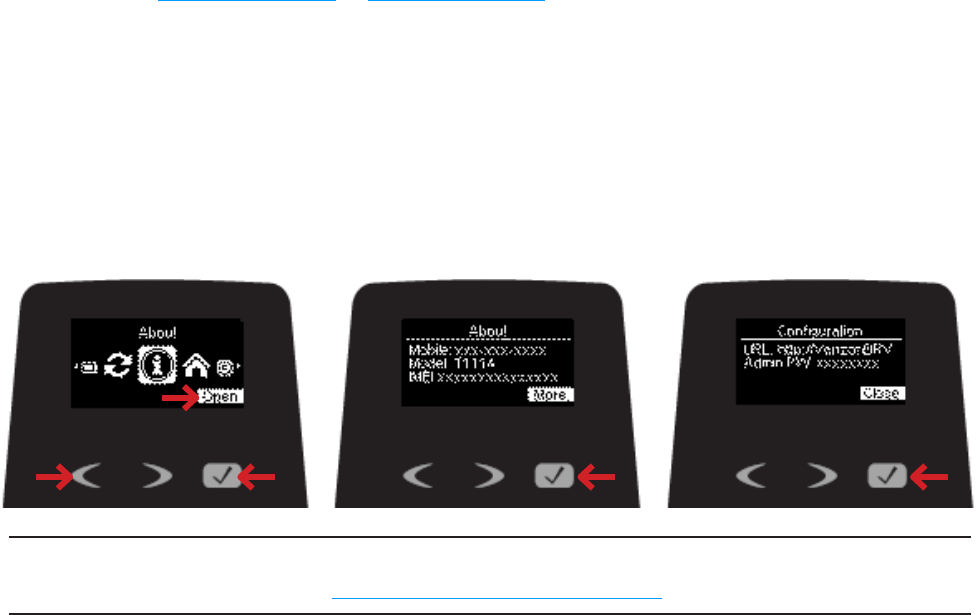
23
You can view or change LTE Internet and Home Phone settings by connecting to the router’s web
user interface at http://VerizonBRV or http://192.168.1.1.
To nd the Web User Interface URL and Admin Password on the LTE Internet and Home Phone’s
display:
➊ From the Home screen, select Menu to display the Menu options.
➋ Scroll to About and select Open > More to display the web interface URL and Admin
Password.
➍ Press and hold the Select button for 10 seconds to return to the Home screen.
IMPORTANT Charge the battery completely before you connect your computer to your LTE
Internet and Home Phone. (See Inserting and Charging the Battery on page 14.)

24
Connecting Wired/Ethernet Devices
You can connect up to three wired devices such as laptops, printers, and gaming consoles via
Ethernet.
➊ Plug the end of an Ethernet cable into one of the three Ethernet ports.
➋ The other end of the cable must remain plugged into the Ethernet port of the device you
wish to connect.
NOTE The Ethernet cables are sold separately.
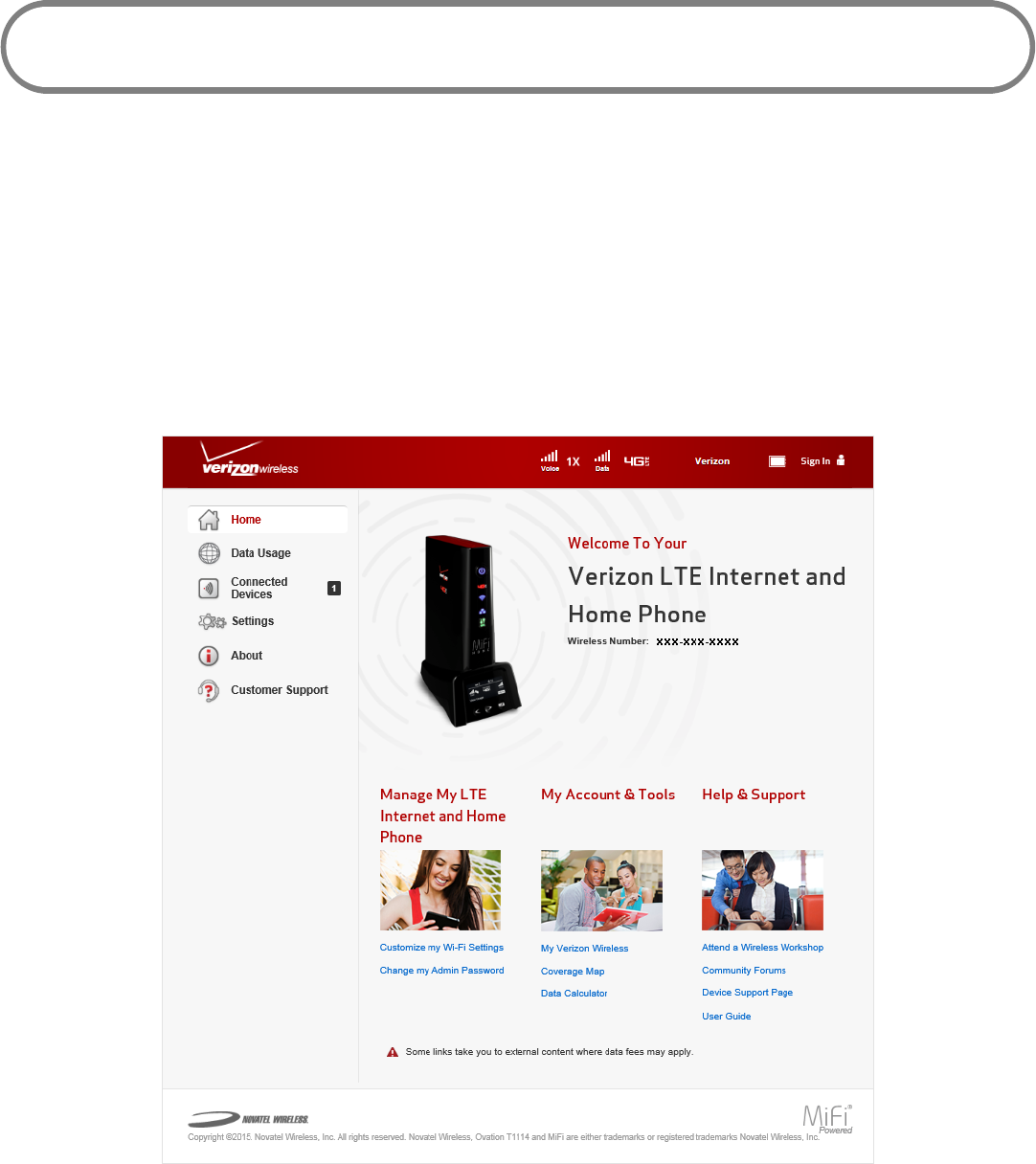
25
Using Your Router After Setup
You can use the LTE Internet and Home Phone to connect up to a total of 10 Wi-Fi capable devices
and three devices connected via Ethernet simultaneously to the mobile broadband network. The
router is powered on as soon as you plug it into AC power.
The LTE Internet and Home Phone comes from the factory with security settings turned on. You can
change the security settings using the Web User Interface.
To change your security settings:
➊ Open the web browser of a device connected to the LTE Internet and Home Phone and enter
http://VerizonBRV or http://192.168.1.1.
➋ Sign In with the Admin Password which can be found on the router display by selecting
Menu > Wi-Fi Name/Password.
➌ To change your Wi-Fi Name/Password, from the Web Interface Home page, select Manage
My LTE Internet and Home Phone > Customize my Wi-Fi Settings. By default, your Wi-Fi and
Admin Passwords are the same.
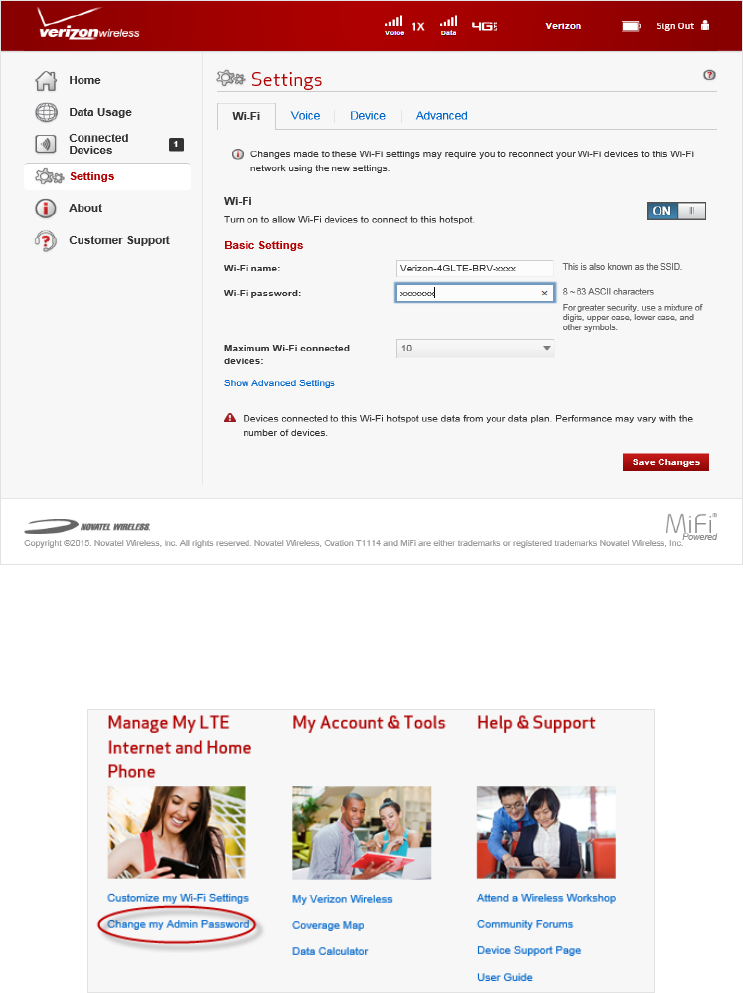
26
➍ Enter the new Wi-Fi Name in the Wi-Fi name eld and the new Wi-Fi Password in the Wi-Fi
password eld.
➎ Click Save Changes.
➏ To change your Admin Password from the Web User Interface Home page, select Manage My
LTE Internet and Home Phone > Change my Admin Password.
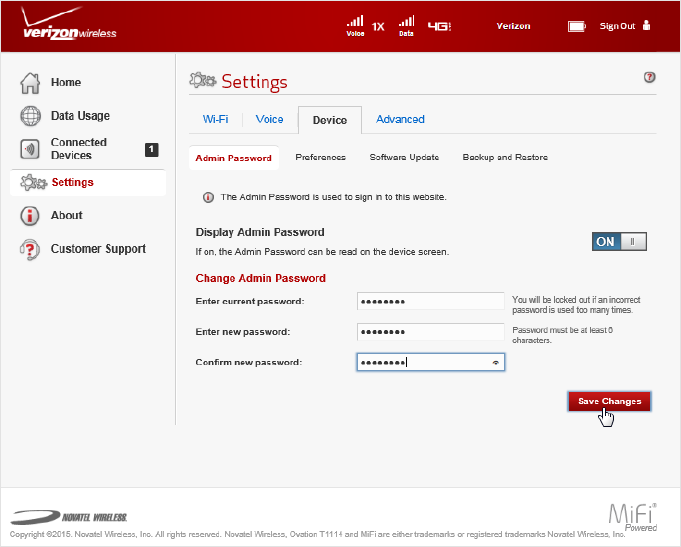
27
➐ Enter your current Admin Password in the Enter current password eld.
➑ Enter your new Admin Password in the Enter new password eld, and re-enter to conrm in
the Conrm new Admin password eld.
➒ Click Save Changes.
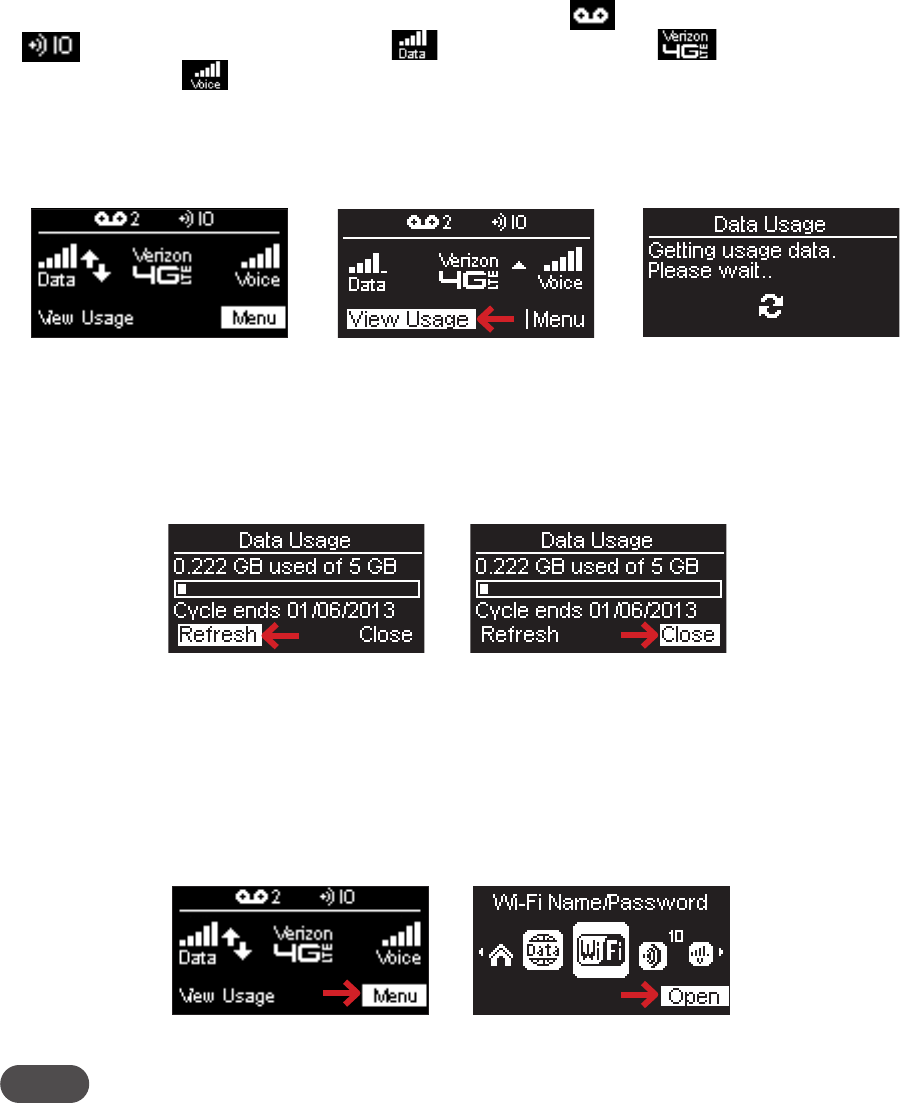
28
Using the LTE Internet and Home Phone Display
From the LTE Internet and Home Phone user display, you can check your device status, view your
current data usage, and access icon-based menu options if you subscribe to an eligible data only
or voice and data plan by using the Scroll and Select buttons. (See Components and Indicators on
page 3).
To view the current status of your device:
➊ Press the power button to display the Home Screen. The status bar is at the top of the screen.
➋ Check the status indicators for unread voice messages , number of connected devices
, network data signal strength , connected network , and network voice
signal strength .
To view your current data usage:
➊ Press the left scroll button to highlight View Usage.
➋ Press the select button. Current data usage in GB and billing cycle schedule displays on the
LTE Internet and Home Phone screen.
➌ Press the left scroll button to refresh, and press and hold the select button to close and
return to the Home screen.
To access the icon-based menu options:
➊ Press the select button to display the menu icons.
➋ Use the scroll buttons to move left or right to highlight the desired menu option, then press
the select button to open the highlighted option. Continue to press the select button to
move through any additional screens.
NOTE Display turns off after a period of non-use, which can be set to 30 sec, 1 min, 2 min, 5 min or Never
using Settings > Device > Preferences on the Web User Interface.
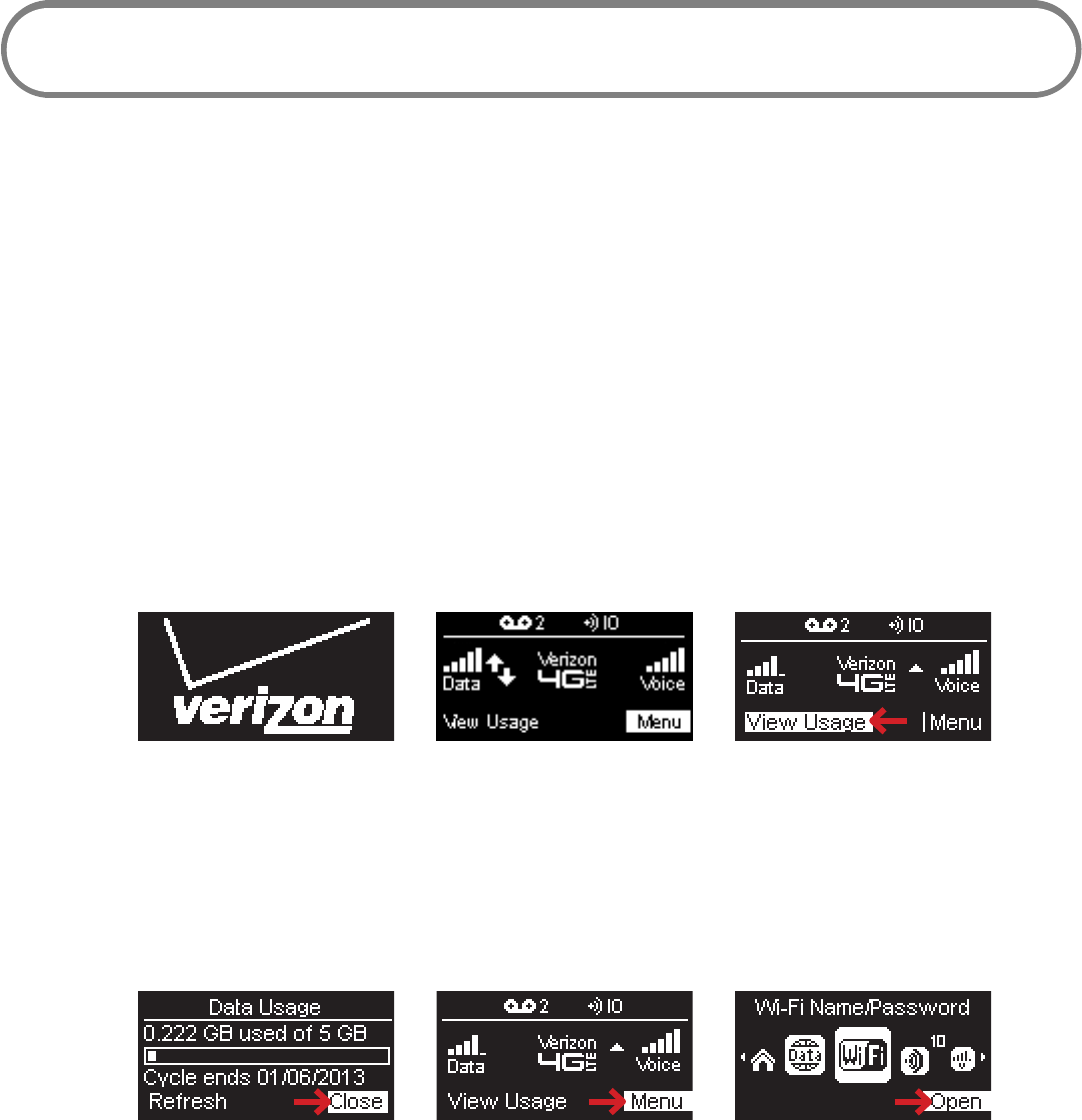
30
Managing Your Router
Manage, monitor, and customize your LTE Internet and Home Phone settings directly on the router,
or by using the Web User Interface.
On the LTE Internet and Home Phone Display
➊ Power on your LTE Internet and Home Phone by plugging the power cord into the router
power port, then plugging the power adapter into an AC wall outlet.
➋ Use the status display to monitor messages, connected devices, network activity, network
data and voice strength, and roaming status.
➌ From the Home screen, press the left scroll button to highlight View Usage, then press the
select button to display the Data Usage screen with your current data usage and billing cycle
schedule.
➍ Press and hold the select button to close the Data Usage screen and return to the Home
screen.
➎ Press the select button to display the Menu icons.
➏ Use the scroll buttons to scroll to the desired Menu option.
➐ Press the select button to open the selected Menu screen.
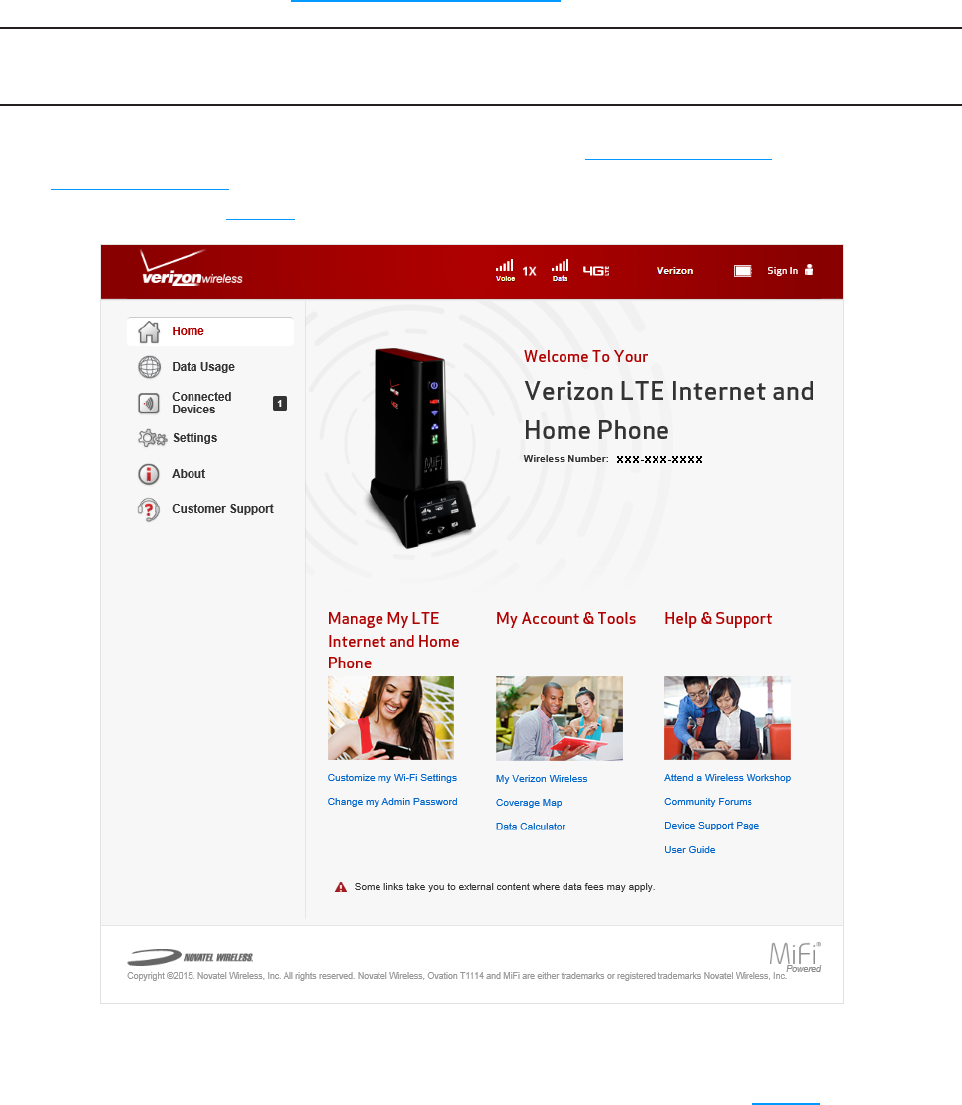
31
On the LTE Internet and Home Phone Web User Interface
To connect to the LTE Internet and Home Phone web interface and customize your router settings:
➊ Connect your computer or Wi-Fi capable device to your LTE Internet and Home Phone to
access the Internet.(See Connecting to Your Router on page 22.)
IMPORTANT You can only access the LTE Internet and Home Phone Web User Interface when
you are connected to the router.
➋ Open your connected device’s web browser and type http://VerizonBRV/ or
http://192.168.1.1 into the address bar. Press Enter. The LTE Internet and Home Phone Home
page opens. (See Sign In on page 32.)
➌ Click Sign In in the upper right corner of the window and type your Admin Password in the
Admin password eld and click Sign In to display the Home page. (See Sign In on page32.)
You are now able to customize your router settings conguration.
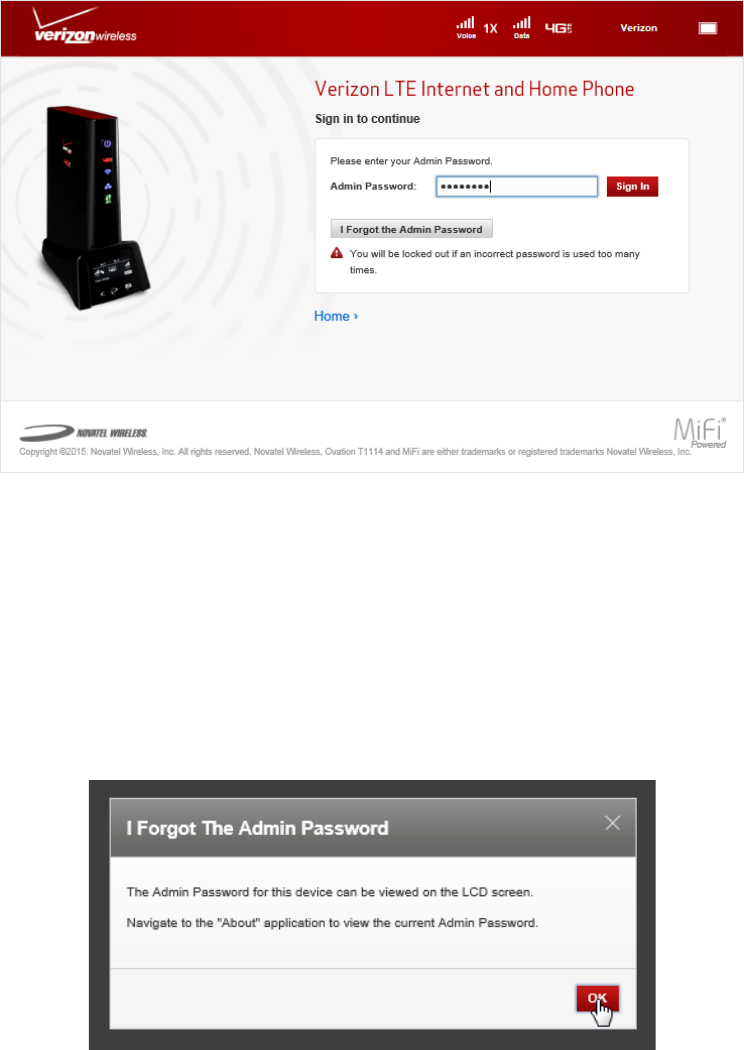
32
Sign In
The Sign In page is the rst page you see after connecting and prior to signing in. You can access
more information after you Sign In.
Sign In
Type the Admin Password (the default password is found on the router by scrolling to the About
icon and selecting Open > More > More to display the Admin Password) in the Sign In eld at the
top right corner of the window. Click Sign In.
If you forget your Admin Password, click I Forgot the Admin Password and a reminder will appear
telling you where to nd your password. Click OK.
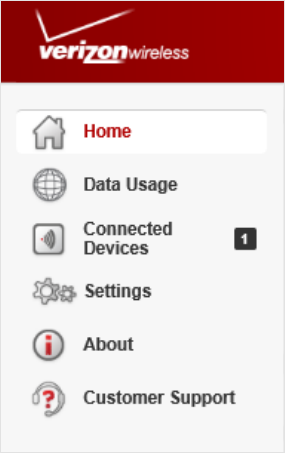
33
Menu Panel
The Menu Panel is the primary navigation for LTE Internet and Home Phone Settings. You can access
each feature under the appropriate menu.
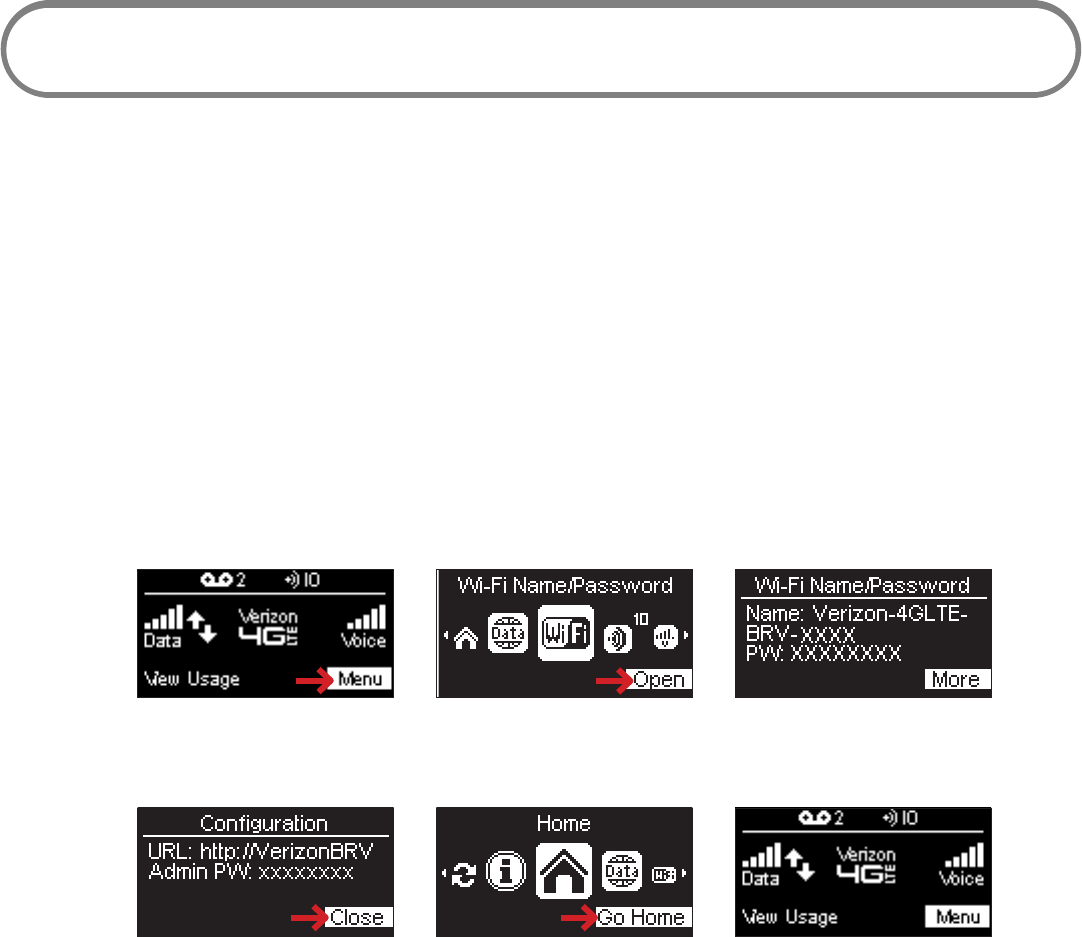
34
Home
The LTE Internet and Home Phone Home page is your gateway to conguring and managing your
router.
On the LTE Internet and Home Phone Display
➊ Power on your LTE Internet and Home Phone by plugging the power cord into the router
power port, then plugging the power adapter into an AC wall outlet.
➋ Press the select button to display the Menu icons.
➌ Use the scroll buttons to scroll to the desired Menu option.
➍ Press the select button to open the selected Menu option.
➎ To return to the Home screen, press the select button to close the selected Menu option,
then scroll to the Home icon and press the select button to Go Home.
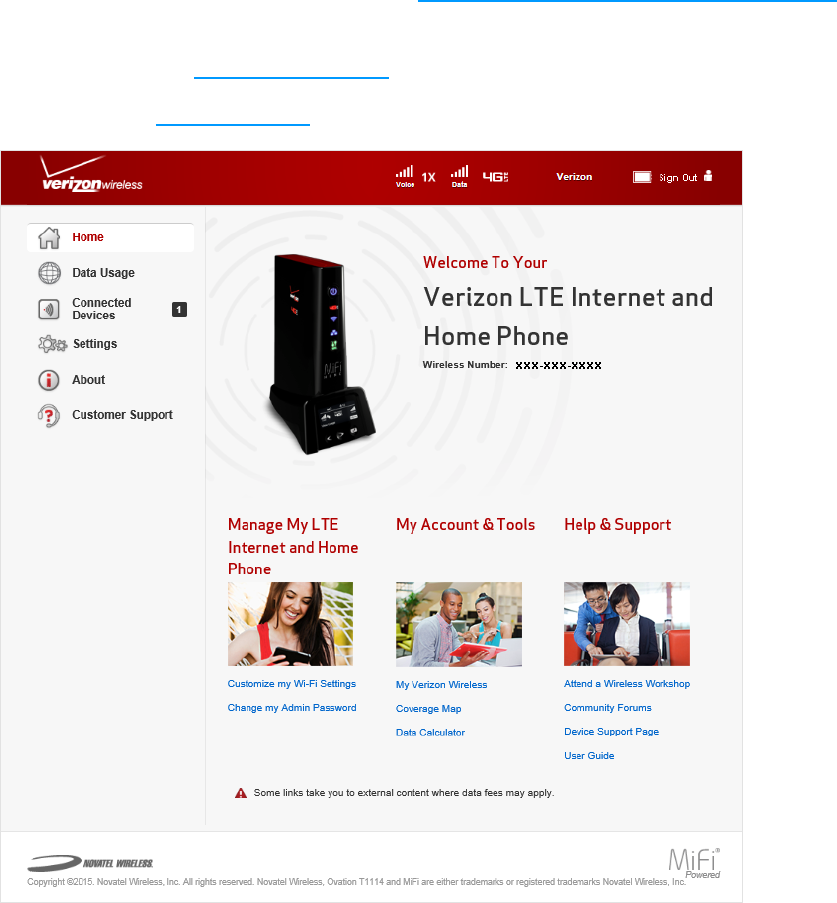
35
On the LTE Internet and Home Phone Web User Interface
The Home page allows you to quickly access commonly used links and all available menu options
for your router. The Home page contains the following quick link menu options:
•Manage My LTE Internet and Home Phone (See Manage My LTE Internet and Home Phone on
page 36.)
•My Account & Tools (See My Account & Tools on page 38.)
•Help & Support (See Help & Support on page 39.)
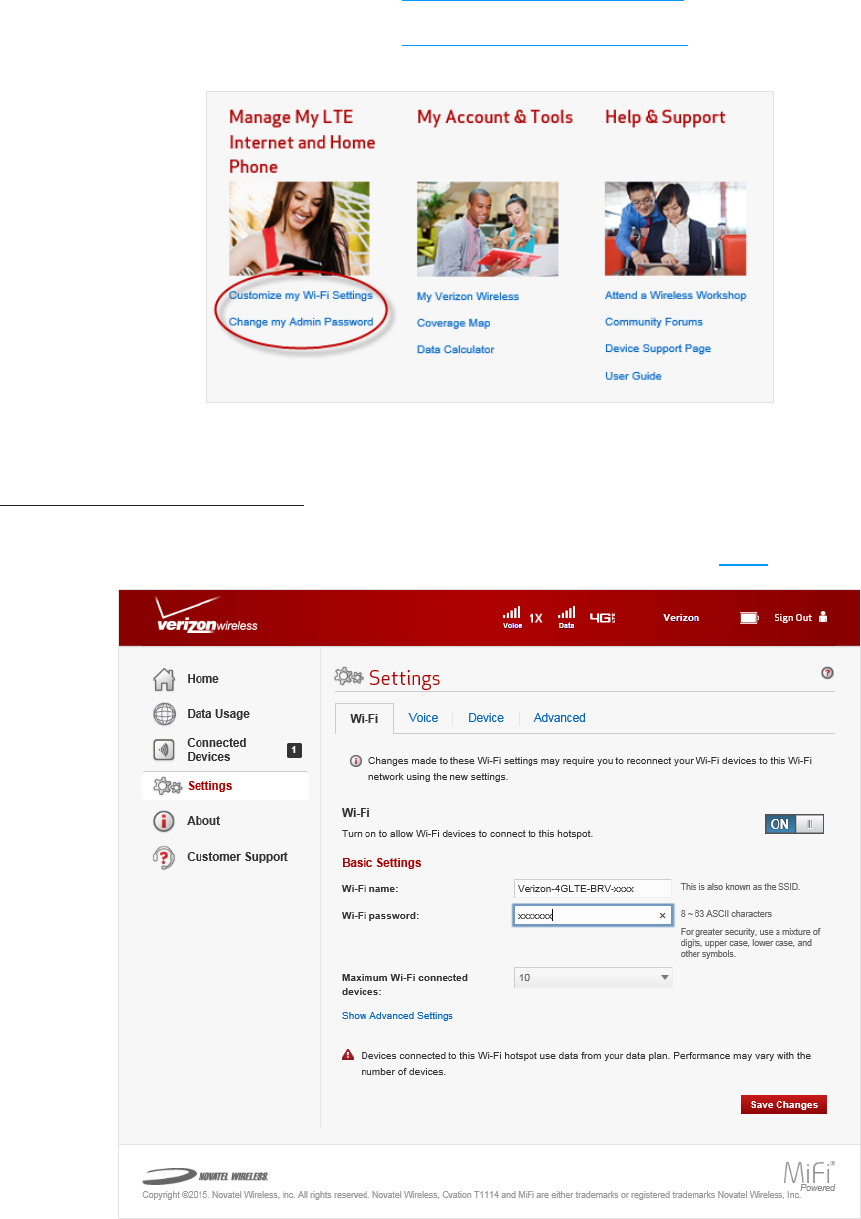
36
Manage My LTE Internet and Home Phone
The Manage My LTE Internet and Home Phone menu contains the following options:
•Customize my Wi-Fi Settings (See Customize my Wi-Fi Settings on page 36.)
•Change my Admin Password (See Change my Admin Password on page 37.)
Customize my Wi-Fi Settings
Clicking on Customize my Wi-Fi Settings will take you to the Settings page Wi-Fi menu, where you
can customize Wi-Fi proles for your LTE Internet and Home Phone. (See Wi-Fi on page 56.)
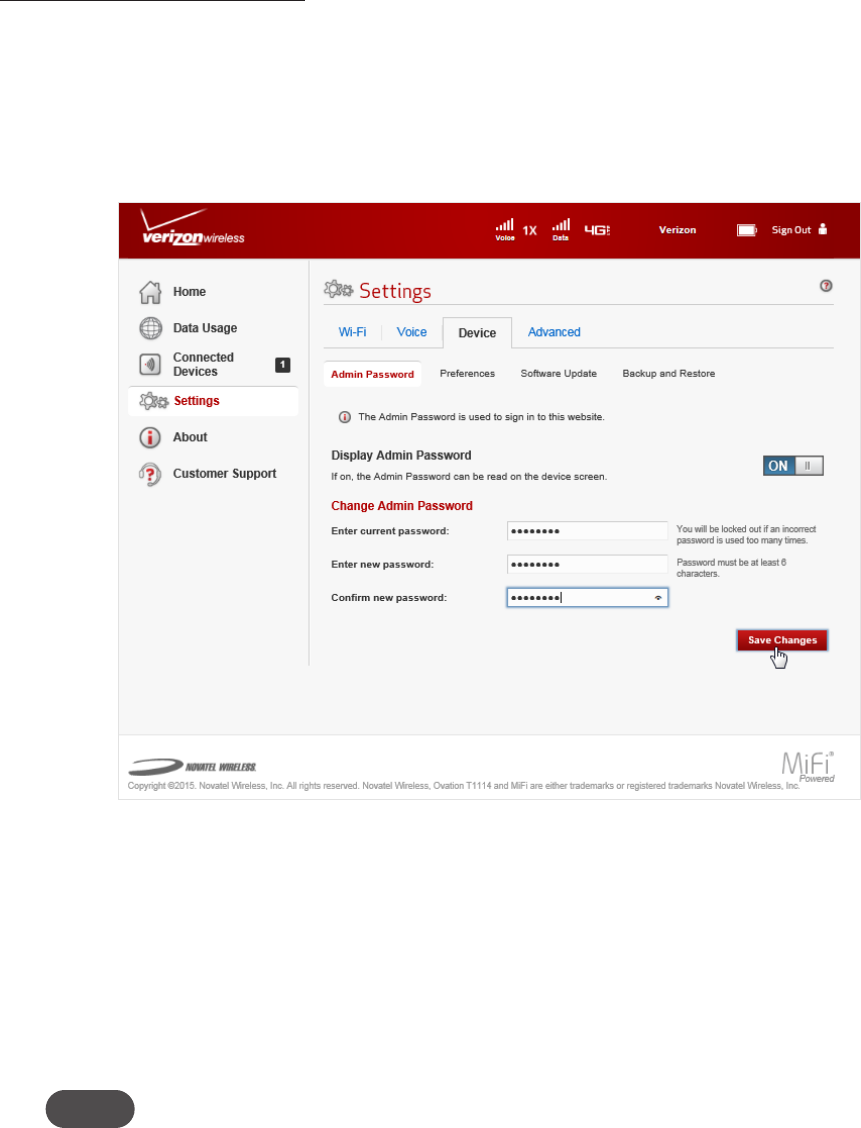
37
Change my Admin Password
Clicking on Change my Admin Password will take you to the Admin Password section of the Device
menu on the Settings page. The Admin Password page enables you to change the Admin Password.
This is the password you use to Sign In to the LTE Internet and Home Phone web interface.
To change the Admin Password used to Sign In to your router:
➊ Enter your current password in the Enter current password box.
➋ Enter your new password in the Enter new password box.
➌ Re-enter your new password in the Confirm new password box.
➍ Click Save Changes.
➎ A message displays conrming that your Admin Password has been changed.
Next time you Sign In to your LTE Internet and Home Phone, you need to use the new Admin
Password.
NOTE To recover a forgotten password, scroll to About > More > More on the router to display the URL and
Admin Password. If you have configured the router not to display the Admin Password on the router
display, you will need to reset the router.
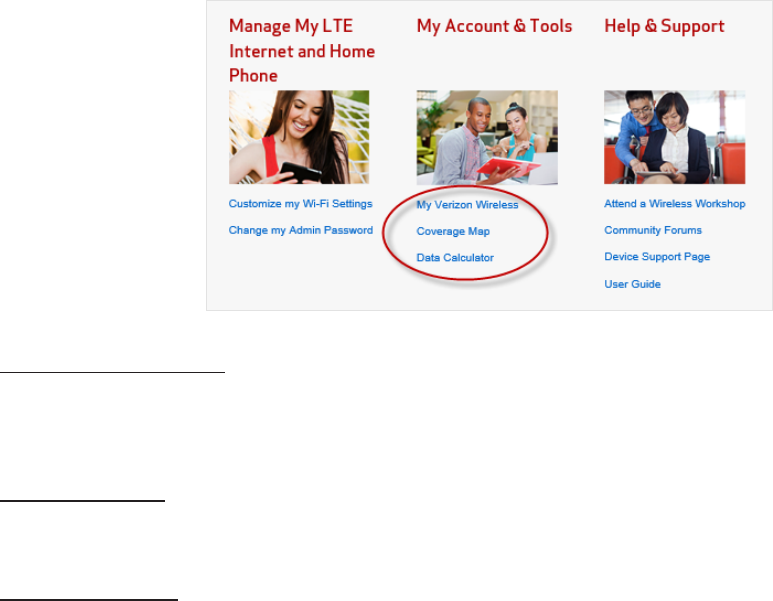
38
My Account & Tools
The My Account & Tools menu contains the following options:
•My Verizon Wireless
•Coverage Map
•Data Calculator
My Verizon Wireless*
My Verizon Wireless allows you to manage your account, pay your bill, purchase accessories and
more. Register at verizonwireless.com/myverizon.
Coverage Map*
Click on Coverage Map to access the Verizon Wireless coverage map.
Data Calculator*
Click on Data Calculator to calculate your data usage and select the best plan to meet your data
requirements.
* Using these links may count against your data usage
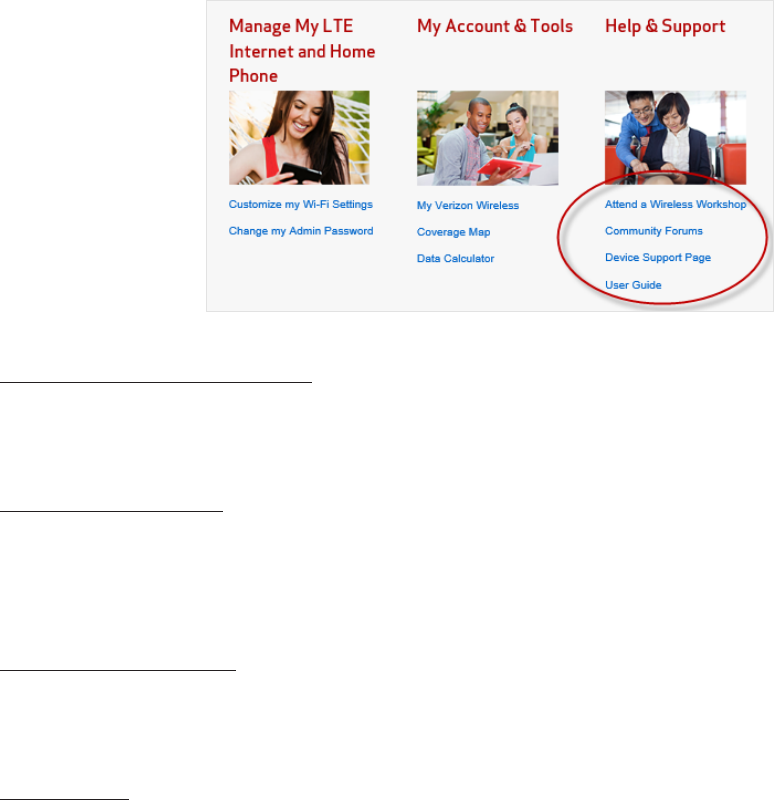
39
Help & Support
The Help & Support menu contains the following options:
•Attend a Wireless Workshop
•Community Forums
•Device Support Page
•User Guide
Attend a Wireless Workshop*
Click on Attend a Wireless Workshop to attend a free Wireless Workshop online or in a store to learn
everything you need to know about your LTE Internet and Home Phone.
Community Forums*
Click on Community Forums to follow, share and participate in the Broadband & Netbook
Community. In addition, you can search Broadband & Netbook Community discussions for specic
topics.
Device Support Page*
Click on Device Support Page to join and discuss the latest news in Verizon Wireless products,
services, and more.
User Guide*
Click on User Guide to access an online version of this LTE Internet and Home Phone User Guide.
* Using these links may count against your data usage
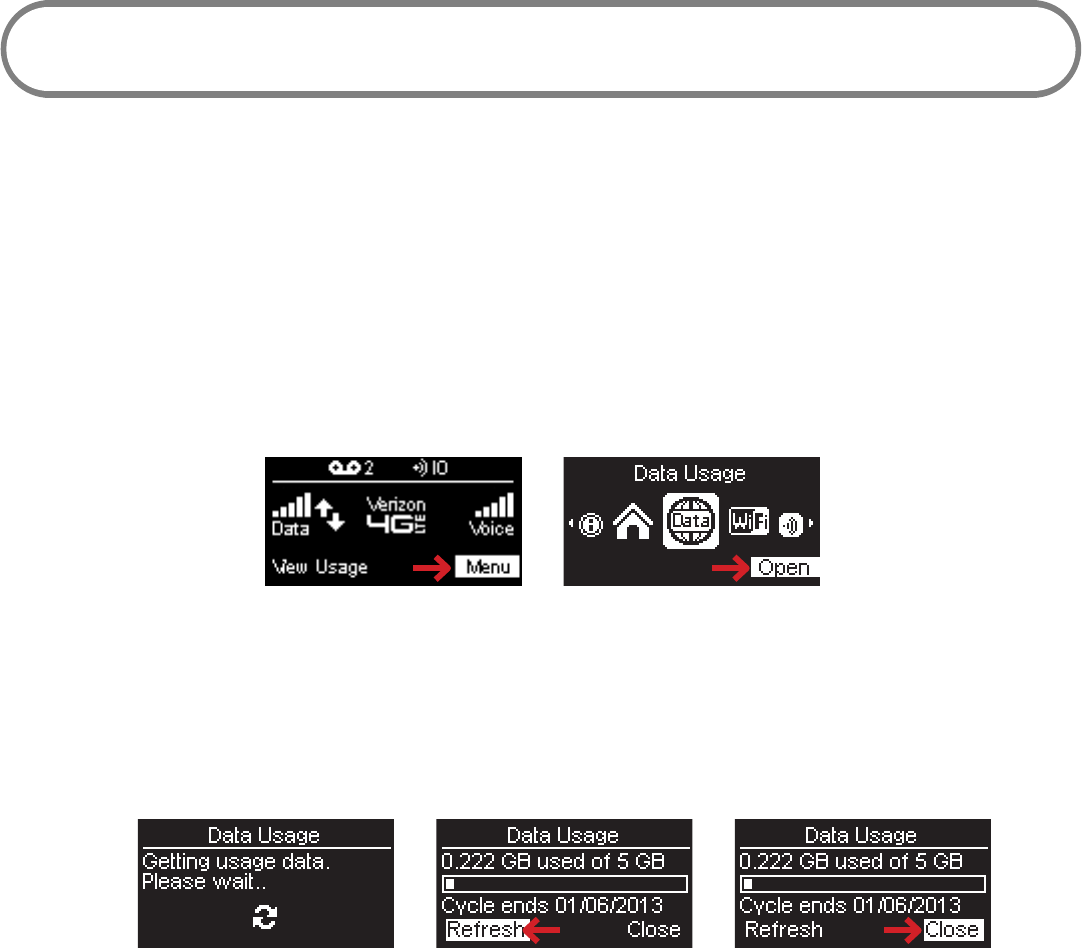
40
Data Usage
If you subscribe to an eligible data only or voice and data plan, you can quickly and easily check
your data usage and billing cycle directly on the LTE Internet and Home Phone, or on the router
Web User Interface.
On the LTE Internet and Home Phone Display
➊ To display your data usage and billing cycle schedule, press the select button on the Home
screen to display the Menu options.
➋ Using the scroll button, scroll to the Data Usage icon and press the select button to open the
Data Usage screen and display your current data usage and billing cycle schedule.
➌ To refresh the Data Usage screen, use the scroll button to highlight Refresh, then press the
select button to update and display your current data usage and billing cycle schedule.
➍ Press the select button to close the Data Usage screen and return to the Menu options.
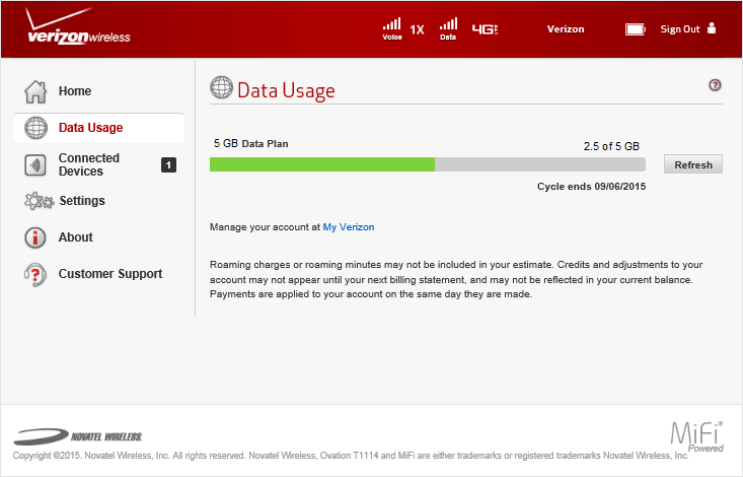
41
On the LTE Internet and Home Phone Web User Interface
The Data Usage page allows you to obtain data usage and billing cycle information for your mobile
broadband plan. Click Data Usage on the Menu panel to display the Data Usage page and access
information specic to your particular plan. You can also access and manage your account by
clicking on My Verizon.
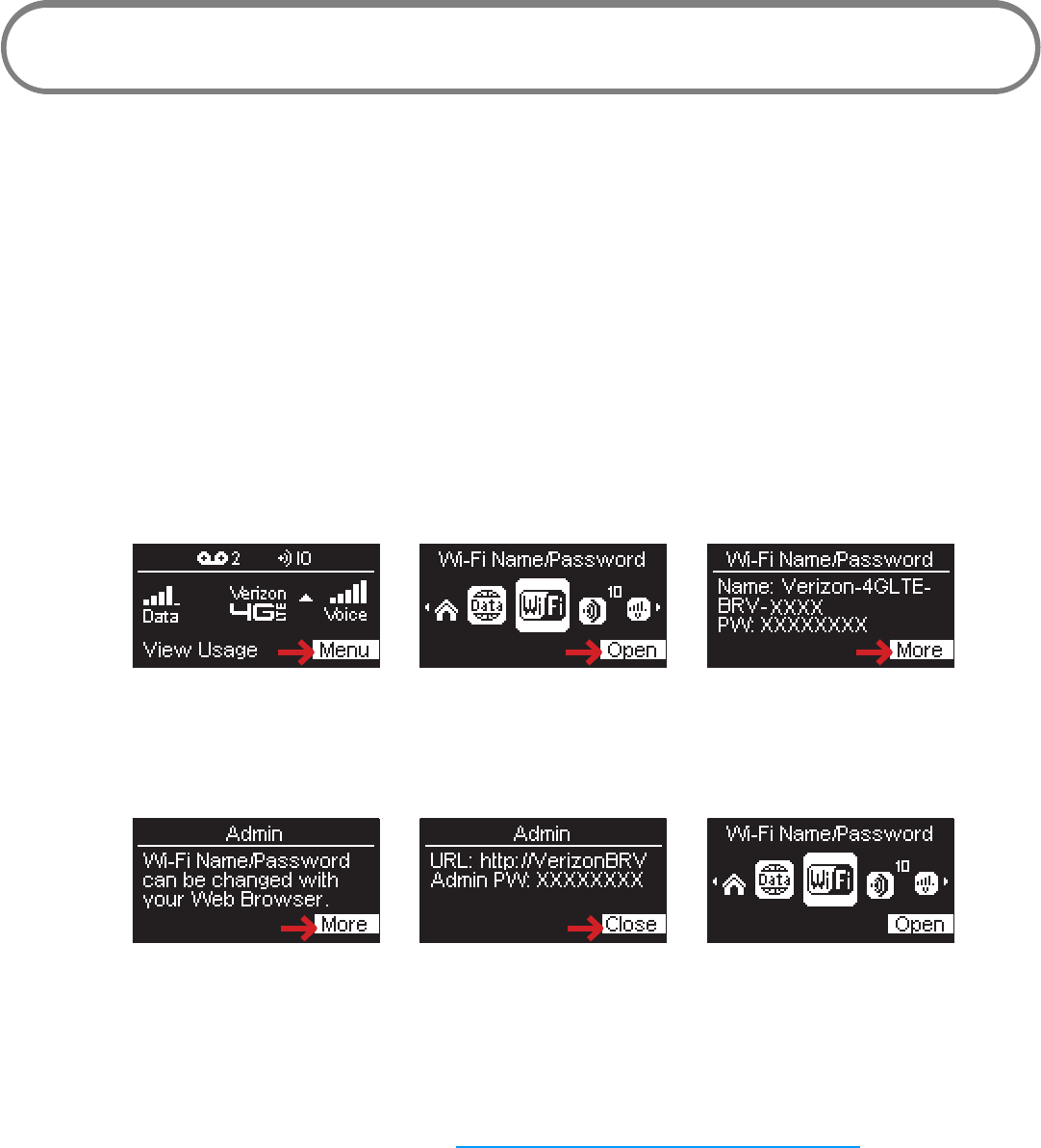
42
Wi-Fi Name/Password
You can quickly and easily nd your current Wi-Fi Name/Password and the URL and Admin Password
directly on the LTE Internet and Home Phone, or on the LTE Internet and Home Phone Web User
Interface.
On the LTE Internet and Home Phone Display
➊ To display your Wi-Fi Name and Password, press the select button on the Home screen to
display the Menu options.
➋ Using the scroll button, scroll to the Wi-Fi Name/Password icon and press the select button
to open the Wi-Fi Name/Password screen and display your current Wi-Fi Name (SSID) and
Password.
➌ Select More > More to open the Admin screen and display the current URL and Admin
Password.
➍ Select Close to return to the Menu options.
On the LTE Internet and Home Phone Web User Interface
You can nd your current Wi-Fi Name and Password, and the current URL and Admin Password on
the LTE Internet and Home Phone Web User Interface. You can also change your Wi-Fi Name and
Password, and your Admin Password. (See Manage My LTE Internet and Home Phone on page 36.)
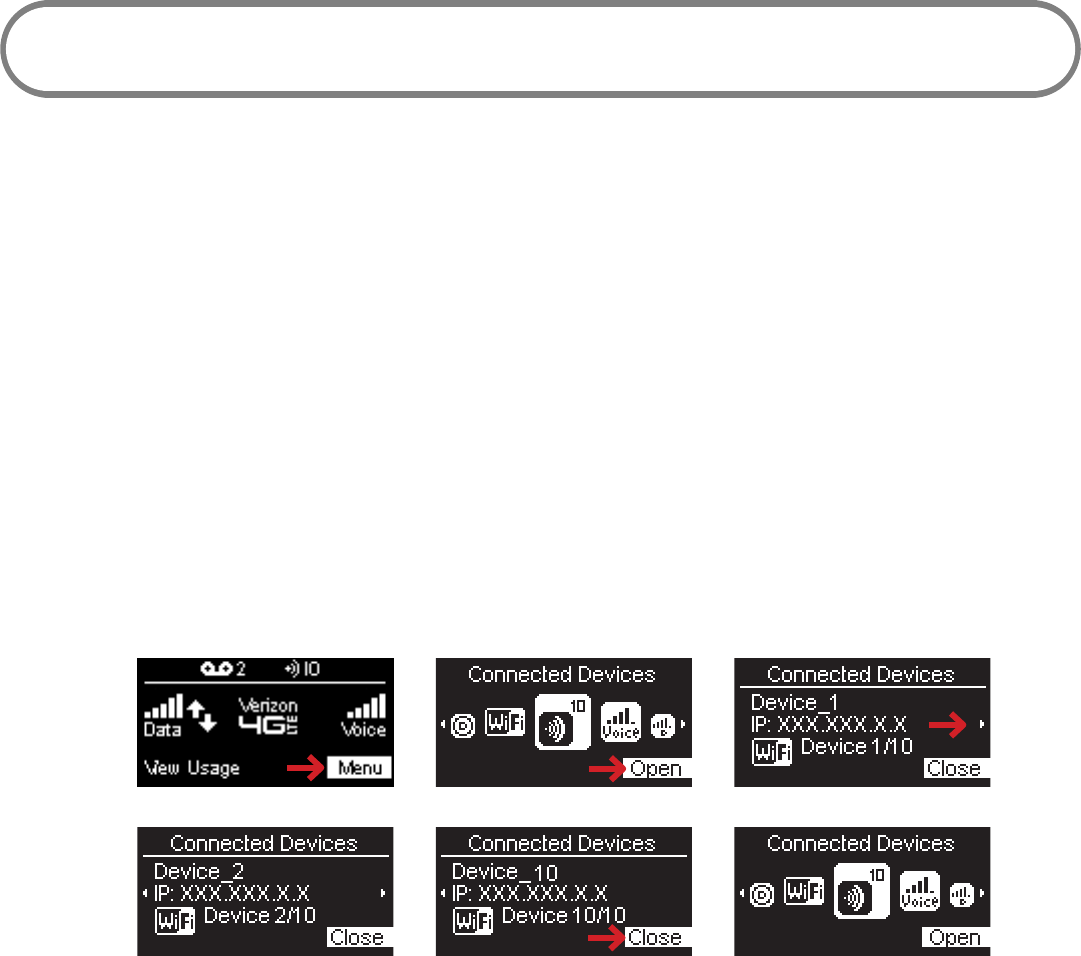
43
Connected Devices
You can view and edit Wi-Fi capable devices currently connected to your LTE Internet and Home
Phone, as well as any currently blocked devices.
On the LTE Internet and Home Phone Display
➊ To display Wi-Fi capable devices currently connected to your LTE Internet and Home Phone,
press the select button on the Home screen to display the Menu options.
➋ Using the scroll button, scroll to the Connected Devices icon and press the select button to
open the Connected Devices screen and display devices currently connected to or blocked
from connecting to your router.
➌ Use the scroll buttons to display device name and IP information for each connected device.
➍ Press the select button to close the Connected Devices screen and return to the Menu
options.
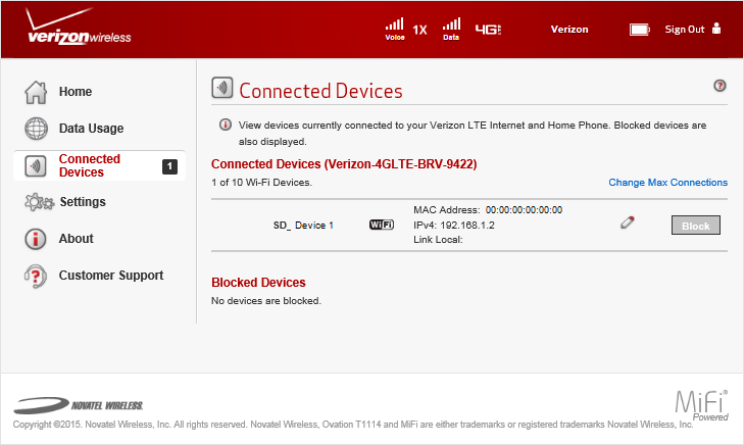
44
On the LTE Internet and Home Phone Web User Interface
The Connected Devices page allows you to view and edit devices that are currently connected
to your LTE Internet and Home Phone. You can also view and unblock any blocked devices. The
Connected Devices page contains the following:
•Connected Devices — displays the IP Address, MAC Address and Link Local IPv6 Address of
up to ten connected wireless devices and up to three devices connected via ethernet.
•Blocked Devices — displays any blocked devices.
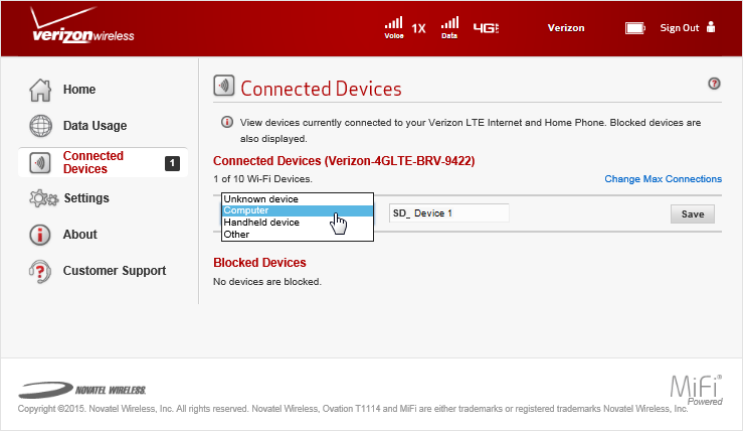
45
Connected Devices
The Connected Devices menu contains the following options:
•Type — indicates the type of connected device. You can use the Edit option to set or change
the type. If the type has not been set, no icon is displayed. Once you set the device type, an
appropriate icon is displayed.
•Name — displays the hostname of the connected device, as set on the connected device.
If you have used this interface to assign a name to a connected device, the assigned name
displays in place of the hostname. In rare cases, the hostname may be unavailable. You can
use the Edit option to change the name of any connected device.
•IP Address — displays the IP address of the connected device.
•MAC Address — displays the MAC Address which is a unique network identier for this
connected device.
•Link-Local Address— displays the Link-Local IPv6 address if the connected device supports
IPv6.
•Edit — allows you to edit a connected device type or name.
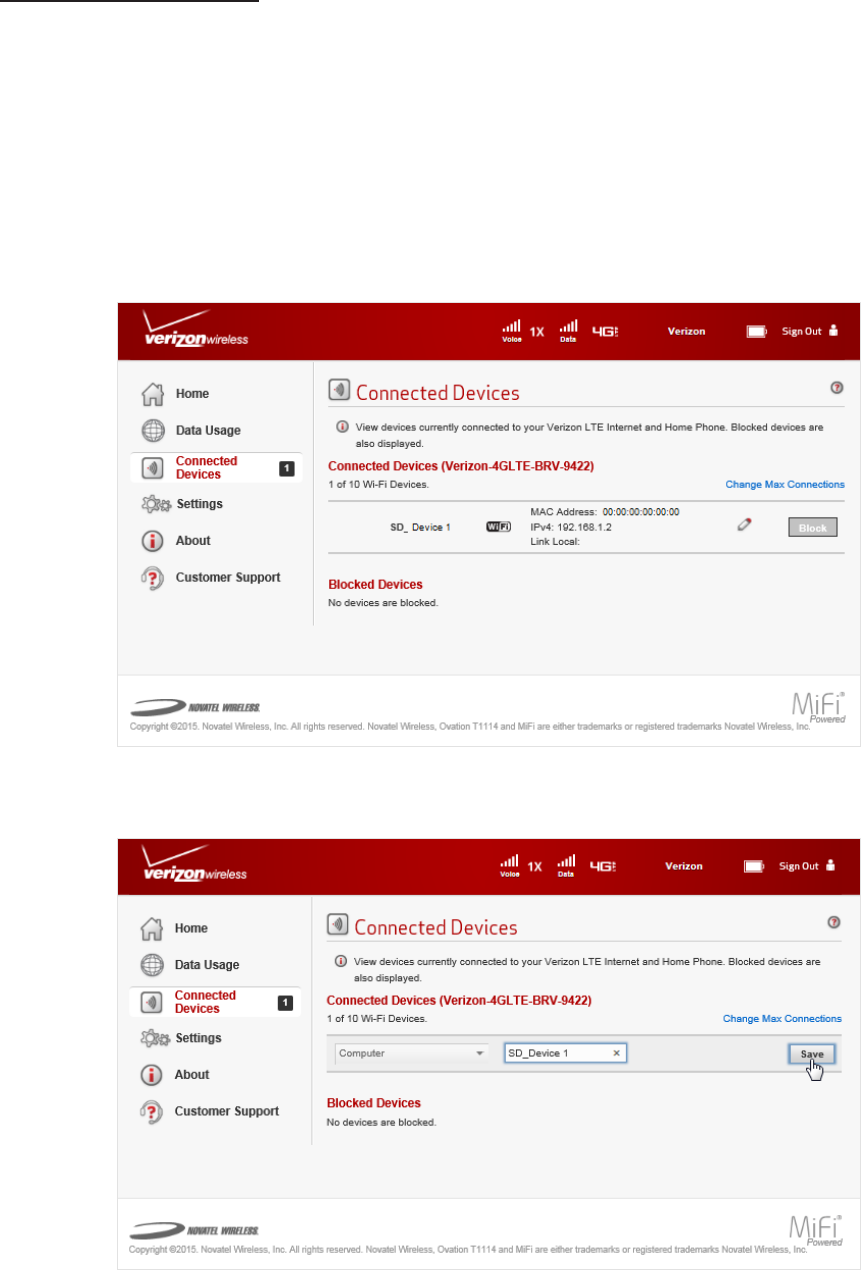
46
Edit a Connected Device
To select the device type, or to edit the name of a connected device:
➊ Click the pencil tool. A page opens allowing you to select the device type, or to edit the
name of a connected device.
➋ Select the appropriate device type from the Connected Devices dropdown menu. Choose
from Unknown, Computer, Handheld, or Other.
➌ To change or revise the existing connected device name, type the desired name in the
device name eld.
➍ Click Save to nish editing the device and save your changes.
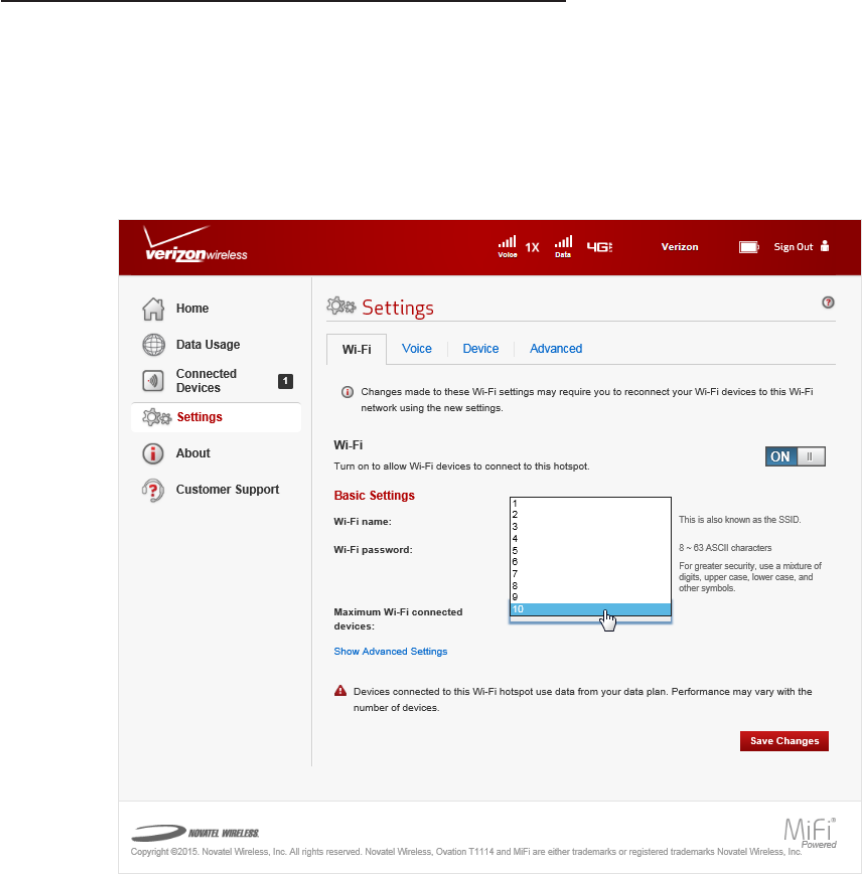
47
Change the Maximum Number of Connected Devices
To change the maximum number of connected devices:
➊ Click Settings on the Menu panel to display the Wi-Fi Settings page.
➋ Select the number of devices from the Maximum Wi-Fi connected devices dropdown menu.
➌ Click Save Changes.
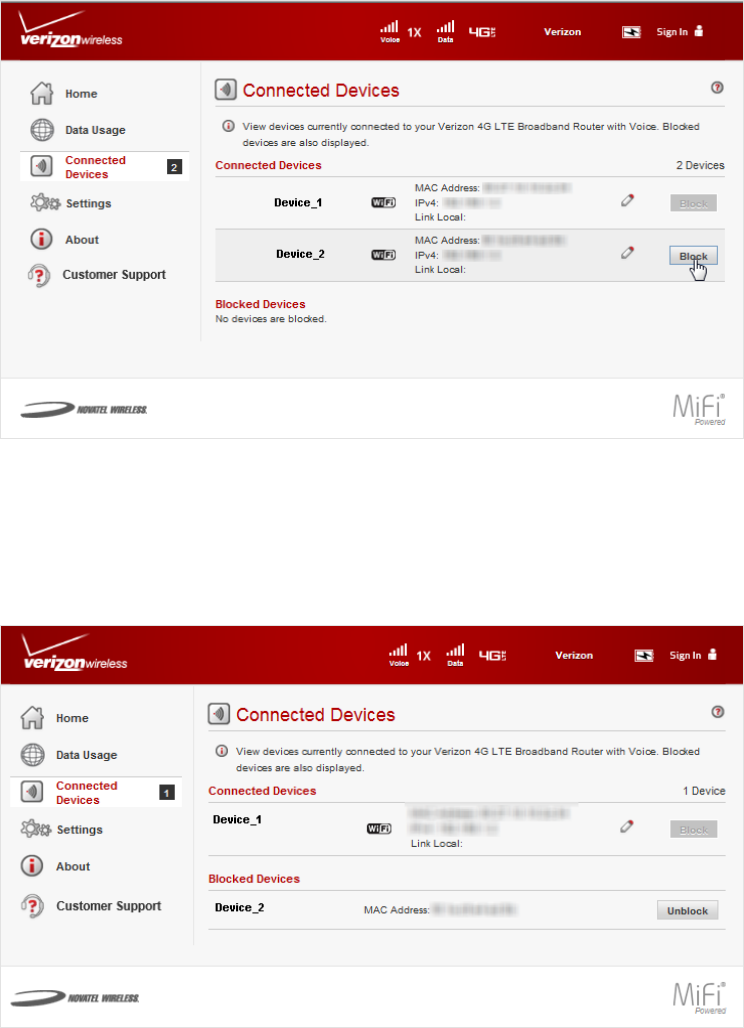
48
Blocked Devices
The Blocked Devices menu contains the following menu options:
•Block Button — click Block to disconnect a connected device and prevent it from
reconnecting. The blocked device then appears in the Blocked List. This option is available for
use with each connected device, except for your own device, and any devices connected via
Ethernet.
•Blocked List — lists any devices you have blocked. Note that since these devices are not
currently connected, and are blocked from connecting, they do not have an IP address.
Instead, they are identied by their name and MAC address.
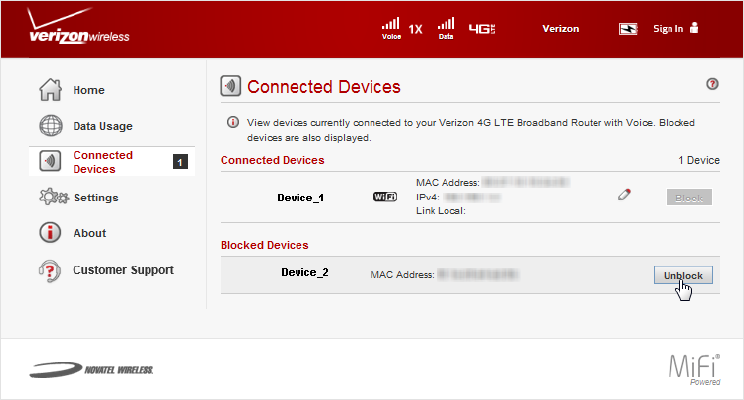
49
•Unblock Button — click Unblock to unblock a previously blocked device, freeing it to connect
again. The unblocked device is deleted from the Blocked List, and will reappear in the
Connected Devices list when it connects.
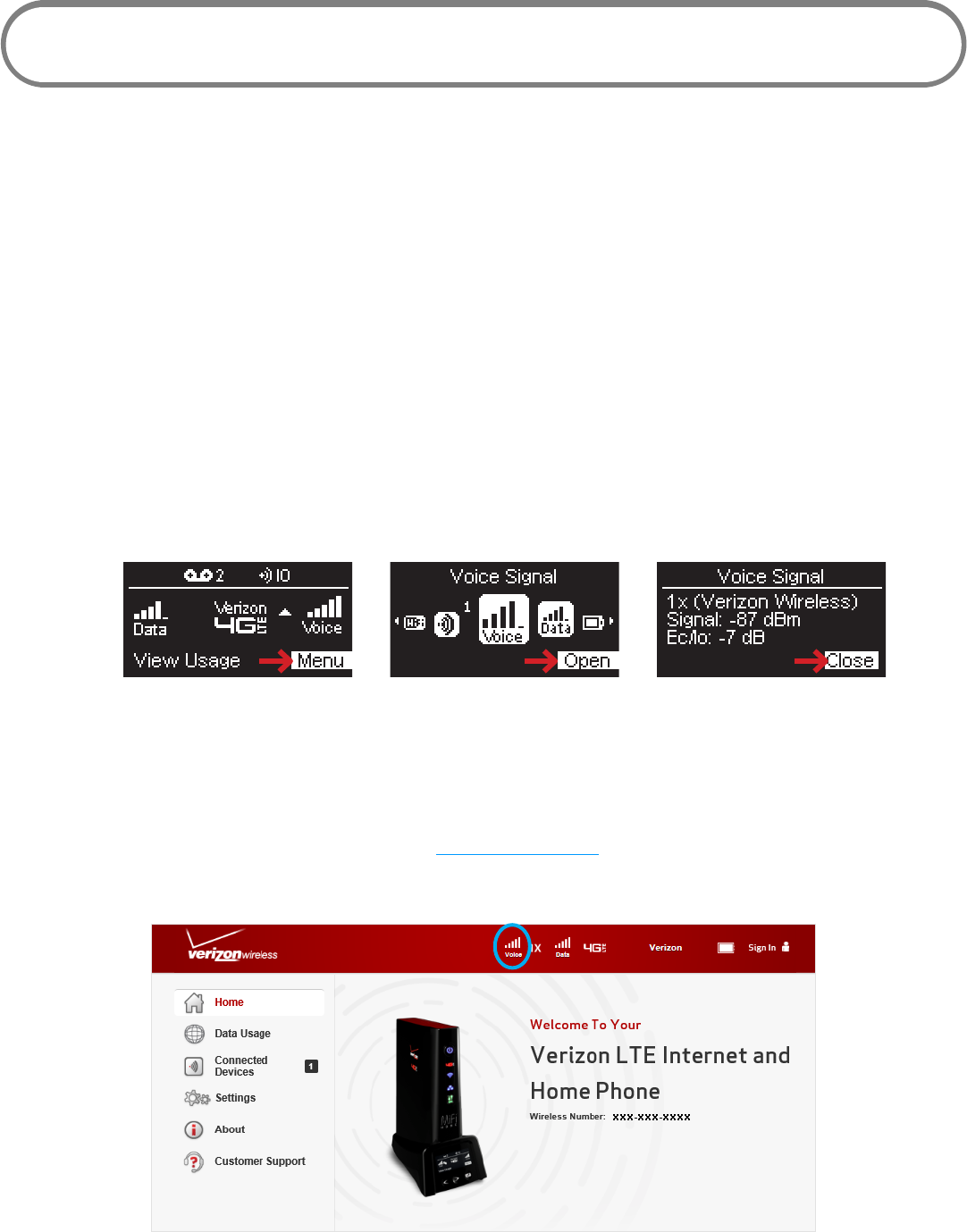
50
Voice Signal
Voice Signal displays the network Voice Signal strength on the Voice Signal indicator using one
to ve bars, and provides Voice Strength details including the Voice network operator, dBm Voice
Signal measurement, and Ec/Io measurement. Your router will send the voice signal over LTE
(VoLTE), or fall back to 1X if VoLTE is not available.
On the LTE Internet and Home Phone Display
To display Voice Signal strength details:
➊ Press the select button on the Home screen to display the Menu options.
➋ Using the scroll button, scroll to the Voice Signal icon and press the select button to open
the Voice Signal screen and display the current Voice Signal details.
➌ Select Close to return to the Menu options.
On the LTE Internet and Home Phone Web User Interface
To display the Voice Signal strength indicator on the LTE Internet and Home Phone Web User
Interface, connect with the router and go to http://VerizonBRV. The Voice Signal strength indicator
displays in the status bar at the top of the web interface.
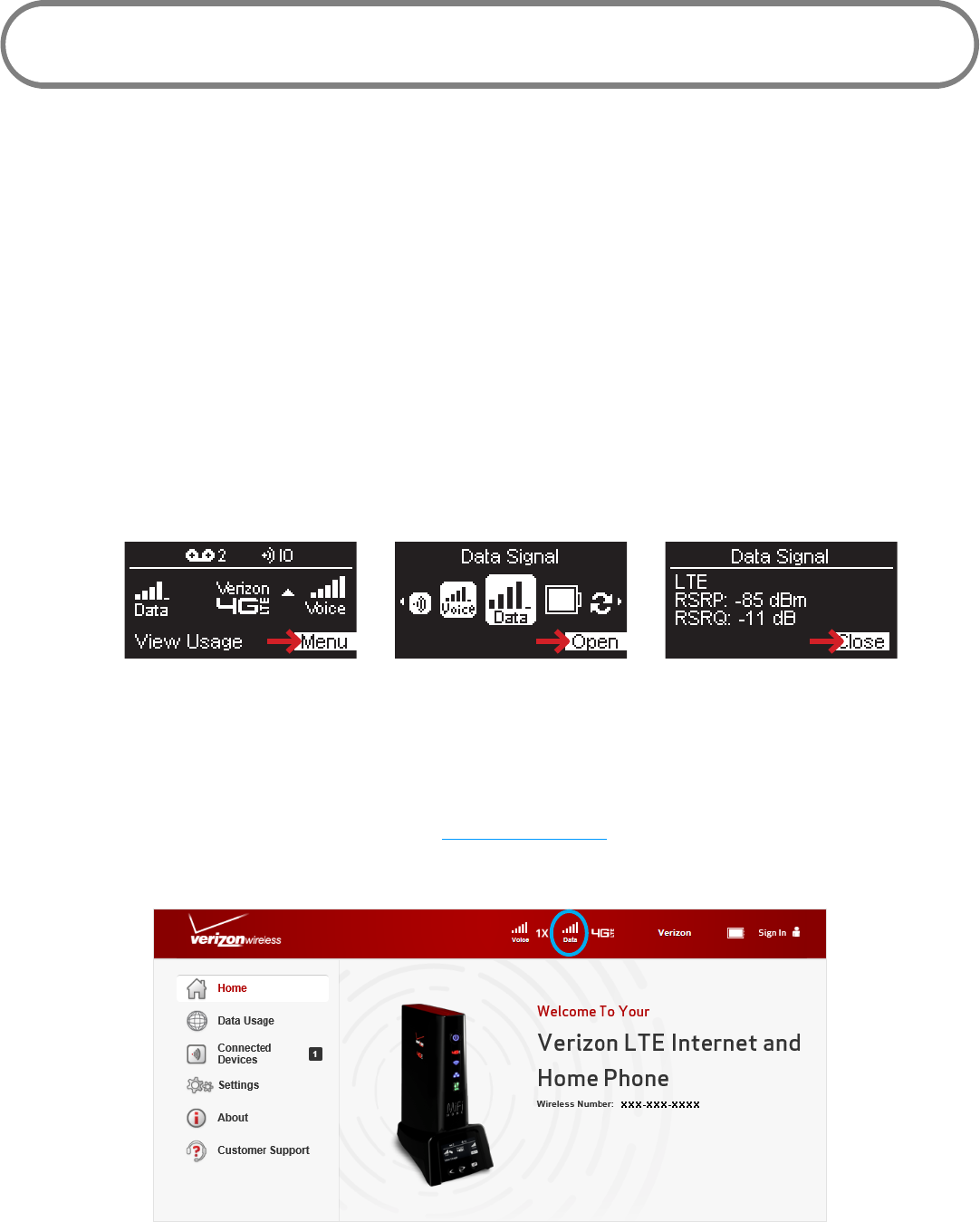
51
Data Signal
Data Signal displays the network Data Signal strength on the Data Signal indicator using one to ve
bars, and provides Data Strength details including the network type, dBm RSRP measurement, and
dB RSRQ measurement.
On the LTE Internet and Home Phone Display
To display Data Signal strength details:
➊ Press the select button on the Home screen to display the Menu options.
➋ Using the scroll button, scroll to the Data Signal icon and press the select button to open the
Data Signal screen and display the current Data Signal details.
➌ Select Close to return to the Menu options.
On the LTE Internet and Home Phone Web User Interface
To display the Data Signal strength indicator on the LTE Internet and Home Phone Web User
Interface, connect with the router and go to http://VerizonBRV. The Data Signal strength indicator
displays in the status bar at the top of the web interface.
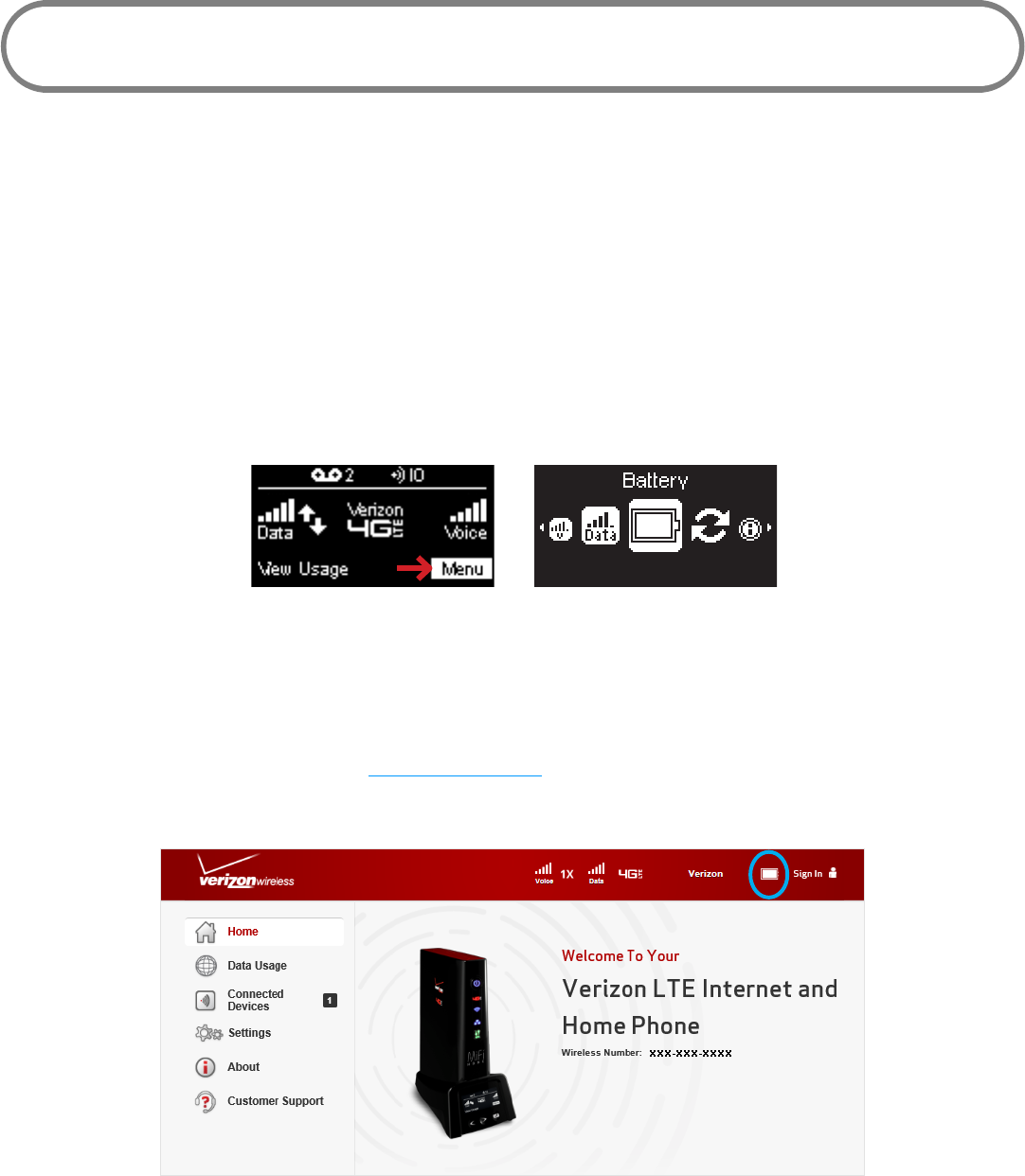
52
Battery
Battery displays the LTE Internet and Home Phone battery strength on the Battery indicator. A fully
charged battery displays solid white.
On the LTE Internet and Home Phone Display
To display Battery strength:
➊ Press the select button on the Home screen to display the Menu options.
➋ Using the scroll button, scroll to display the Battery indicator.
On the LTE Internet and Home Phone Web User Interface
To display the Battery strength indicator on the LTE Internet and Home Phone Web User Interface,
connect with the router and go to http://VerizonBRV. The Battery strength indicator displays in the
status bar at the top of the web interface.
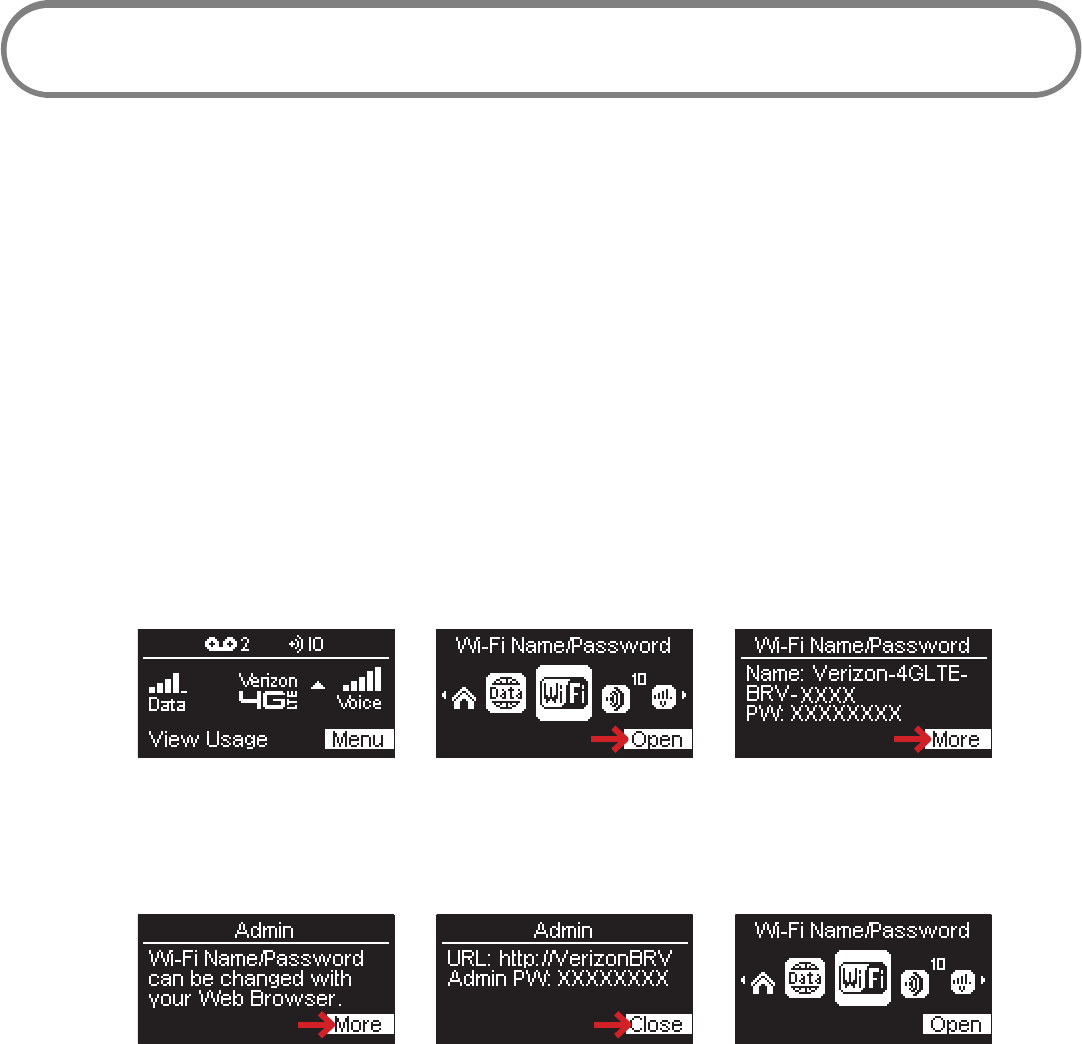
53
Settings
Settings allows you to make device changes, update software, and backup and restore les to your
LTE Internet and Home Phone.
On the LTE Internet and Home Phone Display
The Settings options on the LTE Internet and Home Phone allow you to view your Wi-Fi Name and
Password, your Admin Password, and to check for an available Software update.
To display your Wi-Fi Name/Password and the Web User Interface URL/Admin Password:
➊ Press the select button on the Home screen to display the Menu options.
➋ Using the scroll button, scroll to the Wi-Fi Name/Password icon and press the select button
to open the Wi-Fi Name/Password screen and display your current Wi-Fi Name (SSID) and
Password.
➌ Select More > More to open the Admin screen and display the web interface URL and Admin
Password.
➍ Select Close to return to the Menu options.
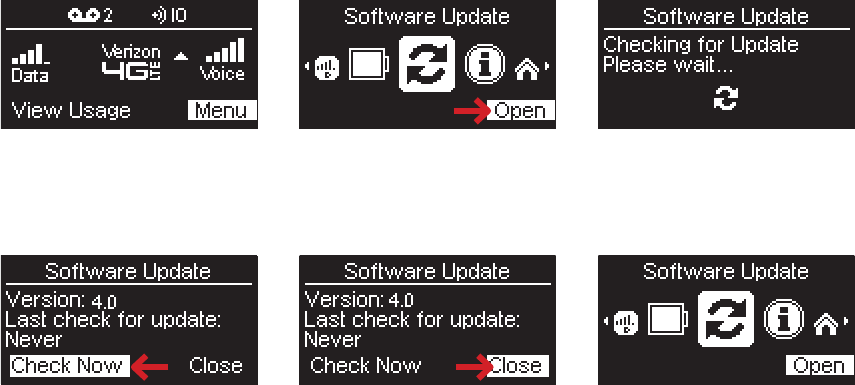
54
To check for available Software updates:
➊ Press the select button on the Home screen to display the Menu options.
➋ Using the scroll button, scroll to the Software Update icon and press the select button to
open the Software Update screen and display the current Software version and the date of
the last check for an update.
➌ To check for an available update, select Check Now.
➍ Select Close to return to the Menu options.
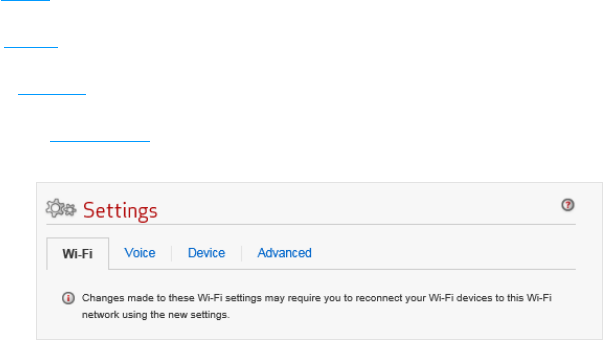
55
On the LTE Internet and Home Phone Web User Interface
The Settings page allows you to make Wi-Fi Name and Password, Admin Password and preference
changes; change voice settings; obtain software update information; and backup and restore les to
your router. The Settings page contains the following menu options:
•Wi-Fi (See Wi-Fi on page 56.)
•Voice (See Voice on page 59.)
•Device (See Device on page 62.)
•Advanced (See Advanced on page 66.)
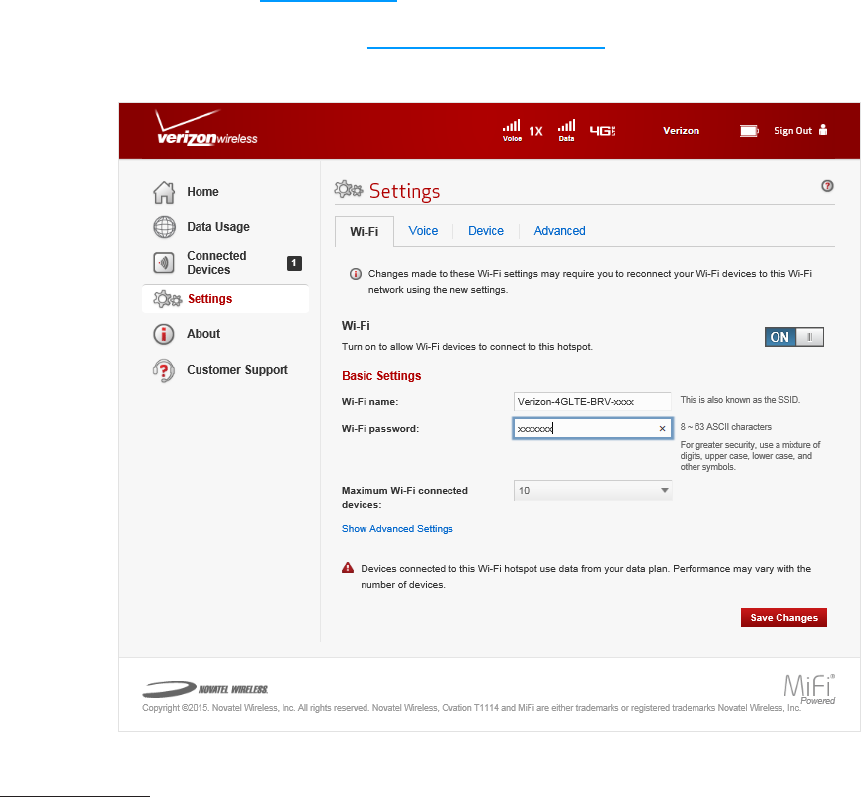
56
Wi-Fi
The Wi-Fi page contains the following sections:
•Basic Settings (See Basic Settings on page 56.)
•Show Advanced Settings (See Show Advanced Settings on page 57.)
Basic Settings
The Basic Settings section of the Wi-Fi page displays the current Wi-Fi Name and Password, and the
maximum number of connected devices allowed.
To change these settings:
➊ Enter the desired Wi-Fi Name (SSID) in the Wi-Fi name eld.
➋ Enter the desired Password in the Wi-Fi password eld.
➌ Select the maximum number of connected Wi-Fi devices desired from the Maximum Wi-Fi
connected devices dropdown menu.
➍ Click Save Changes.

57
Show Advanced Settings
The Advanced Settings section of the Wi-Fi page displays current advanced setting options,
including:
•Band — allows selection of the desired Band option. The 2.4 GHz is widely supported. Do not
select the 5 GHz option unless you know it is supported by your Wi-Fi devices.
•Bandwidth — only available if the Band setting is set to 5 GHz. The wideband (40 MHz)
option provides potentially greater throughput, but may cause interference with other
wireless devices.
•Channel — should be left on Automatic unless you need to choose a particular channel for
your environment.
•802.11 mode — changes the Wi-Fi mode, if required. If all of your connected devices support
802.11n, selecting the option “802.11n only” will provide the best performance. In other
cases, it is recommended that you leave this setting at its default value.
•Security — allows selection of the desired Wi-Fi security option. WPA2 is the latest and most
secure method, and should be used if possible. None allows other people to monitor your
Wi-Fi trac and use your data plan to access the Internet. If at all possible, using None
should be avoided. Using WPA2 is strongly recommended, as this is the most secure method
supported.
•Display Wi-Fi name — turn on to display the Wi-Fi name on the device display.
•Display Wi-Fi password — turn on to display the password on the device display.
•Broadcast Wi-Fi name — turn on to display this Wi-Fi network in the list of available Wi-Fi
networks on your connected devices. Turn o to make this network invisible.
•Wi-Fi privacy separation — turn on to isolate each connected device from all other
connected devices. This provides additional security if some connected devices are unknown
or not completely trusted. For normal operation, this should be turned o.
•Wi-Fi Multimedia (WMM) — when on, assists in throughput. If using 802.11n, it must be
turned on.
•WPS — allows Wi-Fi devices to connect to a Wi-Fi network without having to manually enter
the network key. If turned on in the Web User Interface, compatible Wi-Fi devices can be
connected to the LTE Internet and Home Phone using the WPS option on the router display.
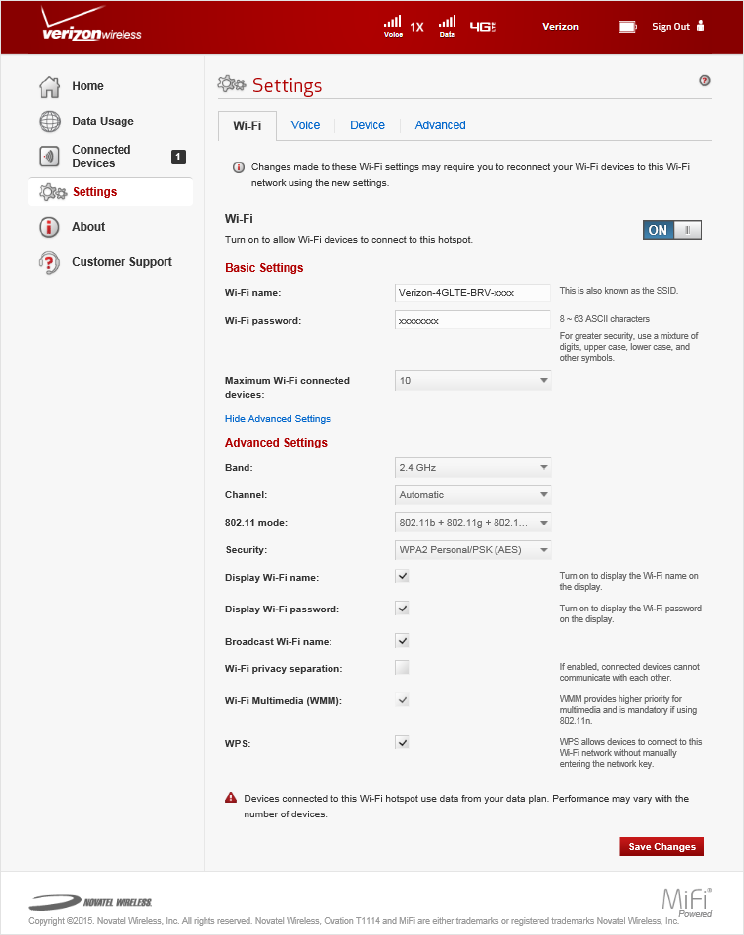
58
To display and customize Advanced Settings options:
➊ Click Show Advanced Settings to display the Advanced Settings options.
➋ Select the desired setting from the selected option dropdown menu.
➌ To turn on or o a selected setting, use the option check box.
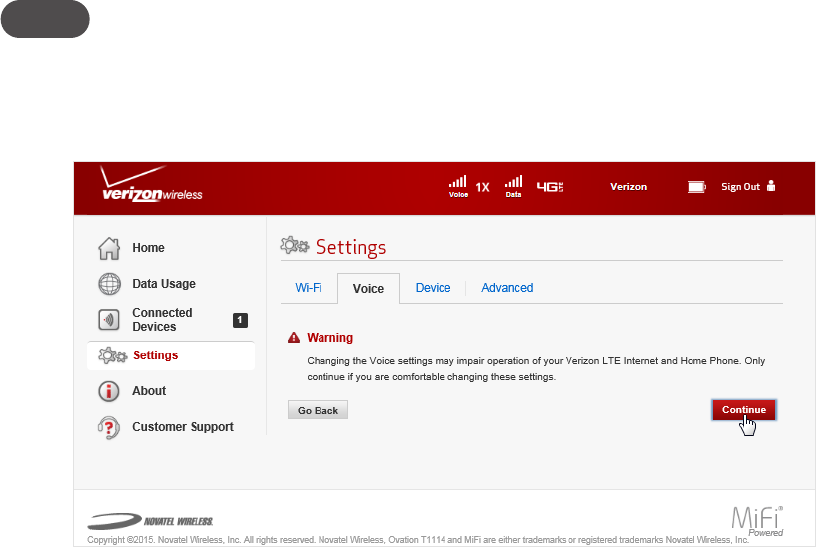
59
Voice
The Voice page contains the following options:
•TTY — allows those who are hearing impaired to use their phone to type messages back and
forth with another TTY supporting device. A TTY capable device is required at both ends of
the connection in order to work properly.
•Start dial timeout — sets the period of time the dial tone will be available when the phone
receiver is o the hook. Options are 1 ~ 20 seconds.
•Inter-digit timeout — sets the period of silence following remote hangup. Options are 1 ~ 10
seconds.
•Remote party hangup timeout — sets the period of silence following remote hangup.
Options are 1 ~ 20 seconds.
NOTE Changing the Voice settings may impair operation of your Verizon LTE Internet and Home Phone.
To change the default Voice Settings:
➊ Click Settings > Voice > Continue to display the Voice Settings options.
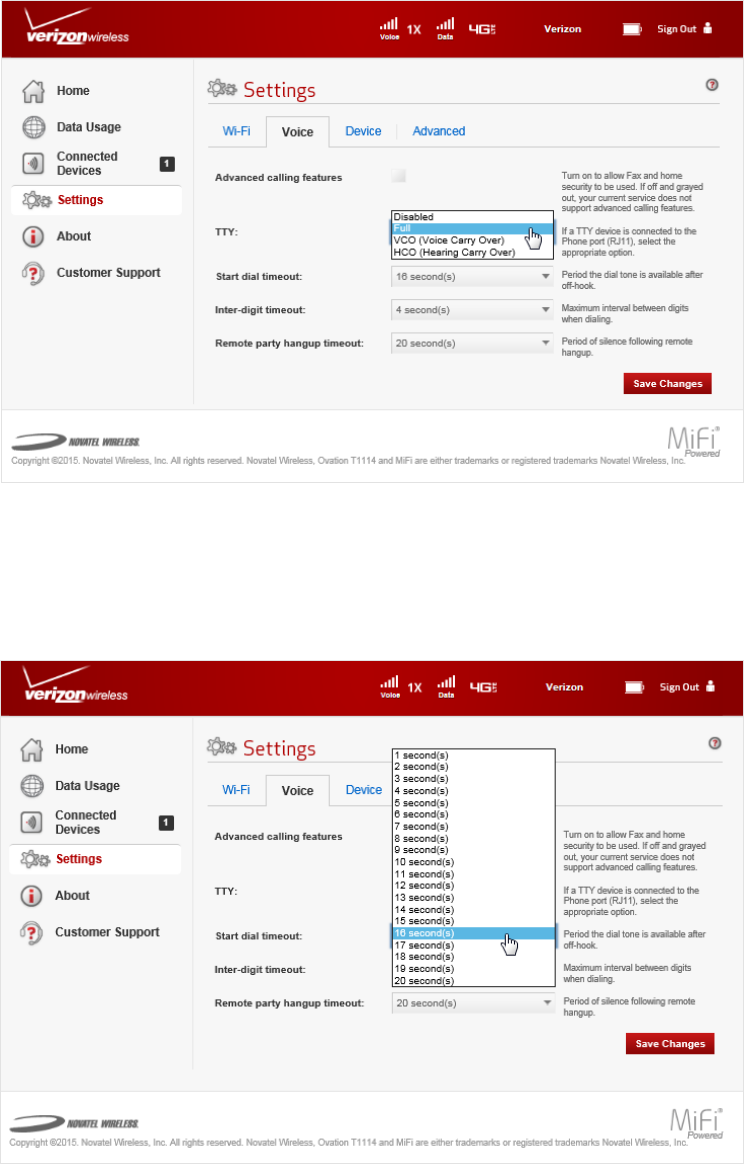
60
➋ If a TTY device is connected to the LTE Internet and Home Phone RJ-11 port, select the
appropriate TTY setting from the TTY dropdown menu. The choices are Full, VCO (Voice Carry
Over), or HCO (Hearing Carry Over). The default setting is Disabled.
➌ To change the period of time the dial tone is available after the phone is o-hook, select
the desired time interval from the Start dial timeout dropdown menu. Choose from 1 - 20
seconds.
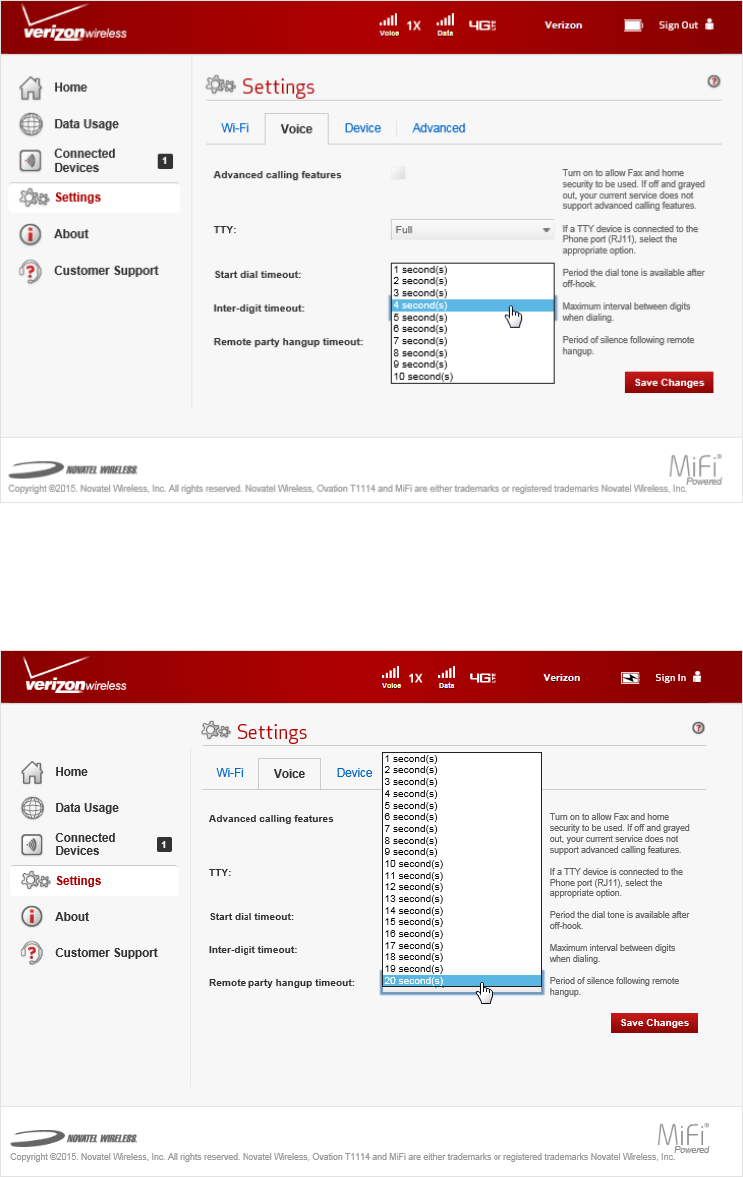
61
➍ To change the maximum period of time between digits when dialing, select the desired time
interval from the Inter-digit timeout dropdown menu. Choose from 1 - 10 seconds.
➎ To change the period of silence following remote hangup, select the desired time interval
from the Remote party hangup timeout dropdown menu. Choose from 1 - 20 seconds.
➏ Click Save Changes.
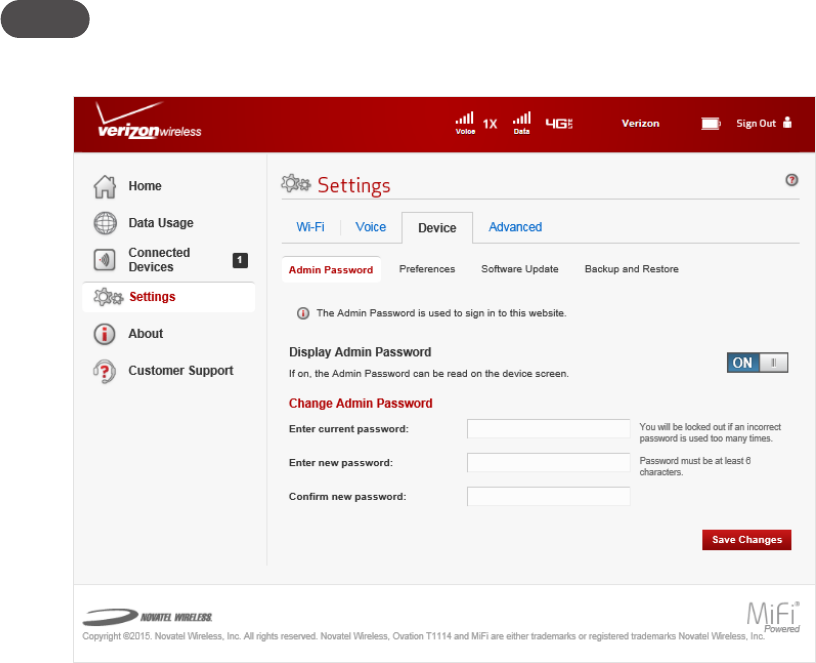
62
Device
The Device page includes the following options:
•Admin Password — used to Sign In to the Web User Interface. The Admin Password page
allows you to change the Admin Password, and to set a security option relating to the display
of the Admin Password on the device.
•Preferences — allows you to set the time interval when the device display turns o after a
period of inactivity.
•Software Update — allows you to monitor software updates automatically delivered over the
mobile network.
•Backup and Restore — allows you to download a copy of the conguration settings from
the LTE Internet and Home Phone to a le on your computer, or upload a previously-saved
conguration le. This conguration le contains all settings for the device, router and
system functions. It does not contain any settings or data for the 4G modem.
NOTE You can only restore a file to the same device it came from.
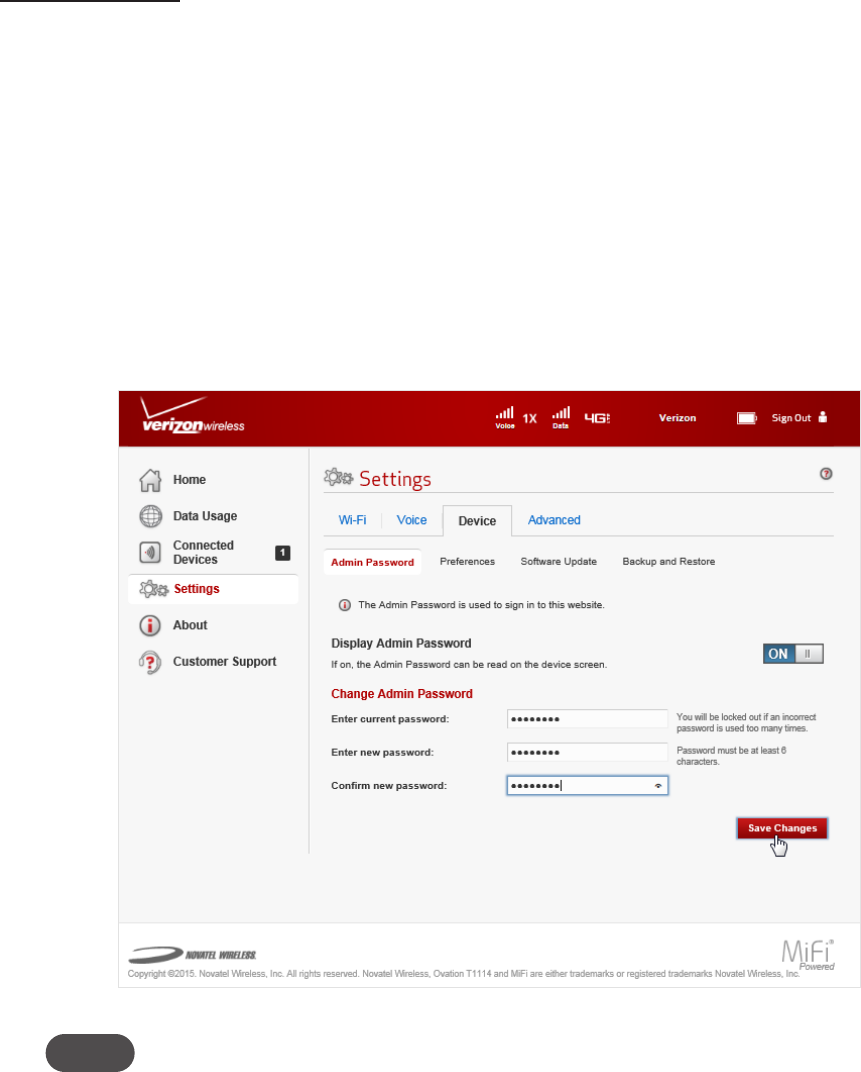
63
Admin Password
To hide or display the Admin Password:
•Slide the ON/OFF button to ON to display the Admin Password on the device display or to
OFF to hide the Admin Password on the router display.
To change the Admin Password:
➊ Type your current Admin Password in the Enter current password eld.
➋ Type your new Admin Password in the Enter new password eld.
➌ Type your new Admin Password a second time in the Confirm new password eld.
➍ Click Save Changes to save any changes made to your password.
NOTE Your. new Admin Password must now be used to Sign In to this Web User Interface.
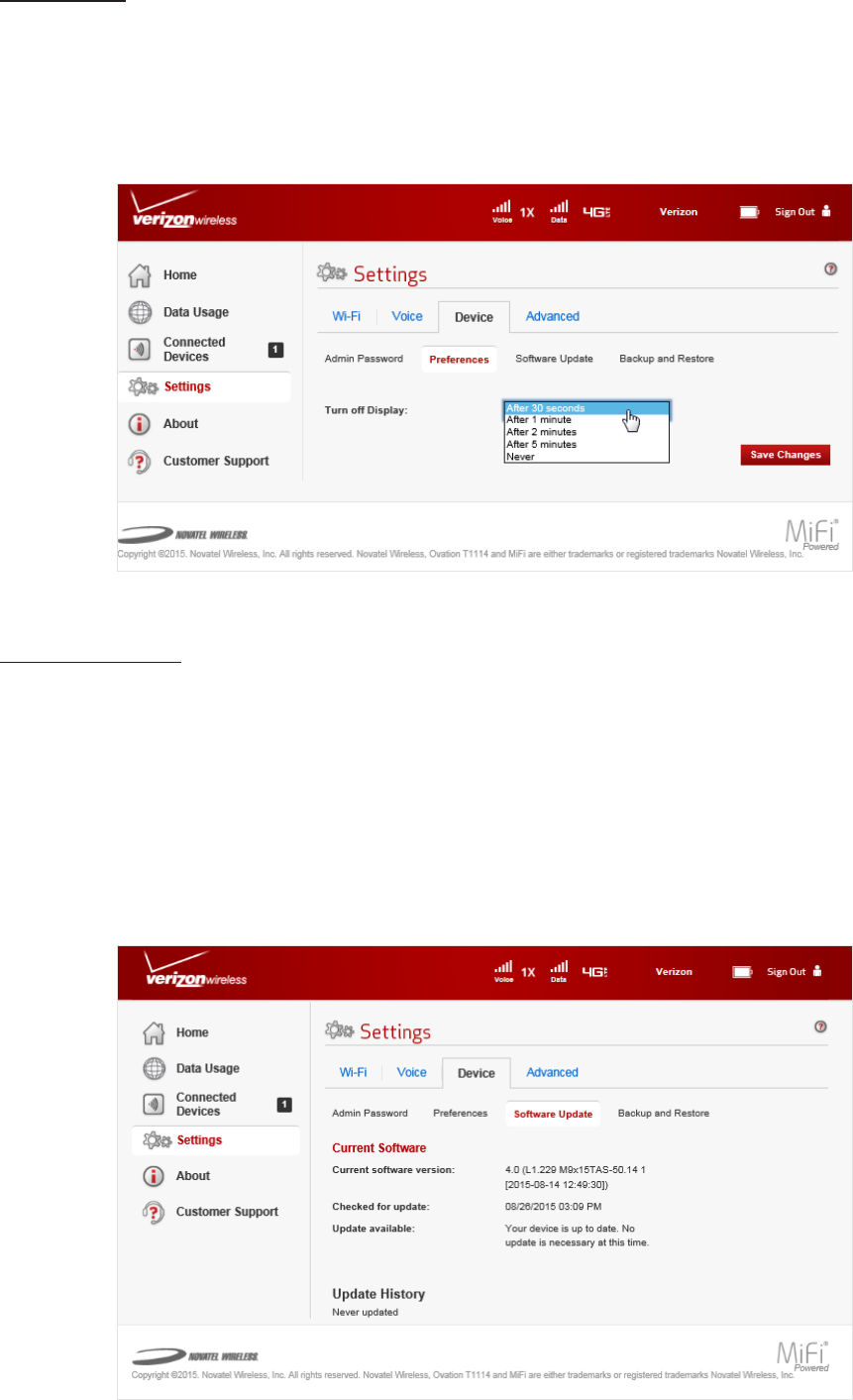
64
Preferences
The set the Turn off display time interval:
➊ Select the desired time interval from the Turn off display dropdown menu. Choose from
After 30 seconds, After 1 minute, After 2 minutes, After 5 minutes, or Never.
➋ Click Save Changes.
Software Update
The Software Update page contains the following sections:
•Current software version — displays the current software version installed on the LTE
Internet and Home Phone.
•Checked for update — displays the date that the LTE Internet and Home Phone automatically
checked for a software update.
•Update available — indicates if an update is available. If available, the update is automatically
downloaded and installed.
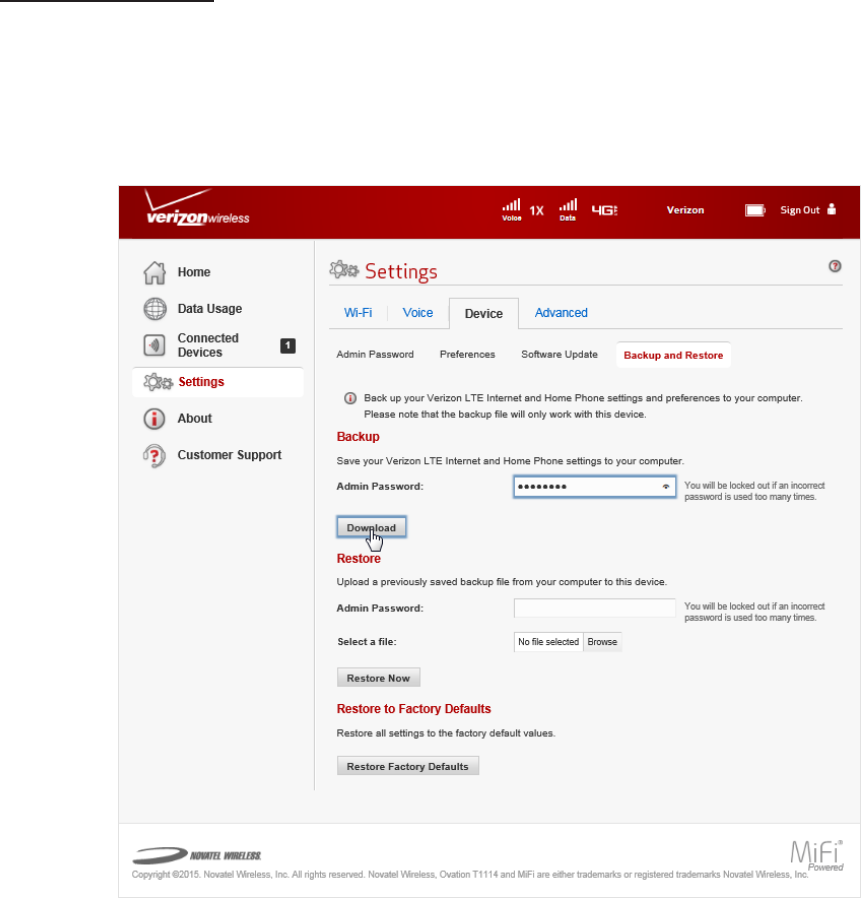
65
Backup and Restore
The Backup and Restore page contains the following sections:
•Backup — Allows you to save your LTE Internet and Home Phone settings as a congmi
le to your computer. You must enter your Admin Password in the Admin Password eld and
click Download to save settings to your computer.
•Restore — Allows you to upload a previously saved backup le from your computer to your
LTE Internet and Home Phone. Click Browse and select a le, then enter the Admin Password
in eect when the backup le was saved in the Admin Password eld and click Restore Now.
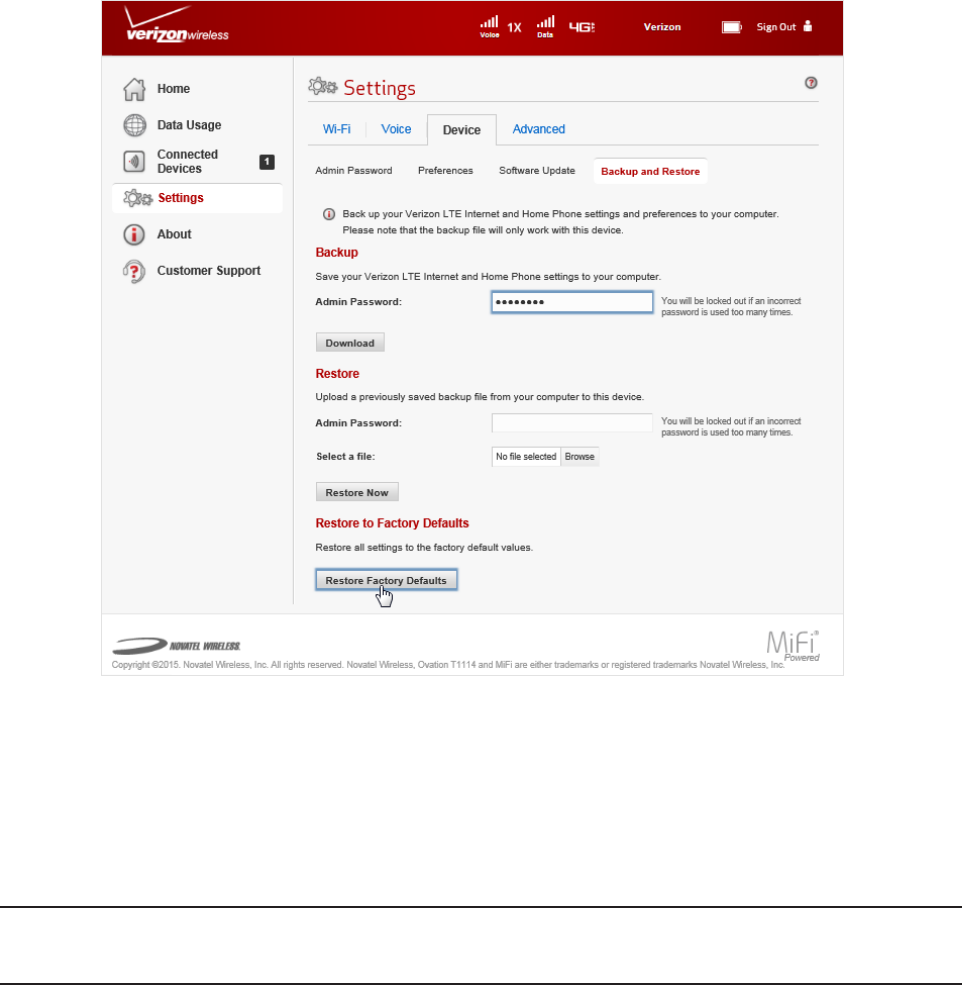
66
•Restore to Factory Defaults — Allows you to restore all settings on your LTE Internet and
Home Phone to the factory default values. Click Restore Factory Defaults to restore all such
settings. If prompted for a password, use the Admin Password which can be found on the LTE
Internet and Home Phone by selecting Menu > Wi-Fi Name/Password > More > More.
Advanced
The Advanced page allows you to change the LTE Internet and Home Phone advanced settings. The
Advanced page provides manual DNS, rewall and LAN settings; and options for conguring port
ltering and port forwarding applications.
WARNING! Changing the Advanced settings may be harmful to the stability, performance,
and security of the LTE Internet and Home Phone.
The Advanced page includes the following options:
•Manual DNS — allows you to manually specify a Domain Name Server (DNS) if required.
•Firewall — allows you to select settings to protect your connected devices against malicious
incoming trac from the Internet and cannot be turned o.
•LAN — allows you to specify settings for your Local Area Network (LAN), which includes the
LTE Internet and Home Phone and all connected devices.
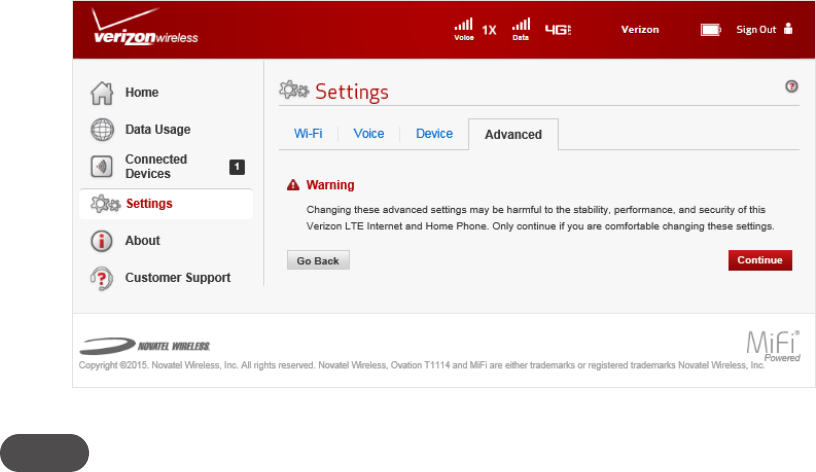
67
•Port Filtering — allows you to block outgoing Internet trac, identied by port numbers.
•Port Forwarding — allows you to permit incoming trac from the Internet to be forwarded
to a particular computer or device on your Wi-Fi network. Use to allow Internet users to
access any server you are running on your computer, such as a web, FTP, or email server.
NOTE Port Forwarding must be used for some online games to function correctly. The use of Port
Forwarding creates a security risk and should be turned off when not required.
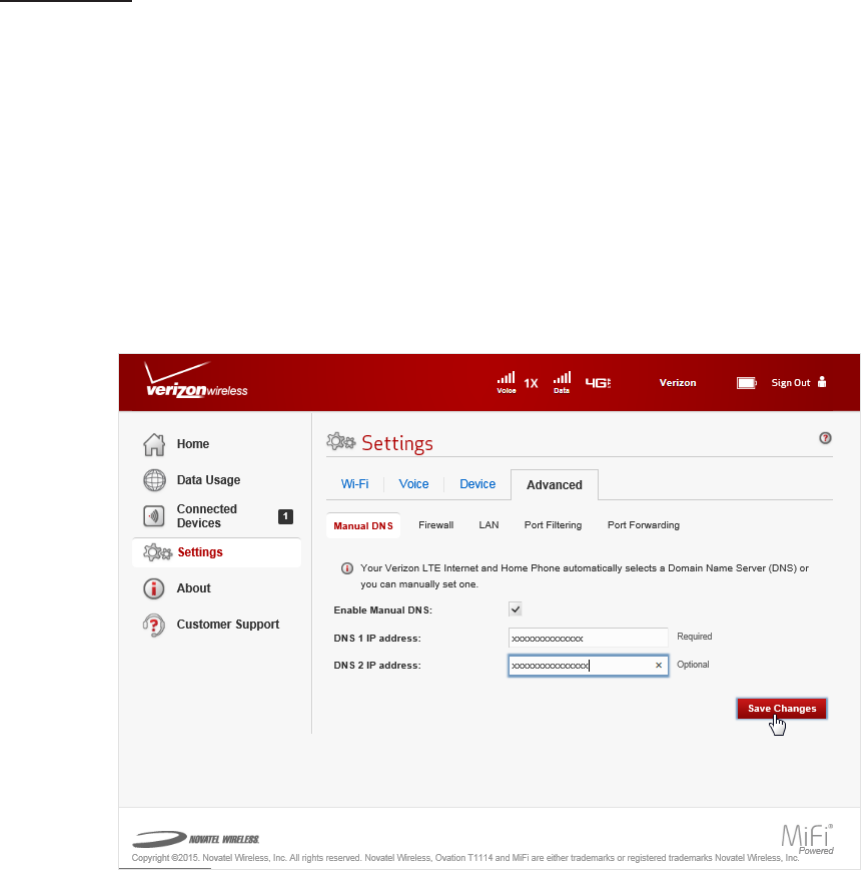
68
Manual DNS
The LTE Internet and Home Phone automatically selects a Domain Name Server (DNS). The Manual
DNS menu allows you to manually select up to two DNS IP addresses.
To manually select a Domain Name Server, follow these steps:
➊ Click the box next to Manual DNS.
➋ Enter the IP address for the rst DNS in the DNS 1 IP address eld.
➌ Enter the IP address for the second DNS in the DNS 2 IP address eld, if applicable.
➍ Click Save Changes.
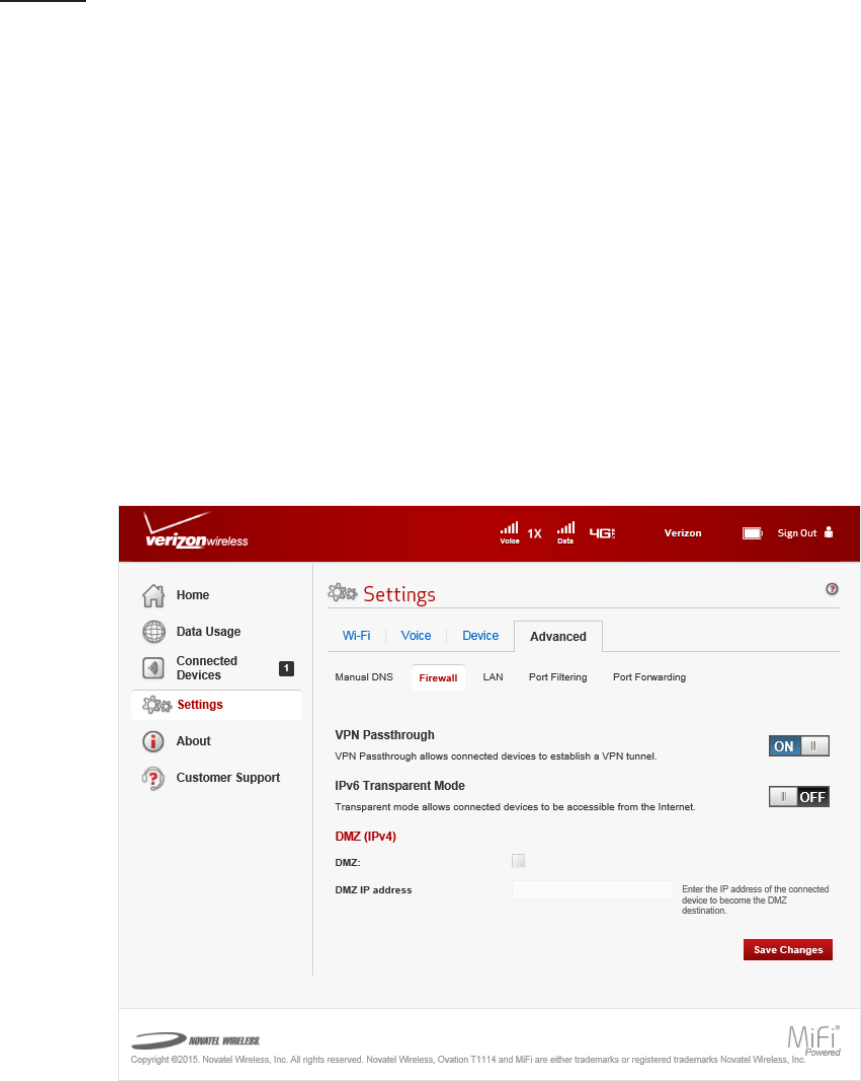
69
Firewall
The LTE Internet and Home Phone rewall determines which Internet trac is allowed. The Firewall
menu contains the following sections:
•VPN Passthrough — turns on or o the VPN feature and allows or disallows connected
devices to establish a VPN tunnel.
•If this is ON (turned on), this feature allows VPN clients to connect through the LTE
Internet and Home Phone to remote VPN Servers. Normally, this option should be turned
on.
•If this is OFF (turned o), VPN clients are not allowed to connect.
•IPv6 Transparent Mode — allows connected devices to be accessible from the Internet.
•DMZ (IPv4) — If turned on, the connected device specied as the DMZ IP address (DMZ
destination) will receive all trac which would otherwise be blocked by the rewall. This
may assist some troublesome network applications to function properly, but the DMZ device
should have its own rewall to protect itself against malicious trac.
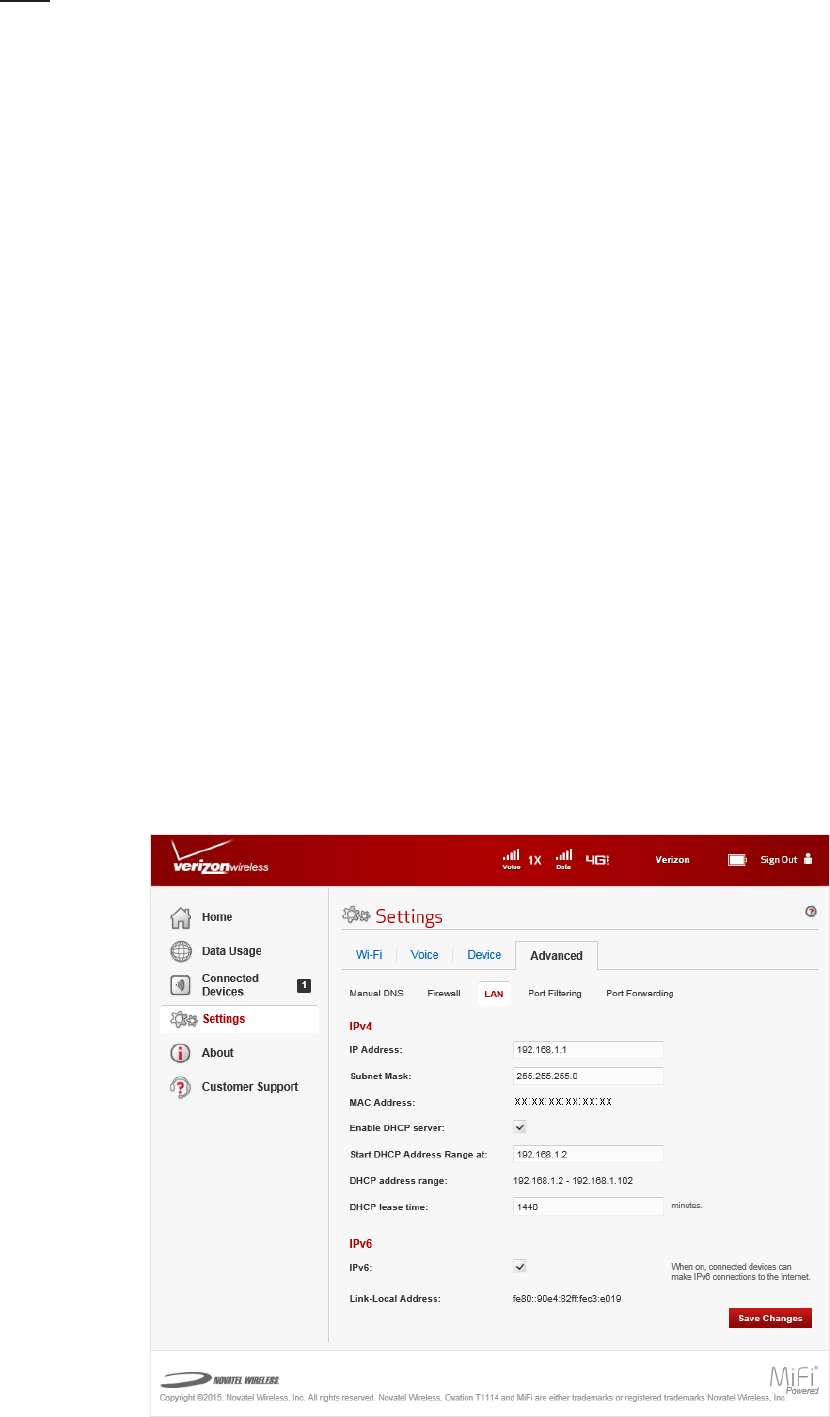
70
LAN
The LAN page provides settings and information about the LTE Internet and Home Phone's network.
The LAN menu contains the following sections:
•IPv4
•IP address — displays the IP address for the LTE Internet and Home Phone.
•Subnet mask — displays the subnet mask network setting for the LTE Internet and Home
Phone. The default value 255.255.255.0 is standard for small (class "C") networks. If you
change the LAN IP Address, ensure you use the correct Subnet Mask for the IP address
range containing the LAN IP address.
•MAC address — displays the Media Access Controller (MAC) or physical address for the
LTE Internet and Home Phone.
•DHCP server — DHCP Server checkbox allows you to turn on or o the DHCP Server
feature.
•Start DHCP address range at — displays the start range of IP addresses reserved for use by
the LTE Internet and Home Phone's DHCP server table.
•DHCP address range — displays the current range of IP addresses reserved for use by
the LTE Internet and Home Phone's DHCP server table. If a device with a static IP address
wants to connect to the LTE Internet and Home Phone's network, the static IP should be
outside of the DHCP address range. Most devices do not have a static IP.
•DHCP lease time — determines how often connected devices must renew the IP address
assigned to them by the DHCP server. Normally, this can be left at the default value, but if
you have special requirements you can change this value.
•IPv6
•IPv6 — IPv6 checkbox allows you to turn on or o the IPv6 feature.
•Link-Local address — displays the local address when IPv6 is turned on.
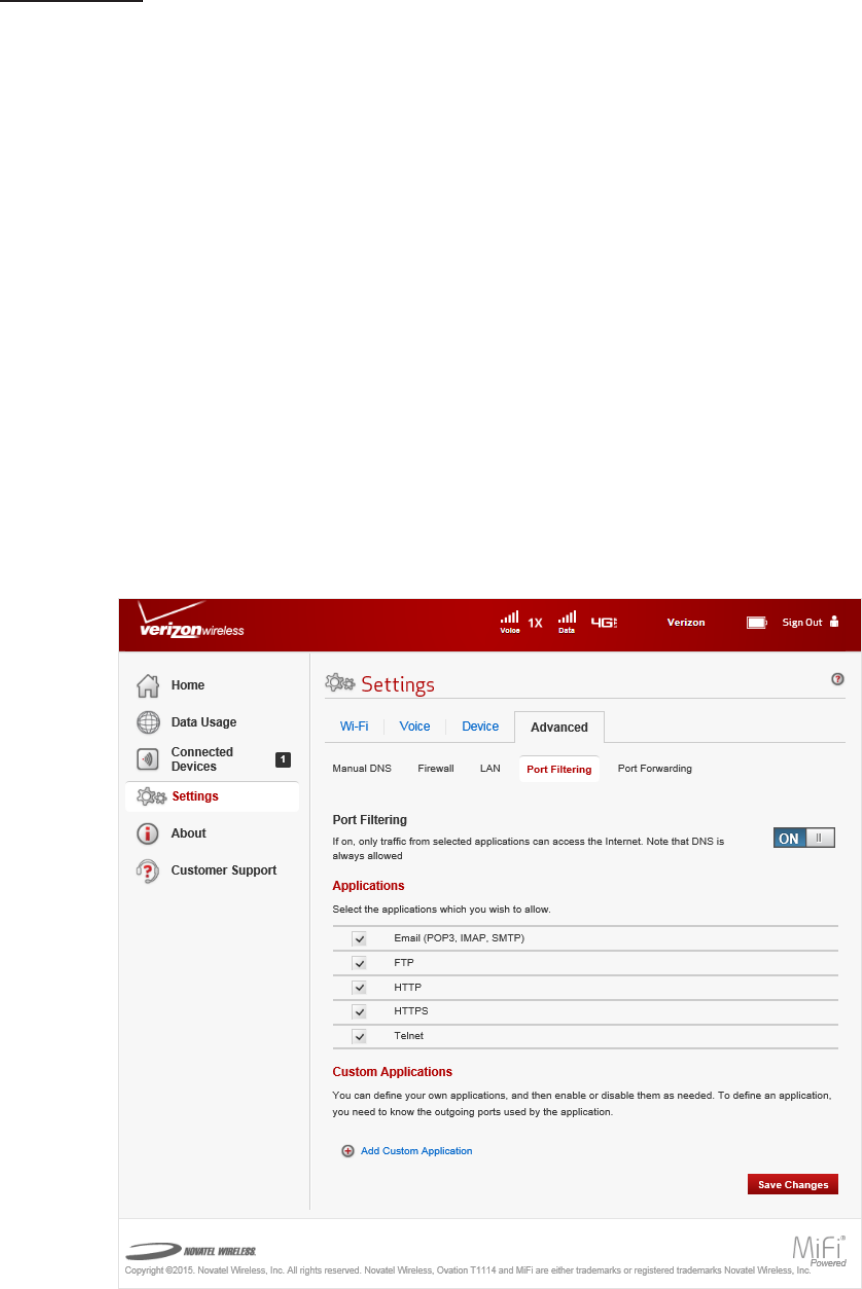
71
Port Filtering
Port Filtering allows you to block outgoing Internet connections and permit only allowed
applications to access the Internet. You can also customize a list of allowed applications which
permits only certain programs to connect to the Internet.
Click ON to turn on Port Filtering. When the feature is turned on, you must select a port ltering
application in the Applications list to allow that application to connect to the Internet. For example,
if you select VPN in the Applications list but do not select HTTP, you can connect to a VPN server but
you cannot connect to a web page using your Internet browser.
Click OFF to turn o Port Filtering. When the feature is turned o, any application can connect to the
Internet.
The Port Filtering menu contains the following sections:
•Applications — Turn on each port ltering application that needs to be able to access the
Internet by checking the box next to one or more applications. When port ltering is turned
on, all other applications are blocked.
•Custom Applications — You can dene your own applications, and then turn them on or
o as needed. To dene an application, you need to know the outgoing ports used by the
application.
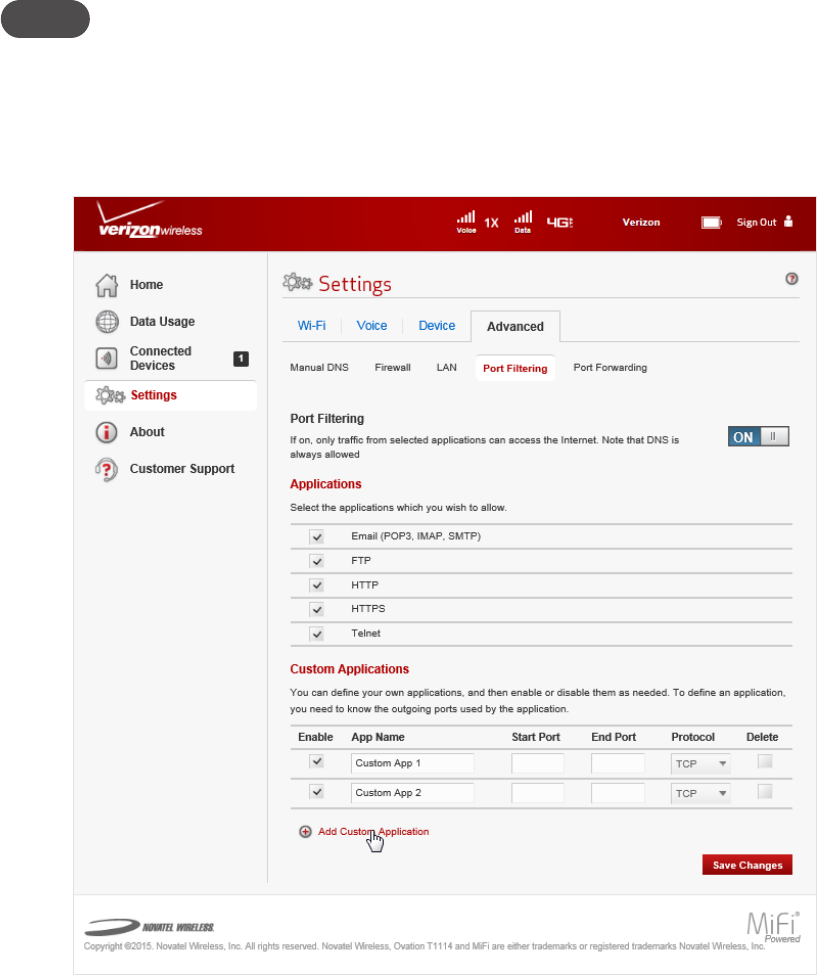
72
Add a Custom Application
To add a custom application:
➊ Click Add Custom Application to add a new custom application to the list of allowed
applications. You can dene and turn on custom Port Filtering applications. You need to
know details of the trac used and generated by the applications you wish to dene.
NOTE The Add Custom Application option is only available when the port filtering is turned on. You
can add up to ten custom applications.
The Custom Port Filtering page uses check boxes to turn on port ltering for custom
applications. Similar to the Applications list, you must turn on custom applications so they
can connect to the Internet.
➋ Enter the beginning of the range of port numbers used by outgoing trac for the custom
application being added in the Start Port eld.
➌ Enter the end of the range of port numbers in the End Port eld. If the port is a single port
instead of a range, type the same value for both the Start Port and the End Port.
➍ Select the protocol used by each port range from the Protocol dropdown menu. Choose
from Transmission Control Protocol (TCP), User Datagram Protocol (UDP), or both. Click Save
Changes to save any changes made to the custom applications.
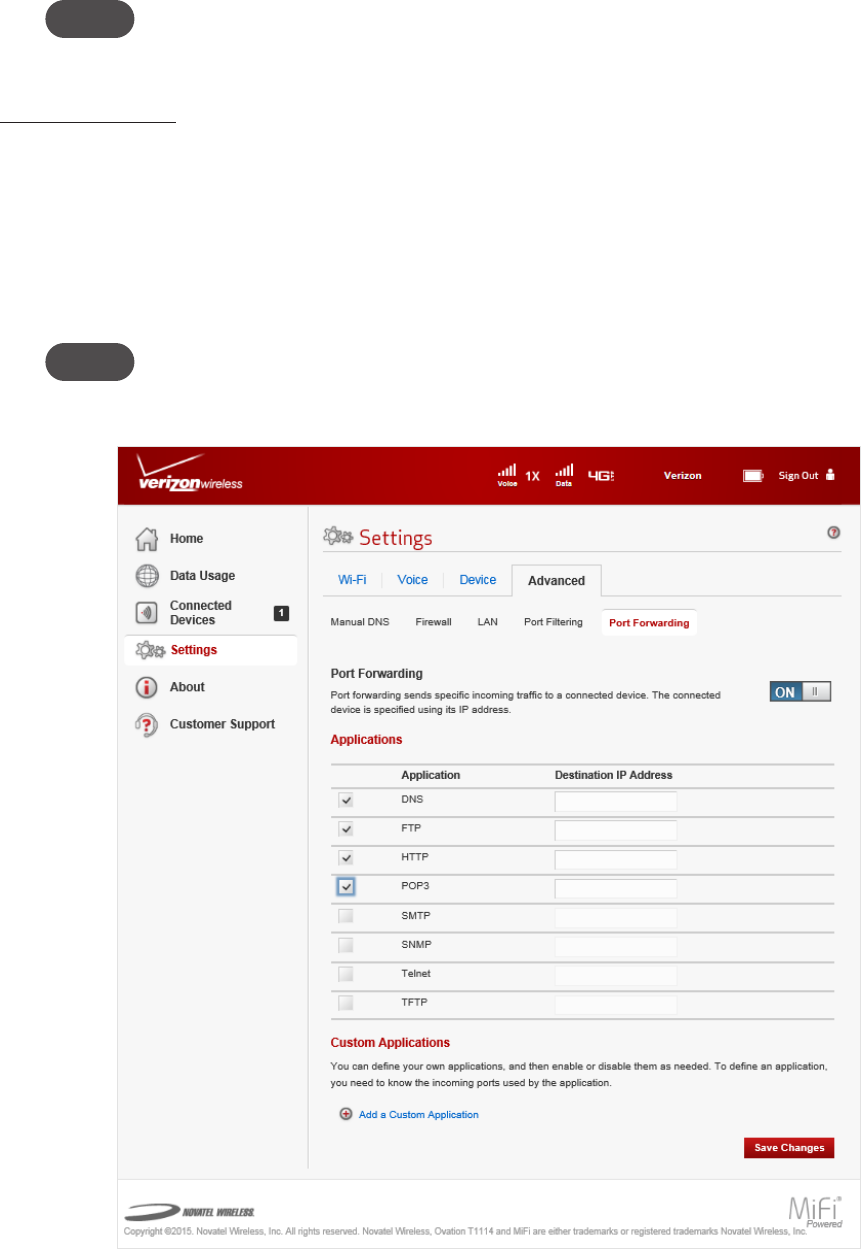
73
➎ Select the Delete checkbox next to any custom application you wish to remove and click
Save Changes.
NOTE Click on the Port Filtering menu tab again to remove deleted custom applications from view on the
screen.
Port Forwarding
Port Forwarding allows incoming trac from the Internet to be forwarded to a particular computer
or device on your Wi-Fi network. Normally, the built-in rewall blocks incoming trac from the
Internet. You use Port Forwarding to allow Internet users to access any server you are running on
your computer, such as a Web, FTP, or E-mail server.
For some online games, Port Forwarding must be used in order for the games to function correctly.
The use of Port Forwarding creates a security risk and should be turned o when not required.
NOTE Some Mobile Wireless Networks provide you with an IP address on their own network rather than
an Internet IP address. In this case, Port Forwarding cannot be used because Internet users cannot
reach your IP address.
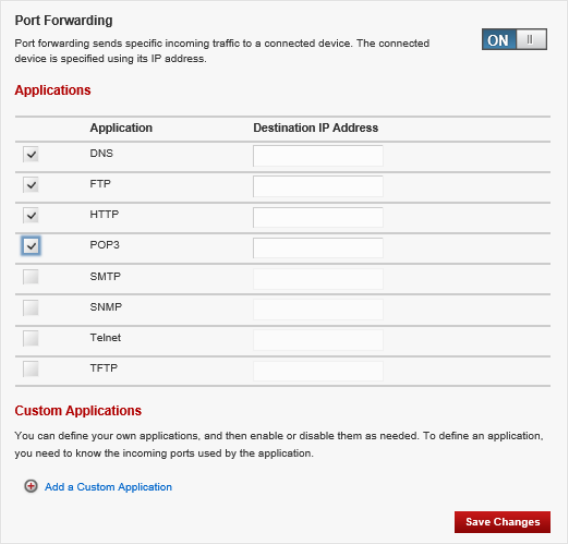
74
The Port Forwarding menu contains the following sections:
•Default Applications — Turn on each Port Forwarding application that needs to be able to
access the Internet by checking the box next to one or more applications.
•Custom Applications — You can dene your own Port Forwarding applications, and then turn
them on or o as needed. To dene an application, you need to know the outgoing ports
used by the application.
Applications
To turn on Port Forwarding Applications:
➊ Slide the Port Forwarding ON/OFF button to ON.
➋ Install the application on a computer connected to the LTE Internet and Home Phone’s Wi-Fi
network.
➌ On the computer, check its IP address for the Wi-Fi network. Alternatively, you can check the
computer’s IP address on the Connected Devices screen.
➍ Enter the computer’s IP Address in the Connected Device IP Address eld beside the
application.
➎ Turn on this application by selecting its checkbox.
➏ Click Save Changes.
➐ On the Current Status screen, make a note of the Internet IP address of this device.
➑ Ask users on the Internet to connect to the Internet IP address of this device. These
connection requests will be forwarded to the IP address specied in step 3.
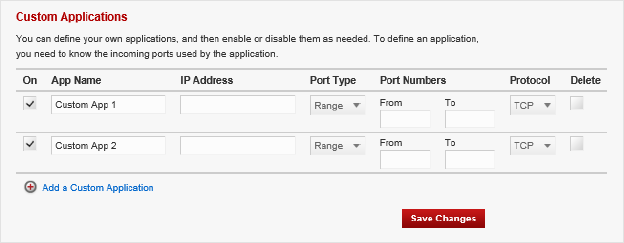
75
Custom Applications
Port Forwarding Custom Applications allow you to dene your own applications. Once dened,
these applications can be turned on and o in the same way as pre-dened applications. To dene
an application, you need to know the ports and protocol (TCP, UDP) used by the application for
incoming trac.
To add/delete Port Forwarding Custom Applications:
➊ Click Add a Custom Application.
➋ Enter a suitable name for the application you are adding.
➌ Enter the beginning and end of the port range for each application. Each application has its
own port range.
•For a single port, enter the port number in both the Start Port and End Port elds.
•For a port range, enter the beginning of the range in the Start Port eld and the end of
the range in the End Port eld.
➍ For each port range, select the protocol (TCP or UDP) used by that port range from the
Protocol dropdown menu.
➎ Enter the IP address of the connected device which will receive this trac.
➏ To remove a Port Filterting Custom Application, check the Delete checkbox for that
application.
➐ Click Save Changes.
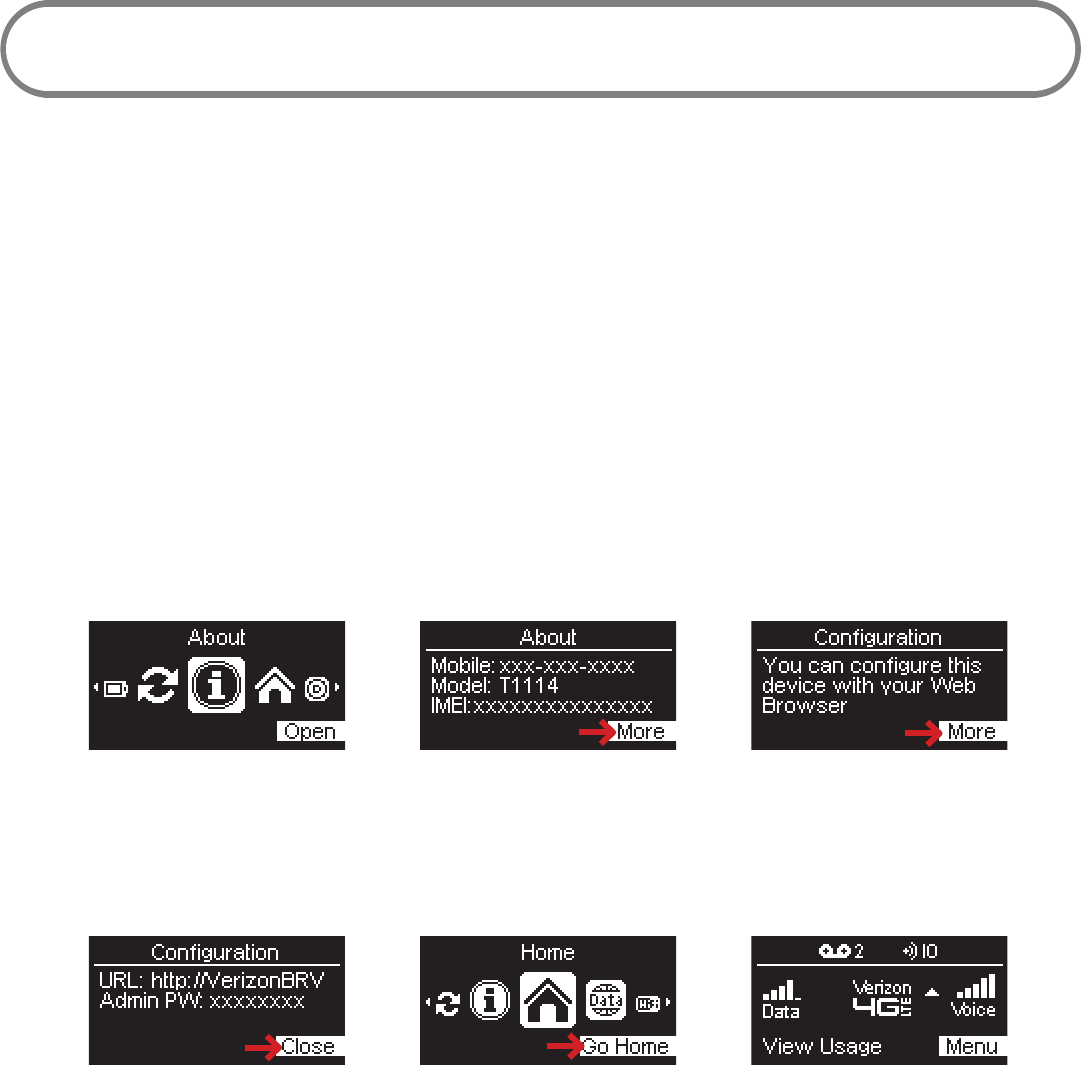
76
About
About allows you to view information about your LTE Internet and Home Phone, including the
mobile number, model, IMEI, web interface URL, Admin Password, internet status, device details,
diagnostics and logs.
On the LTE Internet and Home Phone Display
➊ To view detailed information about your router, press the select button on the Home screen
to display the Menu options.
➋ Use the scroll button to scroll to the About icon and press the select button to open the
About screen and display your mobile phone, model, and IMEI numbers.
➌ Select More > More to display the Admin screen showing the web interface URL address and
Admin Password.
➍ Select Close to return to the Menu options.
➎ Use the scroll button to scroll to the Home icon, and press Go Home to display the Home
page.
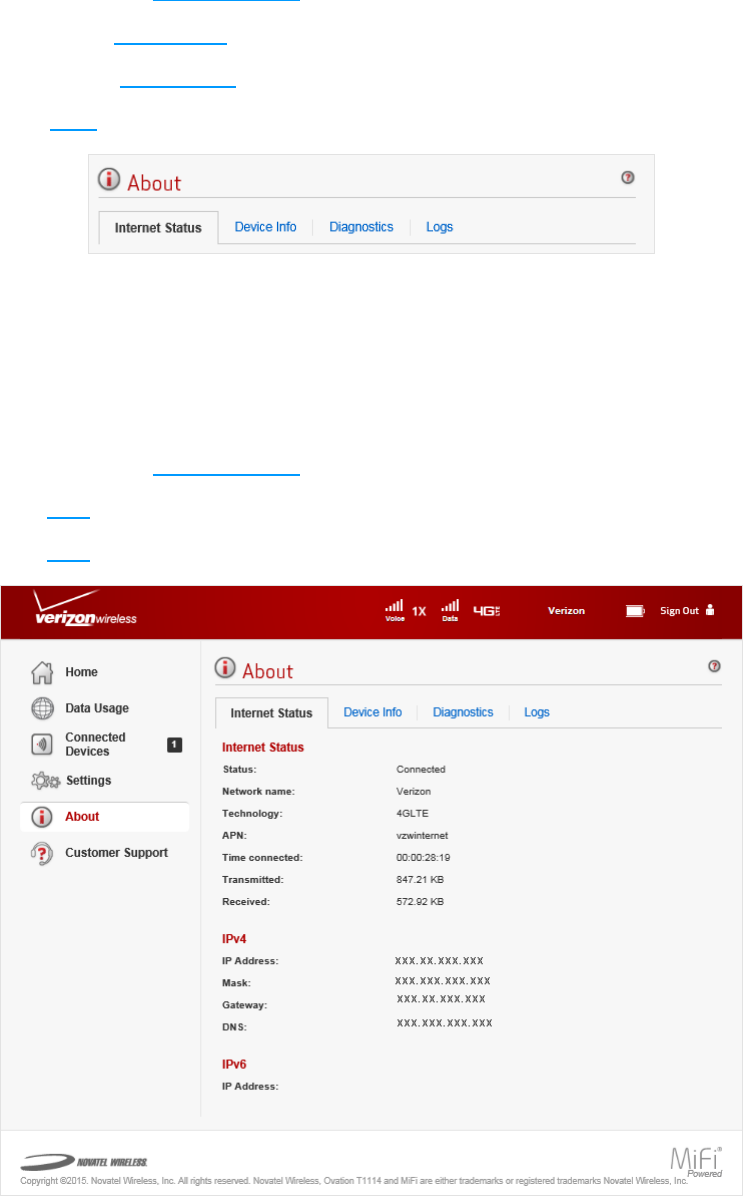
77
On the LTE Internet and Home Phone Web User Interface
The About page allows you to view detailed information about Internet status, device specic
information, diagnostics, troubleshooting and support. The About page contains the following
menu options:
•Internet Status (See Internet Status on page 77.)
•Device Info (See Device Info on page 79.)
•Diagnostics (See Diagnostics on page 80.)
•Logs (See Logs on page 84.)
Internet Status
The Internet Status page shows LTE Internet and Home Phone settings and status and contains the
following sections:
•Internet Status (See Internet Status on page 78.)
•IPv4 (See IPv4 on page 78.)
•IPv6 (See IPv6 on page 78.)
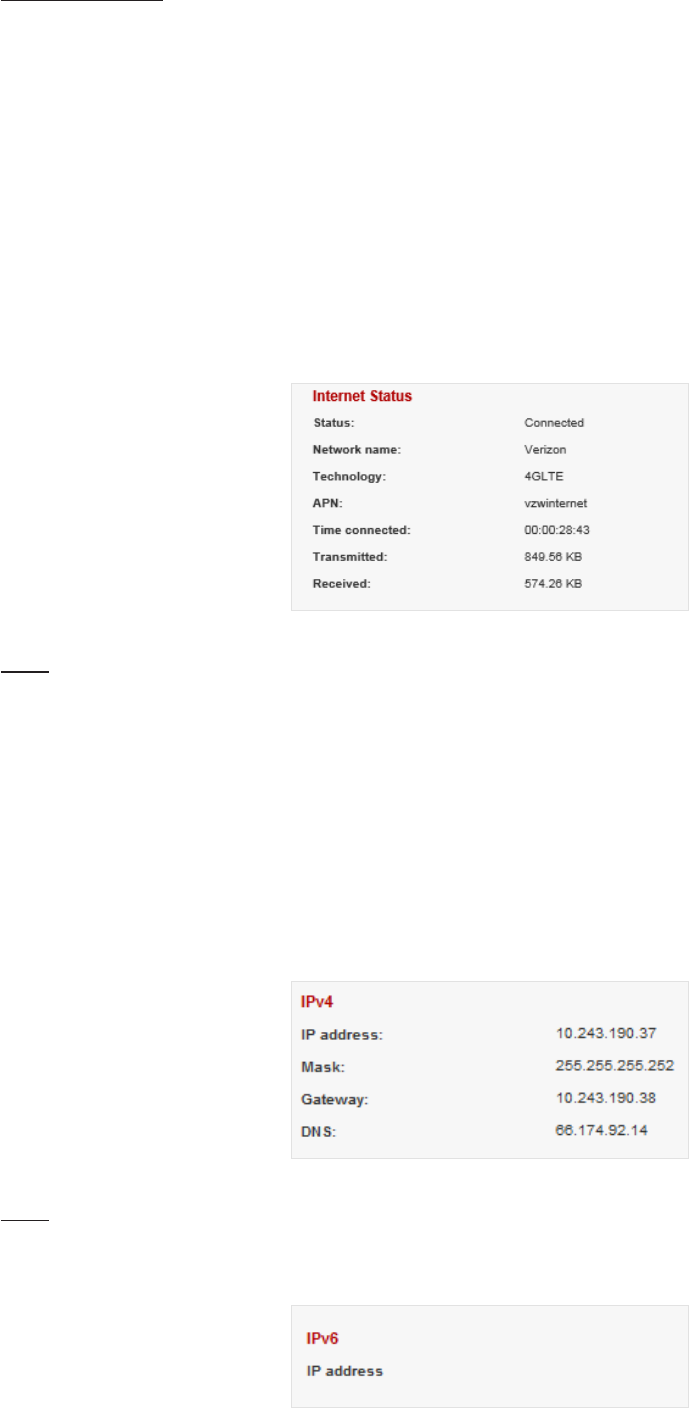
78
Internet Status
The Internet Status section has the following options:
•Status — displays the status of the Internet connection, usually Connected or
Disconnected or Dormant if no internet activity is occurring.
•Network name — displays the name of the network to which this LTE Internet and Home
Phone is currently connected.
•Technology — displays the type of technology used to connect to the Internet.
•Time connected — displays the time interval that the LTE Internet and Home Phone has
been connected to the network.
•Transmitted — displays the amount of data sent to the network.
•Received — displays the amount of data received from the network.
IPv4
The IPv4 section has the following options:
•IP Address — displays the IP address for the LTE Internet and Home Phone.
•Mask — displays the subnet mask network setting for the LTE Internet and Home Phone. The
default value 255.255.255.0 is standard for small (class "C") networks. If you change the LAN
IP Address, ensure you use the correct Subnet Mask for the IP address range containing the
LAN IP address.
•Gateway — displays the address of the server used to access the Internet.
•DNS — displays the address of the Domain Name Server (DNS).
IPv6
The IPv6 section has the following option:
•IP address — displays the IP address for the LTE Internet and Home Phone.
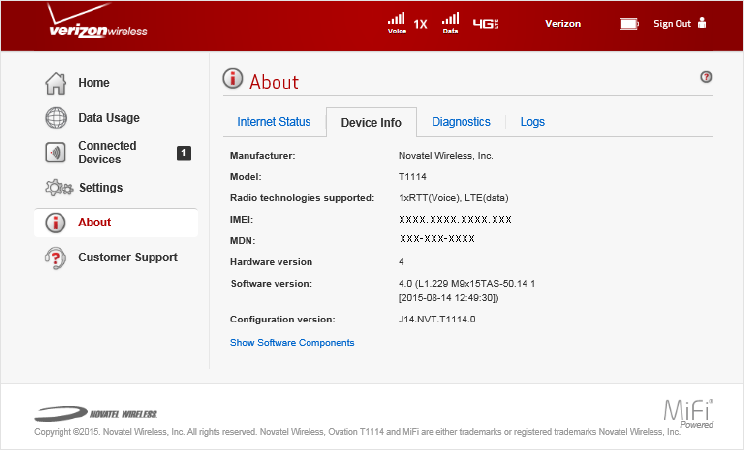
79
Device Info
The Device Info page contains detailed information about the LTE Internet and Home Phone and
contains the following sections:
•Manufacturer — the manufacturer of the LTE Internet and Home Phone.
•Model — the model number or name of the LTE Internet and Home Phone.
•Radio technologies supported — lists the radio technologies supported for the LTE Internet
and Home Phone
•IMEI — International Mobile Equipment Identity for this device.
•MDN — Mobile Directory Number (phone number) for this device.
•Hardware version — displays the hardware revision number.
•Software version — displays the version number of the currently installed software.
•OS version — the Operating System (OS), including its components, version.
•Modem FW version — modem rmware version.
•Wi-Fi FW version — Wi-Fi rmware version.
•Web UI version — web user interface version.
•Display UI version — displays the current user interface version.
•PRI version — displays the conguration version currently applied to the LTE Internet and
Home Phone.
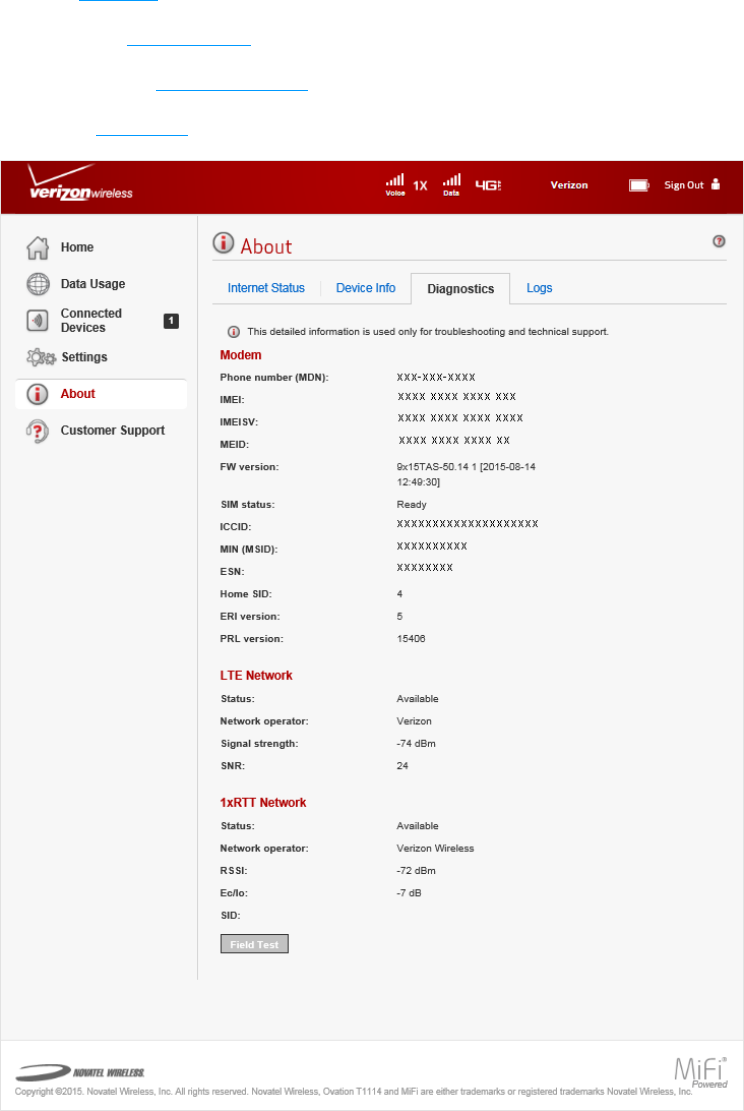
80
Diagnostics
The Diagnostics page shows information about the LTE Internet and Home Phone rmware and
other system-level information. You can also view the system log. This page is used mostly for
troubleshooting and is not required for normal operation. The Diagnostics page contains the
following sections:
•Modem (See Modem on page 81.)
•LTE Network (See LTE Network on page 82.)
•1xRTT Network (See 1xRTT Network on page 82.)
•Field Test (See Field Test on page 83.)
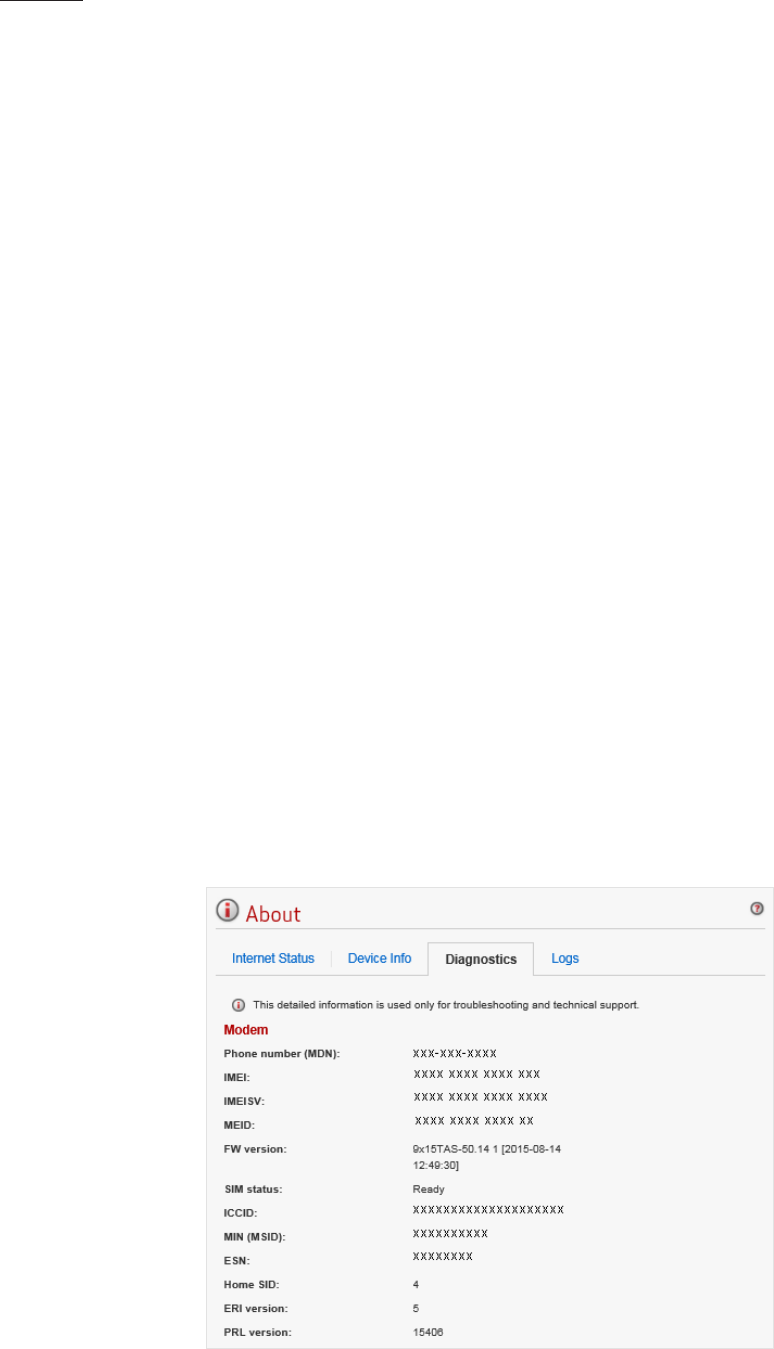
81
Modem
The Modem section has the following options:
•Phone number (MDN) — displays the Phone Number or Mobile Directory Number (MDN) is
used by the mobile data network to identify this particular data service.
•MEID — displays the Mobile Equipment Identier (MEID) is used by the mobile data network
to identify this particular modem.
•IMEI — displays the International Mobile Equipment Identity (IMEI) number for the LTE
Internet and Home Phone.
•IMEISV — displays the International Mobile Equipment Identity (IMEI) combined with an
approval number for the LTE Internet and Home Phone.
•FW version — displays the modem rmware version.
•SIM status — displays the status of the SIM card. If the SIM card is missing, or this eld
indicates some form of SIM error, the LTE Internet and Home Phone will not be able to
connect to the mobile network.
•ICCID — displays the ID number assigned to the SIM Card.
•MIN (MSID) — displays the Mobile Identication Number (MIN) or Mobile Station ID (MSID) is
the number associated with the home service provider and the wireless phone number.
•ESN — displays the Electronic Serial Number, which is either blank or a pseudo-ESN which is
not guaranteed to be unique for devices that use an MEID.
•Home SID — displays the system identier for the home network.
•ERI version — displays the Enhanced Roaming Indicator version that is currently installed.
•PRL version — displays the current version of the Preferred Roaming List (PRL), which tells
the modem which non-home carrier towers should provide roaming coverage.
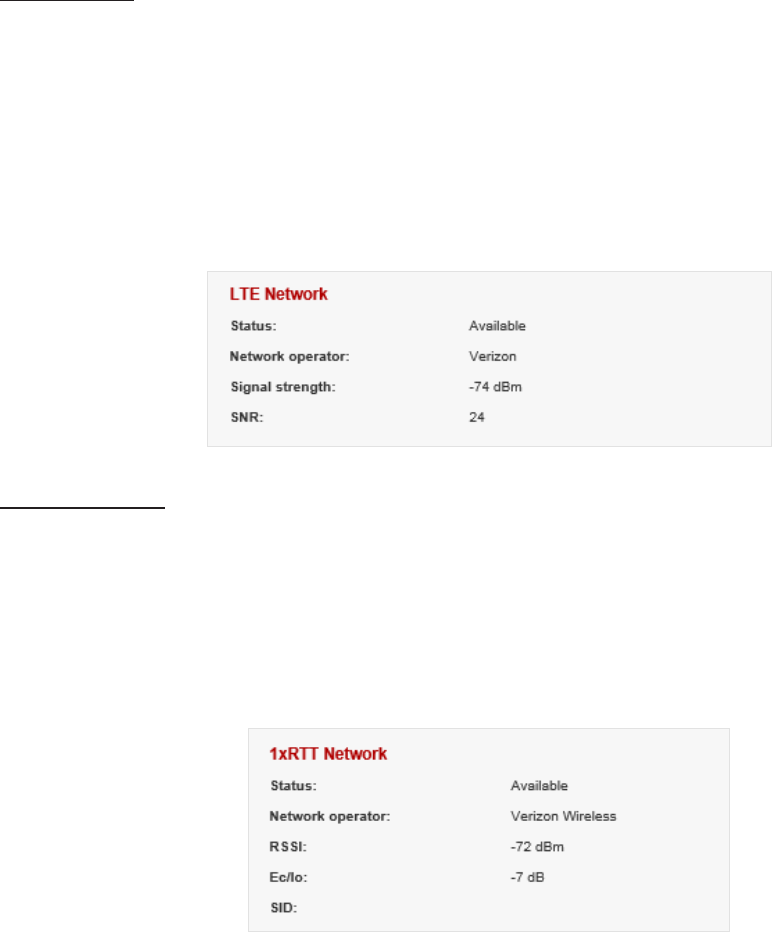
82
LTE Network
The LTE Network section has the following options:
•Status — displays status of the network (Disabled, Not available, or Available).
•Network operator — displays the vendor that currently provides wireless access.
•Signal strength — displays the current signal strength for LTE.
•SNR — displays the signal quality; the higher the number the better the signal.
1xRTT Network
The 3G Network (eHRPD/EVDO/1xRTT) section has the following options:
•Status — displays the status of the network (Disabled, Not available, or Available).
•RSSI (1x) — displays the RSSI for the 1xRTT signal.
•Ec/Io — A measure of how clean the signal is, and is a type of signal-to-noise ratio.
•SID — System identier for the network.
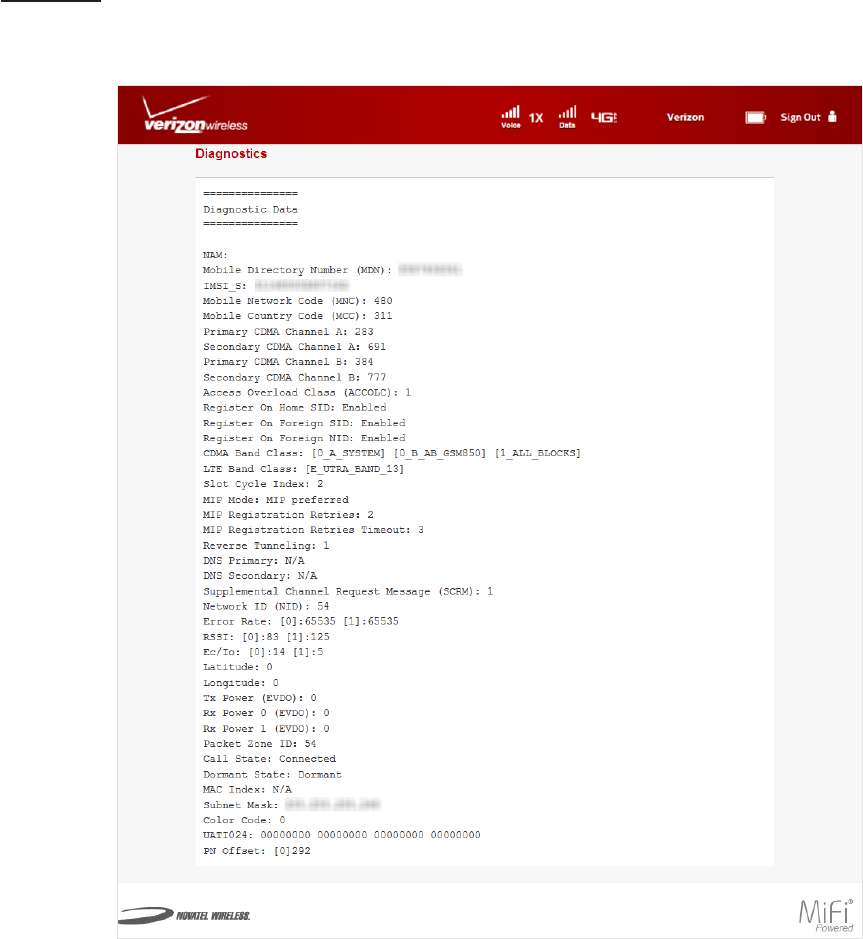
83
Field Test
Click on Field Test to provide a list of low-level network parameters which can be helpful for
technical support sta when they troubleshoot network connectivity issues.
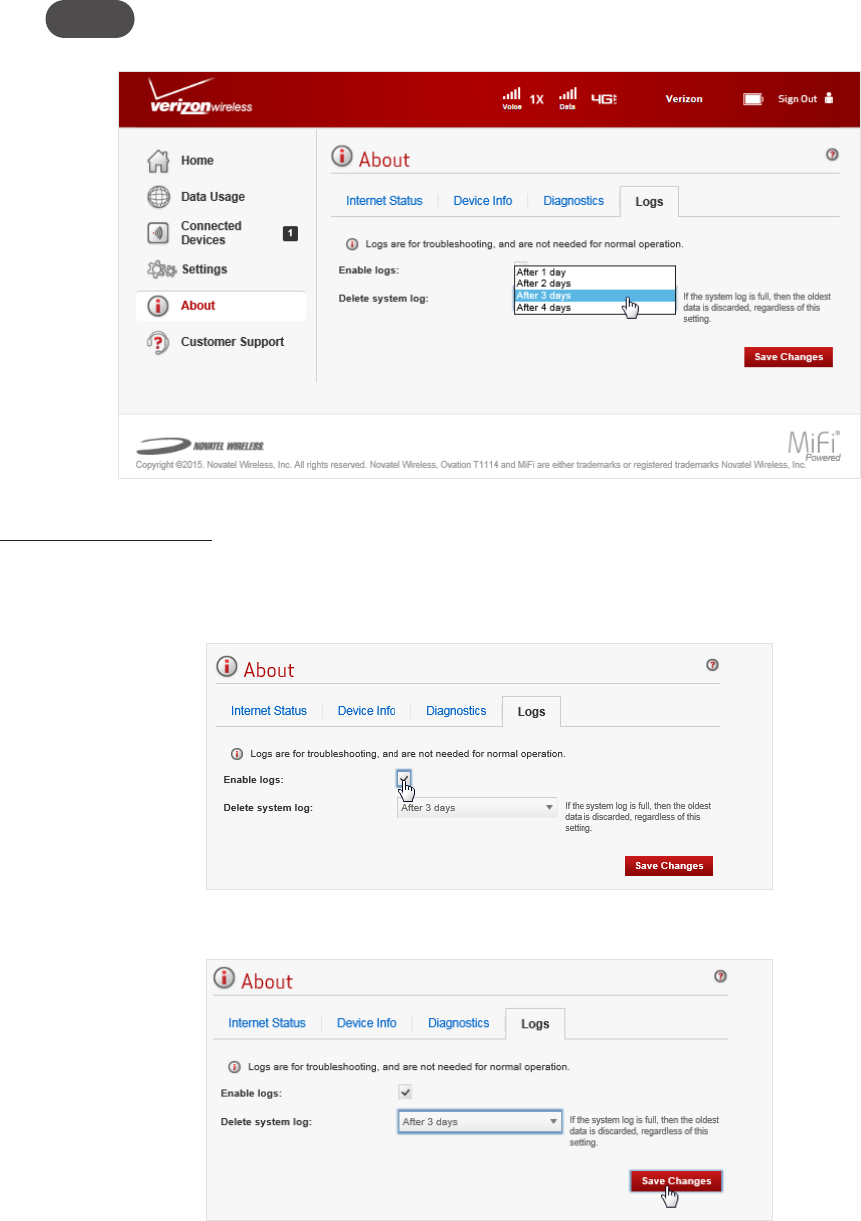
84
Logs
The Logs page allows you to turn logging on or o, and to delete system logs.
NOTE Logs record various operations and are used for troubleshooting and are not needed for normal LTE
Internet and Home Phone operation.
Enable System Logs
To turn on system logs, follow these steps:
➊ Select the checkbox next to Enable logs.
➋ Click Save Changes.
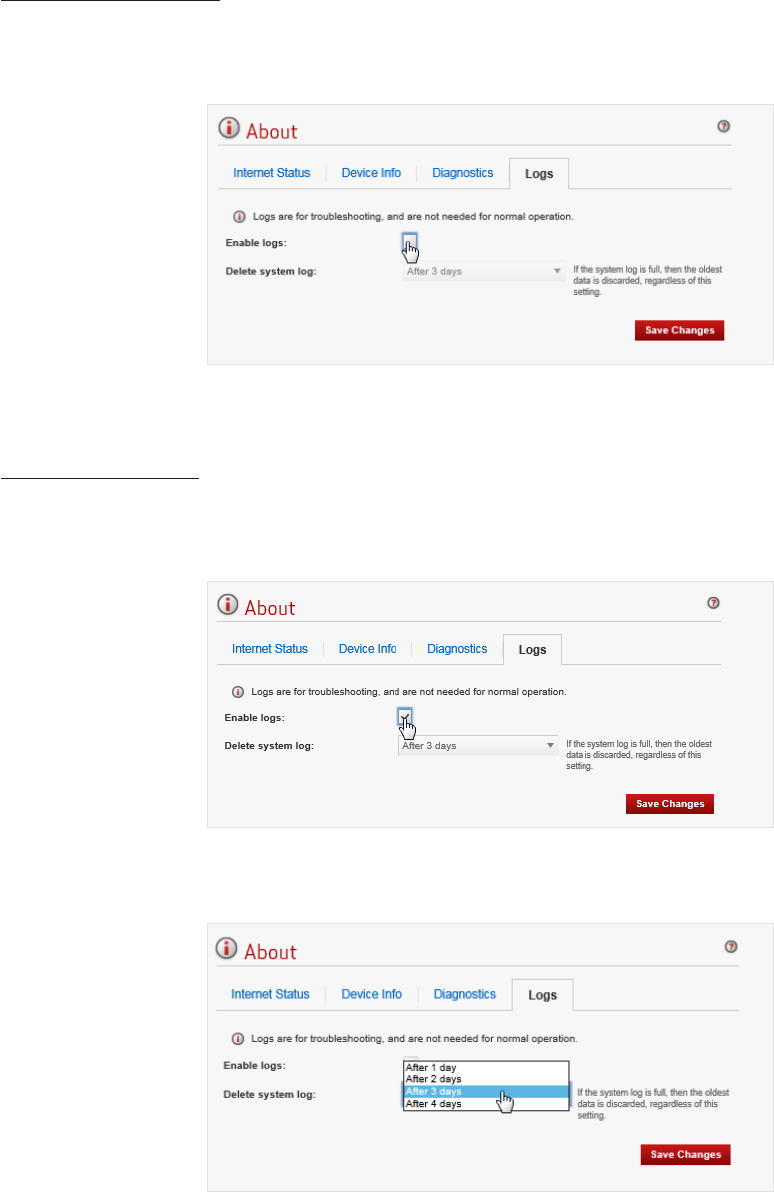
85
Disable System Logs
To turn o system logs, follow these steps:
➊ Deselect the checkbox next to Enable logs.
➋ Click Save Changes.
Delete System Log
To delete a system log, follow these steps:
➊ Select the checkbox next to Enable logs.
➋ Select the appropriate time period for the removal of system logs from the dropdown menu
next to Delete system log.
➌ Click Save Changes.
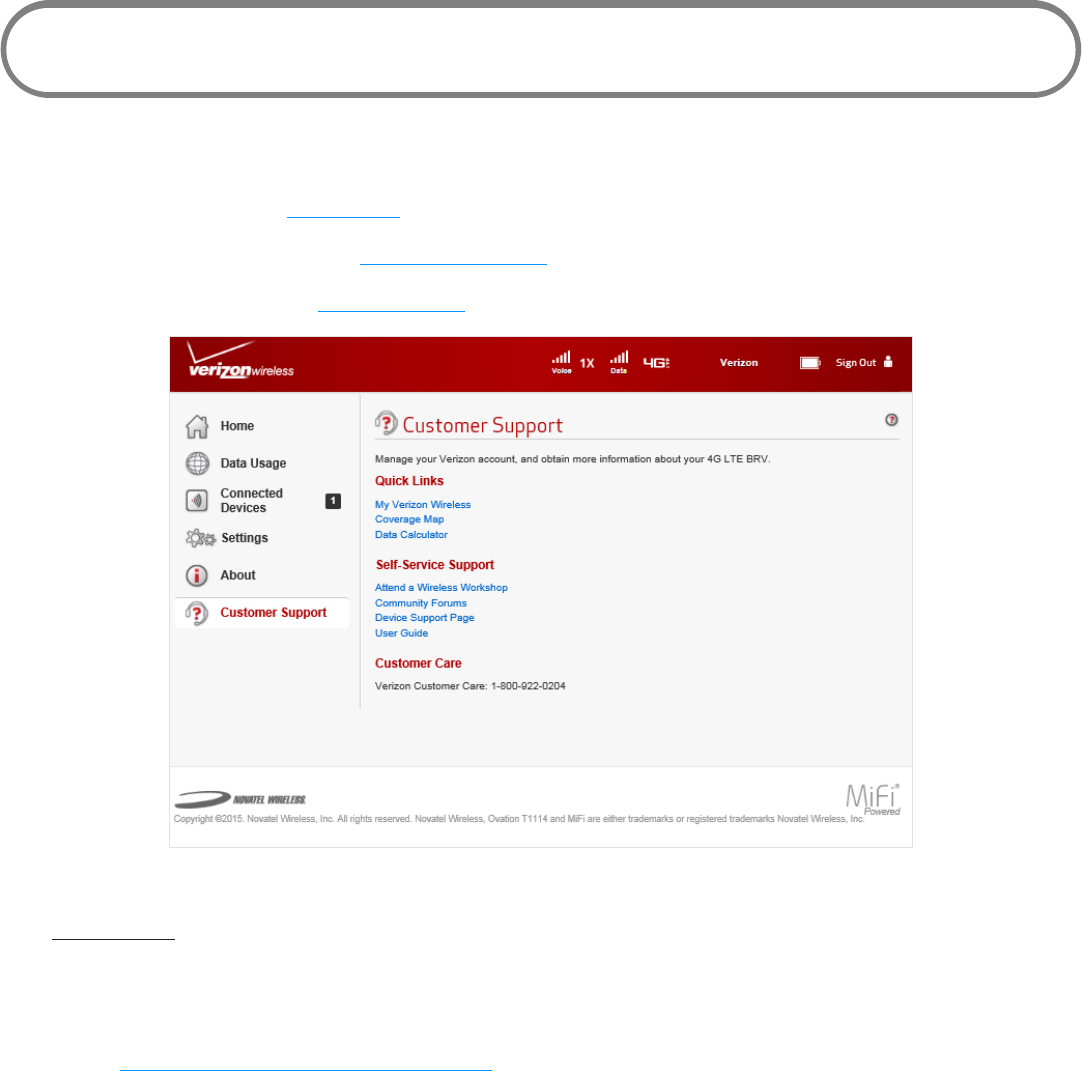
86
Customer Support
The Customer Support page contains the following sections:
•Quick Links (See Quick Links on page 86.)
•Self-Serve Support (See Self-Serve Support on page 87.)
•Customer Care (See Customer Care on page 87.)
Quick Links
The Quick Links section has the following options:
•My Verizon Wireless — My Verizon Wireless allows you to manage your account, pay your
bill, purchase accessories and more. Click on My Verizon Wireless to register or go to
www.verizonwireless.com/myverizon.
•Coverage Map — displays the Verizon Wireless coverage area. Also available using Home > My
Account & Tools on the LTE Internet and Home Phone Web User Interface.
•Data Calculator — calculate your data usage and select the best plan to meet your data
requirements. Also available using Home > My Account & Tools on the LTE Internet and Home
Phone Web User Interface.

87
Self-Serve Support
The Self-Serve Support section has the following options:
•Attend a Wireless Workshop— click on Attend a Wireless Workshop to attend a free Wireless
Workshop online or in a store to learn everything you need to know about your LTE Internet
and Home Phone. (You can also open your browser and type https://vzwworkshops.
verizonwireless.com/vzwworkshops/.)
•Community Forums — click on Community Forums to follow, share and participate in the
Broadband & Netbook Community. In addition, you can search Broadband & Netbook
Community discussions for specic topics. (You can also open your browser and type https://
community.verizonwireless.com/community/broadband.)
•Device Support Page — click on Device Support Page to join and discuss the latest news in
Verizon Wireless products, services, and more. (You can also open your browser and type
https://community.verizonwireless.com/welcome.)
•User Guide — click on User Guide to access an online version of the LTE Internet and Home
Phone User Guide. (You can also open your browser and type http://VerizonBRV/Customer
Care.)
Customer Care
Verizon Customer Care: 1.800.922.0204

89
Overview
When properly installed, the LTE Internet and Home Phone is a highly reliable product. Most
problems are caused by one of these issues:
•Phones or ethernet devices connected to incorrect ports. Please refer to the labels next to
the ports for proper connections.
•Network coverage is unavailable due to coverage area, an account problem, or a network
problem. To display a Verizon Wireless coverage map, see Verizon Wireless Coverage map.
The following tips can help solve many common problems encountered while using the LTE
Internet and Home Phone.
First Steps
•Make sure you are using the LTE Internet and Home Phone in the correct geographic region.
•Ensure that your wireless coverage extends to your current location.
•If you do not receive a strong voice or data signal, move the device to a dierent location.
•Ensure you have an active subscription plan.
•Restarting your computer and your LTE Internet and Home Phone can resolve many issues.
IMPORTANT Before contacting support, be sure to restart both your computer and your
LTE Internet and Home Phone.

90
Common Problems and Solutions
The following are some common problems and solutions.
Why am I not getting a dial tone on my handset?
•Ensure that the power adaptor is properly connected and that the power indicator is
illuminated.
•Check to make sure the phone cable is securely plugged in.
•Check to make sure you are not roaming outside of the Verizon Wireless network.
Can I create a shortcut to access my voice mail?
The availability of a shortcut feature to access voice mail messages depends solely on the
capabilities of the corded or cordless phone that you use with the LTE Internet and Home Phone.
Please refer to the user material that came with your phone.
If your home phone does not support a shortcut feature to access voice messages, you may have
the option to save your voice mail number into the address book on the handset and assign that
number to the #1 speed dial position on your phone’s keypad. Remember, you can always dial *86
to accessyour voice mail.
Can I use my phone answering device instead of voice mail?
Yes. Set the answering device to fewer rings in order to pick up the call before Verizon
Wireless voice mail. Alternatively, turn o your home answering machine or increase the
number of rings if you would like to use the Verizon Wireless voice mail service. Please refer
to the user material provided by the home answering machine manufacturer for
instructions.
Does 911 work on this device?
Yes, but since the LTE Internet and Home Phone is designed for an indoor environment,
please be prepared to provide your location inside the premises to public service
personnel. The GPS chipset embedded in this device will work best if the device is located
near a window or other opening.
Does the LTE Internet and Home Phone work during a power outage?
While the LTE Internet and Home Phone has a backup battery, if the landline device
requires external power to operate, service (including the ability to make and receive E911
calls) will not be available during a power outage. Service will only be available during a power
outage if the home phone connected to the device does not rely on external power to operate (as is
the case with many corded phones).
Only voice service will be available during a power outage. Data service will not be available.

91
How long is the backup battery life of the LTE Internet and Home Phone?
Talk usage time on backup battery is approximately 4 hours and standby time is approximately 33
hours. Internet connectivity is disabled to preserve talk time when in backup battery mode. Actual
values can vary with environmental conditions.*
How does Caller ID (CID) work?
CID allows you to see the caller’s name and/or phone number before you take the call. Monthly
subscription charges may apply. Please consult your carrier for further information.
Can I adjust the volume on my phone?
You can adjust the volume using your phone connected to the LTE Internet and Home Phone. Four
volume levels are available, with level 1 being the softest and level 4 the loudest. The default setting
is level 4.
➊ Take the phone o the hook so you can hear the dial tone and verify that phone service is
available.
➋ Press ## to adjust the volume.
➌ Press keys 1 to 4 to select the desired volume.
➍ After selecting the desired volume, press the * key to save it. If you hear a single
conrmation tone, you have successfully set the volume level.
NOTE If you hear a double tone you have pressed an incorrect key. The system will return to the off-hook
state, and you can try adjusting the volume again when you hear the dial tone.
Why do I get the recording, "Call cannot be completed as dialed?"
Check the number to ensure you’re dialing correctly, without pauses longer than two seconds
between dialed digits. If you require more than two seconds between dialed digits, you can change
the time interval setting using the Web User Interface at http://verizonbrv/
How do I reset the Wi-Fi and Router settings back to factory settings?
To reset the Wi-Fi and router settings:
➊ Connect to LTE Internet and Home Phone. Open a web browser on the connected device
and enter http://VerizonBRV/ or http://192.168.1.1 in your browser.
➋ Open the LTE Internet and Home Phone Backup and Restore page after Signing In to the
Web User Interface. (See Backup and Restore on page 65.) The Backup and Restore page
has a Restore to Factory Defaults button. This button resets all Wi-Fi and Router settings to
their factory default values. All existing settings are lost.
* If the router is disconnected from AC power and running on the battery alone, only voice calls are supported. A phone that does
not require separate electric power is required to place or receive calls (including 911) during a power outage.

92
How do I reset the LTE Internet and Home Phone back to factory
settings?
The master reset button is in a small hole located on the bottom of the LTE Internet and Home
Phone battery cover. This button returns the device to factory settings, including resetting the Wi-Fi
Name (SSID) and Password and Admin Password.
To reset the LTE Internet and Home Phone:
➊ Place one end of an unfolded paper clip into the master reset button hole.
➋ Press the paper clip on the button until the display shows "Verizon Powering O" (about ve
to six seconds), then your LTE Internet and Home Phone will restart.
WARNING! The "Reset to Factory Defaults" operation overwrites ALL existing settings. If
the Wi-Fi settings change, you will lose this connection, and need to reconnect using the new
settings.
Master Reset Button Hole

93
Technical Support
IMPORTANT Before contacting support, be sure to re-start both your computer and the LTE
Internet and Home Phone and perform the trouble shooting steps in this guide.
Technical Support
For additional information and technical support, visit any Verizon Wireless store, the online support
page at http://Verizonwireless,com/support, or contact Customer Service at 1-800-922-0204 if
additional help is required.

95
Product Specications
General
Name: Verizon LTE Internet and Home Phone
Model: T1114
Standards/Approvals/Certications: FCC (North America)/RoHS
Weight: 420 g / 14.8 oz
Dimensions: 138.2 mm x 80.2 mm x 173.3 mm,
5.44 in x 3.16 in x 6.8 in
Wireless Network LTE, CDMA 1xRTT
Wireless Network – Wi-Fi Mode 802.11 a/b/g/n
Default SSID Verizon-4GLTE-BRV-XXXX
Battery
•Size
•Time required for full charge
2150 mAh
2.5 - 3 hours (when not in use)
Chip Set: QUALCOMM® MDM9615
Interface Types: Ethernet (3)/Phone (RJ-11 (2)/Optional external
antenna (2)
LED: Power, Wi-Fi, LAN, WPS, WWAN
GPS: A-GPS for E911 only
Technology/Bands
Technology: 4G LTE, CDMA
Band Designation: 4G LTE: B4 (700 MHz)/B13 (1700/2100 MHz)
CDMA 1xRTT: 800/1900 MHz
LTE Transmit Band: 746-763 MHz/1720-1755 MHz
LTE Receive Band: 776-793 MHz/2110-2155 MHz
CDMA Transmit Band: 824.7-848.31 MHz/1851.25-1908.75 MHz
CDMA Receive Band: 869.7-893.31 MHz/1931.25-1988.75 MHz
Environmental
Operating Temperature: -10 ° C to +55° C (14°F to 131° F)
Storage Temperature: -40 ° C to +85° C (-40°F to 185° F)
Drop: 1 meter (3.28 feet) drop, no damage – fully
operational
Vibration Stability: 5 Hz to 500 Hz, 0.1 octave/second
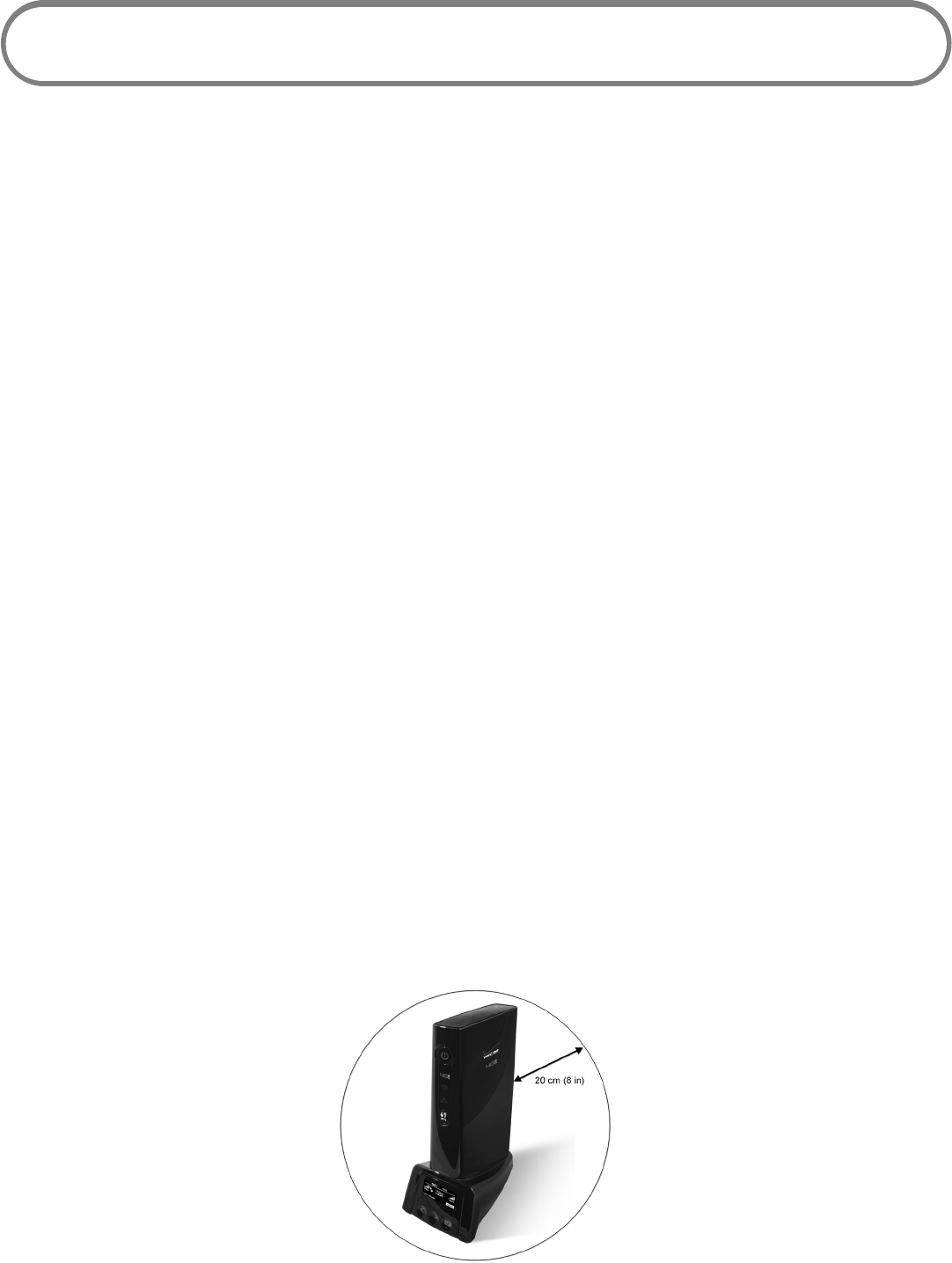
96
Regulatory Information
FEDERAL COMMUNICATIONS COMMISSION NOTICE (FCC - UNITED STATES)
Electronic devices, including computers and wireless modems, generate RF energy incidental to their intended function
and are therefore subject to FCC rules and regulations.
This equipment has been tested to, and found to be within the acceptable limits for a Class B digital device, pursuant to
part 15 of the FCC Rules. These limits are designed to provide reasonable protection against harmful interference when
the equipment is operated in a residential environment.
This equipment generates radio frequency energy and is designed for use in accordance with the manufacturer’s user
manual. However, there is no guarantee that interference will not occur in any particular installation. If this equipment
causes harmful interference to radio or television reception, which can be determined by turning the equipment off and
on, you are encouraged to try to correct the interference by one or more of the following measures.
•Reorient or relocate the receiving antenna.
•Increase the separation between the equipment and the receiver.
•Connect the equipment into an outlet on a circuit dierent from that to which the receiver is connected.
•Consult the dealer or an experienced radio/television technician for help.
This device complies with Part 15 of the Federal Communications Commission (FCC) Rules for EMI compliance.
Operation is subject to the following two conditions:
1. This device may not cause harmful interference.
2. This device must accept any interference received, including interference that may cause undesired operation.
WARNING: DO NOT ATTEMPT TO SERVICE THE WIRELESS COMMUNICATION DEVICE YOURSELF. SUCH ACTION
MAY VOID THE WARRANTY. THE T1114 IS FACTORY TUNED. NO CUSTOMER CALIBRATION OR TUNING IS REQUIRED.
CONTACT NOVATEL WIRELESS, INC. TECHNICAL SUPPORT FOR INFORMATION ABOUT SERVICING YOUR WIRELESS
COMMUNICATION DEVICE.
FCC CAUTION: Any changes or modification not expressly approved by the party responsible for compliance could void
the user’s authority to operate this equipment.
MODIFICATIONS: The FCC requires that you be notified that any changes or modifications made to this device that are
not expressly approved by Novatel Wireless may void your authority to operate the equipment.
NOTE: The Radio Frequency (RF) emitter installed in your modem must not be located or operated in conjunction with
any other antenna or transmitter, unless specifically authorized by Novatel Wireless Technologies.
RF Exposure Content
FCC Equipment Authorization ID: PKRNVWT1114
This device is authorized for use in mobile applications. At least 20 cm (8 in) of separation between the router and the
user’s body must be maintained at all times.

97
Wireless Communications
IMPORTANT Due to the transmission and reception properties of wireless communications,
data occasionally can be lost or delayed.
This can be due to the variation in radio signal strength that results from changes in the
characteristics of the radio transmission path. Although data loss is rare, the environment where you
operate the modem might adversely aect communications.
Variations in radio signal strength are referred to as fading. Fading is caused by several dierent
factors including signal reection, the ionosphere, and interference from other radio channels.
Novatel Wireless or its partners will not be held responsible for damages of any kind resulting from
the delays or errors in data transmitted or received with the Verizon LTE Internet and Home Phone
device, or failure of the Verizon LTE Internet and Home Phone device to transmit or receive such
data.

98
Limited Warranty and Liability
Novatel Wireless, Inc. warrants for the 12-month period immediately following receipt of the
Product by Purchaser that the Product will be free from defects in material and workmanship under
normal use. THESE WARRANTIES ARE EXPRESSLY IN LIEU OF ALL OTHER WARRANTIES, EXPRESS OR
IMPLIED, INCLUDING, WITHOUT LIMITATION, ALL IMPLIED WARRANTIES OF MERCHANTABILITY AND
FITNESS FOR A PARTICULAR PURPOSE.
The exclusive remedy for a claim under this warranty shall be limited to the repair or replacement,
at Novatel Wireless’ option, of defective or non-conforming materials, parts or components. The
foregoing warranties do not extend to (I) non conformities, defects or errors in the Products due
to accident, abuse, misuse or negligent use of the Products or use in other than a normal and
customary manner, environmental conditions not conforming to Novatel Wireless’ specication, of
failure to follow prescribed installation, operating and maintenance procedures, (II) defects, errors or
nonconformities in the Product due to modications, alterations, additions or changes not made in
accordance with Novatel Wireless’ specications or authorized by Novatel Wireless, (III) normal wear
and tear, (IV) damage caused by force of nature or act of any third person, (V) shipping damage,
(VI) service or repair of Product by the purchaser without prior written consent from Novatel
Wireless, (VII) products designated by Novatel Wireless as beta site test samples, experimental,
developmental, reproduction, sample, incomplete or out of specication Products, or (VIII) returned
products if the original identication marks have been removed or altered.

99
Safety Hazards
Do not operate the Verizon LTE Internet and Home Phone in an environment that might be
susceptible to radio interference resulting in danger, specically:
Areas where prohibited by the law
Follow any special rules and regulations and obey all signs and notices. Always turn o the host
device when instructed to do so, or when you suspect that it might cause interference or danger.
Where explosive atmospheres might be present
Do not operate your device in any area where a potentially explosive atmosphere might exist.
Sparks in such areas could cause an explosion or re resulting in bodily injury or even death. Be
aware and comply with all signs and instructions.
Users are advised not to operate the device while at a refueling point or service station. Users are
reminded to observe restrictions on the use of radio equipment in fuel depots (fuel storage and
distribution areas), chemical plants or where blasting operations are in progress.
Areas with a potentially explosive atmosphere are often but not always clearly marked. Potential
locations can include gas stations, below deck on boats, chemical transfer or storage facilities,
vehicles using liqueed petroleum gas (such as propane or butane), areas where the air contains
chemicals or particles, such as grain, dust or metal powders, and any other area where you would
normally be advised to turn o your vehicle engine.
Near medical and life support equipment
Do not operate your device in any area where medical equipment, life support equipment, or near
any equipment that might be susceptible to any form of radio interference. In such areas, the host
communications device must be turned o. The device can transmit signals that could interfere
with this equipment.
On an aircraft, either on the ground or airborne
In addition to FAA requirements, many airline regulations state that you must suspend wireless
operations before boarding an airplane. Please ensure that the modem is turned o prior to
boarding aircraft in order to comply with these regulations. The modem can transmit signals that
could interfere with various onboard systems and controls.
While operating a vehicle
The driver or operator of any vehicle should not operate a wireless data device while in control of a
vehicle. Doing so will detract from the driver or operator’s control and operation of that vehicle. In
some countries, operating such communications devices while in control of a vehicle is an oense.
100
Electrostatic discharge (ESD)
Electrical and electronic devices are sensitive to electrostatic discharge (ESD). Macintosh native
connection software might attempt to reinitialize the device should a substantial electrostatic
discharge reset the device. If the software is not operational after an ESD occurrence, then restart
your computer.

101
Proper Battery Use and Disposal
IMPORTANT In event of a battery leak:
• Do not allow the liquid to come in contact with the skin or the eyes. If contact has been
made, wash the affected area with large amounts of water and seek medical advice.
• Seek medical advice immediately if a battery has been swallowed.
• Communicate the appropriate steps to be taken if a hazard occurs. Due to the transmission
and reception properties of wireless communications, data occasionally can be lost or
delayed.
Please review the following guidelines for safe and responsible battery use.
•Do not disassemble or open, crush, bend or deform, puncture, or shred.
•Do not modify or remanufacture, attempt to insert a foreign object into the battery, immerse
or expose to water or other liquids, or expose to re, explosion, or other hazard.
•Only use the battery for the system for which it was specied.
•Only use the battery with a charging system that has been qualied with the system per
this standard. Use of an unqualied battery or charger may present a risk of re, explosion,
leakage, or other hazard.
•Do not short circuit a battery or allow a metallic or conductive object to contact the battery
terminals.
•Replace the battery only with another battery that has been qualied with the system per
this standard. Use of an unqualied battery may present a risk of re, explosion, leakage, or
other hazard.
•Promptly dispose of used batteries in accordance with local regulations.
•Battery usage by children should be supervised.
•Avoid dropping the LTE Internet and Home Phone or battery. If the LTE Internet and Home
Phone or the battery is dropped, especially on a hard surface, and the user suspects damage,
take it to a service center for inspection.
•Improper battery use may result in a re, explosion, or other hazard.

Glossary
6

103
Glossary
● 1X — The core CDMA2000 wireless air interface standard. The designation "1X", meaning 1 times Radio
Transmissio Technology, indicates the same radio frequency (RF) bandwidth as IS-95: a duplex pair of
1.25 MHz channels. The 1X standard supports packet data speeds of up to 153 kbits/s with real world
data transmission averaging 80-100 kbit/s in most commercial applications.
● 3G — Third Generation. 3G refers to the third generation of mobile telephony technology. 3G
telecommunication networks support services that provide an information transfer rate of at least 200
kbit/s. However, many services advertised as 3G provide higher speed than the minimum technical
requirements for a 3G service. 3G finds application in wireless voice telephony, mobile Internet access,
fixed wireless Internet access, video calls and mobile TV.
● 4G LTE — Fourth Generation Long Term Evolution. LTE is a standard for wireless data communications
technology and an evolution of the GSM/UMTS standards. The goal of LTE is to increase the capacity
and speed of wireless data networks using new DSP (digital signal processing) techniques and
modulations that were developed around the turn of the millenium. A further goal is the redesign and
simplification of the network architecture to an IP-based system with significantly reduced transfer
latency compared to the 3G architecture. The LTE wireless interface is incompatible with 2G and 3G
networks, so that it must be operated on a separate wireless spectrum.
● 802.11 (b, g, n) — A set of WLAN Wi-Fi communication standards in the 2.4, 3.6 and 5 GHz frequency
bands.
● bps — Bits per second. The rate of data flow.
● Broadband — High-capacity high-speed transmission channel with a wider bandwidth than
conventional modem lines. Broadband channels can carry video, voice, and data simultaneously.
● CDMA — Code Division Multiple Access. It is the underlying channel access method used by some
mobile phone standards.
● DHCP — Dynamic Host Configuration Protocol. Software found in servers and routers that
automatically assigns IP addresses and other configuration data to computers, tablets, printers, and
other devices connected to the IP network.
● DHCP Server — A server or service with a server that assigns IP addresses.
● DNS — Domain Name System. A system for converting host names and domain names into IP
addresses on the Internet or on local networks that use the TCP/IP protocol.
● EDGE — Enhances Data rates for GSM Evolution. A digital mobile phone technology that allows
improved data transmission rates as a backward-compatible extension of GSM.
● EV-DO Rev 0 — CDMA EV-DO Rev. 0 is a leading-edge 3G wireless technology with higher data rates
and higher system capacity. It is a fully backward compatible standard and remains interoperable
with deployed EV-DO networks and devices around the world. Rev 0 provides access to mobile
devices with forward link speeds of up to 2.4 Mbit/s, and reverse link speeds up to 152 kbit/s. For more
information, visit www.cdg.org.

104
● EV-DO Rev A — CDMA EV-DO Rev. A is a leading-edge 3G wireless technology with higher data rates
and higher system capacity. It is a fully backward compatible standard and remains interoperable with
deployed EV-DO networks and devices around the world. Rev A provides access to mobile devices
with forward link speed of up to 3.1 Mbit/s, and reverse link speeds up to 1.8 Mbit/s. The increased
data rates on Rev. A’s physical layer enable richer applications and services. For more information, visit
www.cdg.org.
● Firmware — A computer program embedded in an electronic device. Firmware usually contains
operating code for the device.
● GB — Gigabyte. A multiple of the unit byte for digital information storage. Usage depends on context.
When referring to disk capacities it usually means 109 bytes. It also applies to data transmission
quantities over telecommunication circuits.
● Hotspot — A Wi-Fi (802.11) access point or the area covered by an access point. Used for connecting
to the Internet.
● HTTP — Hypertext Transfer Protocol. An application-level protocol for accessing the World Wide Web
over the Internet.
● IEEE — Institute of Electrical and Electronics Engineers. An international technical/professional society
that promotes standardization in technical disciplines.
● IMEI — International Mobile Equipment Identity. Used in LTE networks to identify the device. It is
usually printed on the device and can often be retrieved using a USSD code.
● IP — Internet Protocol. The mechanism by which packets are routed between computers on a
network.
● IP Type — The type of service provided over a network.
● IP address — Internet Protocol address. The address of a device attached to an IP network (TCP/IP
network).
● ISP — Internet Service Provider. Also referred to as the service carrier, an ISP provides Internet
connection service. (See Network Operator)
● Kbps — Kilobits per second. The rate of data flow.
● LAN — Local Area Network. A type of network that lets a group of computers, all in close proximity
(such as inside an office building), communicate with one another. It does not use common carrier
circuits though it can have gateways or bridges to other public or private networks.
● MAC Address — Media Access Control. A number that uniquely identifies each network hardware
device. MAC addresses are 12-digit hexadecimal numbers. This is also known as the physical or
hardware address.
● Mbps — Megabits per second. The rate of data flow.
● MSID — Mobile Station IDentifier. A number for a mobile phone that identifies that phone to the
network. These numbers are carrier specific.
● Network Operator — The vendor who provides your wireless access. Known by different names in
different regions, some examples are: wireless provider, network provider, and service provider.
● Network Technology — The technology on which a particular network provider’s system is built; such
as CDMA or EVDO.
105
● Port — A virtual data connection used by programs to exchange data. It is the endpoint in a logical
connection. The port is specified by the port number.
● Port Forwarding — A process that allows remote devices to connect to a specific computer within a
private LAN.
● Port Number — A 16-bit number used by the TCP and UDP protocols to direct traffic on a TCP/IP
host. Certain port numbers are standard for common applications.
● PRL — Preferred Roaming List. A list that your wireless phone or device uses to determine which
networks to connect with when you are roaming. (Network operator specific).
● Protocol — A standard that enables connection, communication, and data transfer between
computing endpoints.
● Proxy — A firewall mechanism that replaces the IP address of a host on the internal (protected)
network with its own IP address for all traffic passing through it.
● Router — A device that directs traffic from one network to another.
● SIM — Subscriber Identification Module. Found in LTE and GSM network technology, the SIM is a card
containing identification information for the subscriber and their account. The SIM card can be moved
to different devices.
● SSID — Service Set IDentifier. The name assigned to a Wi-Fi network.
● TCP/IP — Transmission Control Protocol/Internet Protocol. The set of communications protocols used
for the Internet and other similar networks.
● TTY — Text Telephones (TTY), also known as Telecommunications Device for the Deaf (TDD), are used
by the deaf, hard–of–hearing, and individuals with speech impairments to communicate.
● UDP — User Datagram Protocol (UDP) is a communications protocol that offers a limited amount
of service when messages are exchanged between computers in a network that uses the Internet
Protocol (IP). UDP is an alternative to the Transmission Controll Protocol (TCP) and, together with IP, is
sometimes referred to as UDP/IP
● USB — Universal Serial Bus. A connection type for computing device peripherals such as a printer,
mobile modem, etc. USB connectors may be used for data transfer or charging.
● USB Port Types — The USB ports on computers and hubs have a rectangular Type A socket, and
peripheral devices have a cable with a Type A plug. Peripherals that do not have an attached cable
have a square Type B socket on the device and a separate cable with a Type A and Type B plug. Ports
and connectors are available in different sizes (for example, standard, mini, and micro).
● VPN — Virtual Private Network. A secure private network that runs over the public Internet.
Commonly used to connect to an office network from elsewhere.
● WCDMA — Wideband Code Division Multiple Access. An air interface standard found in 3G mobile
telecommunications networks. The most-commonly used member of the UMTS family.
● Wi-Fi — Wireless Fidelity. Any system that uses the 802.11 standard developed and released in 1997 by
the IEEE.
● Wi-Fi Client — A wireless device that connects to the Internet via Wi-Fi.
● WPA/WPA2 — Wi-Fi Protected Access. A security protocol for wireless 802.11 networks from the Wi-Fi
Alliance.




